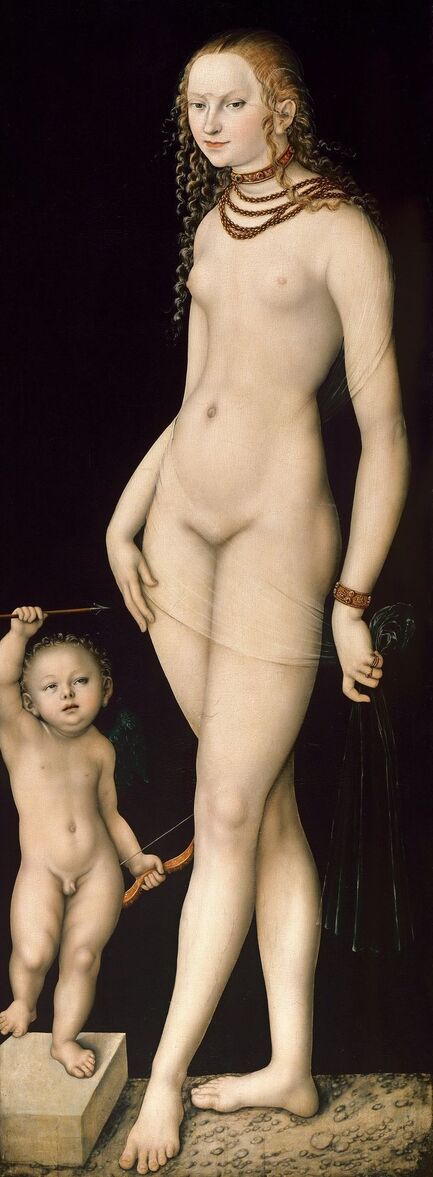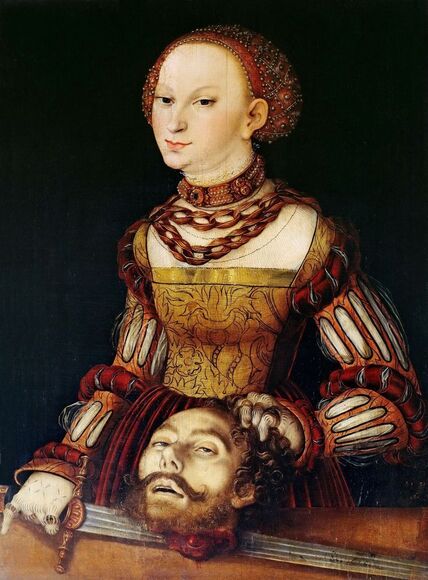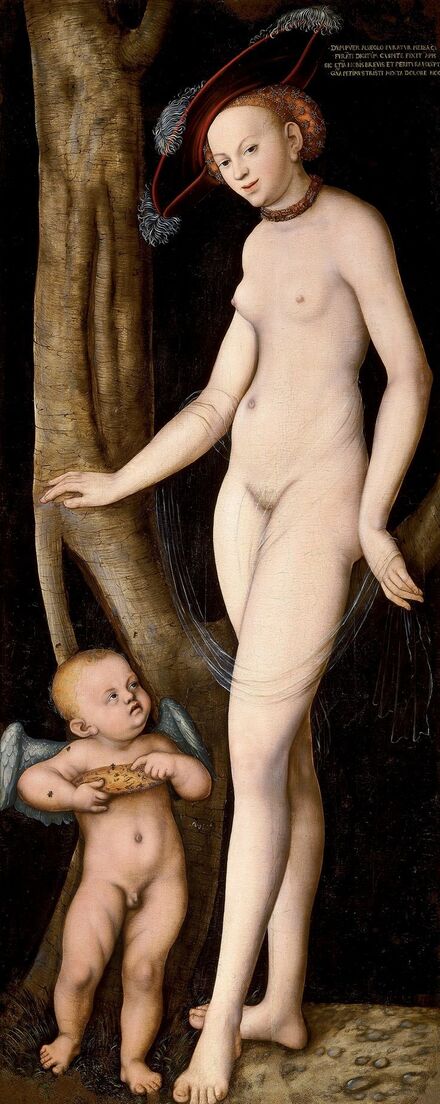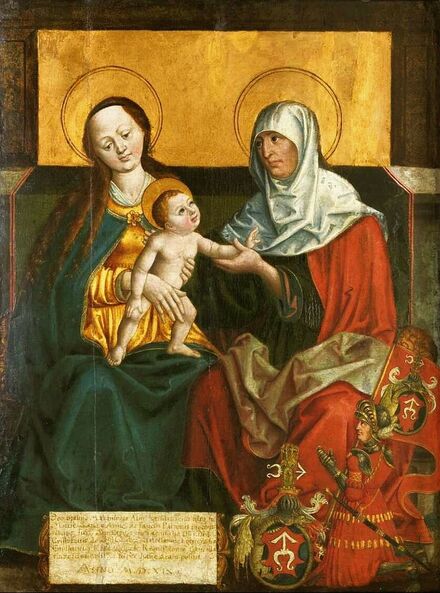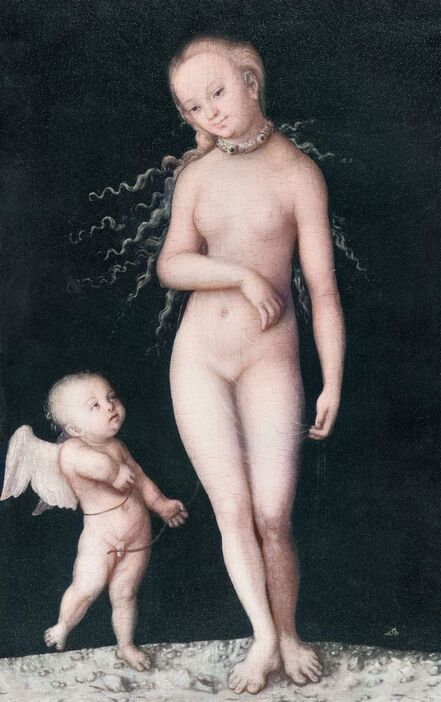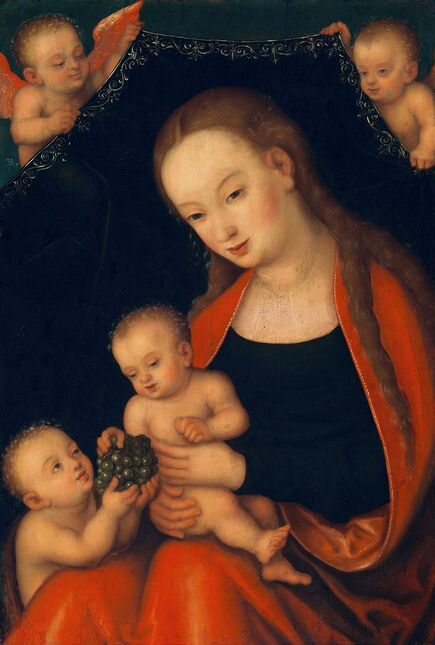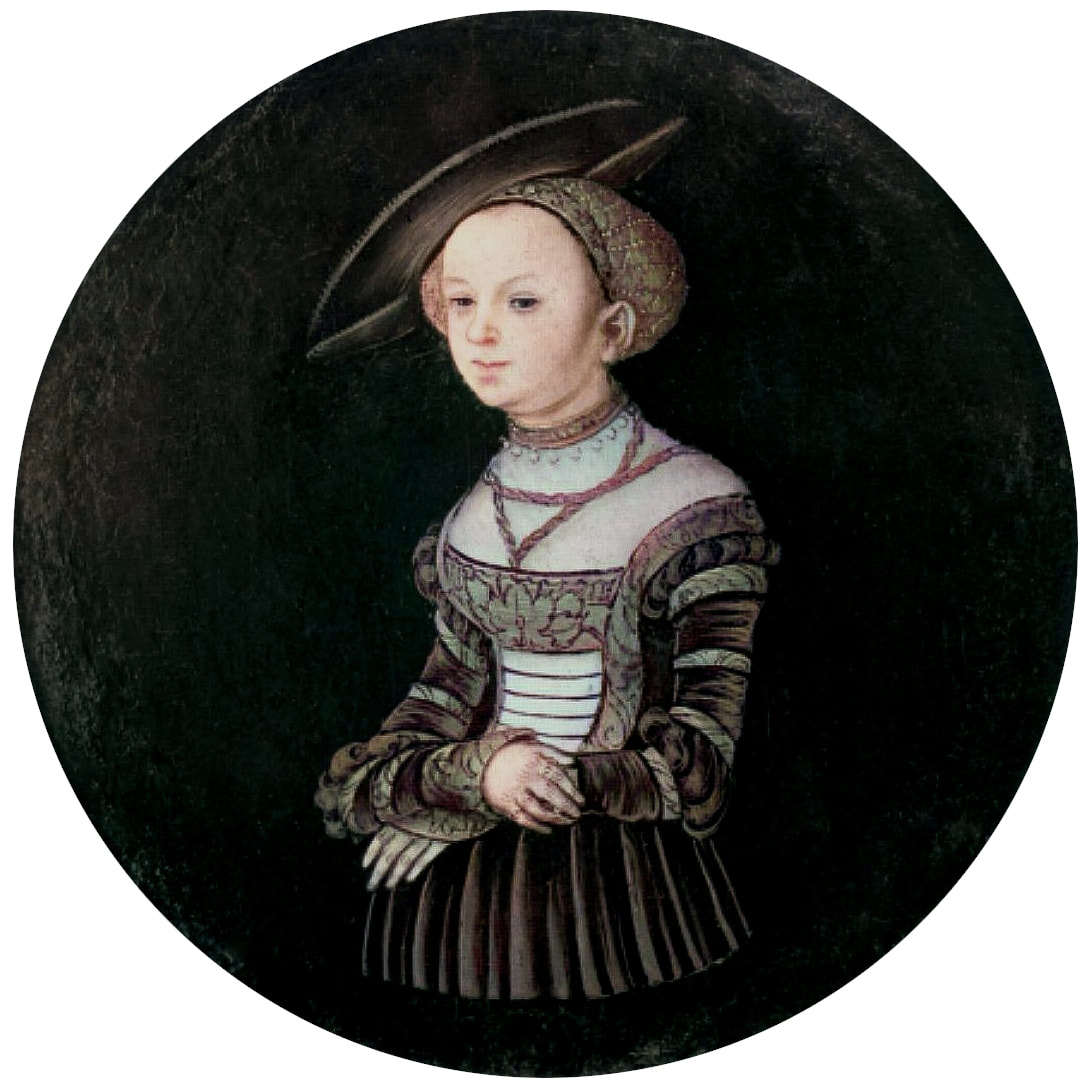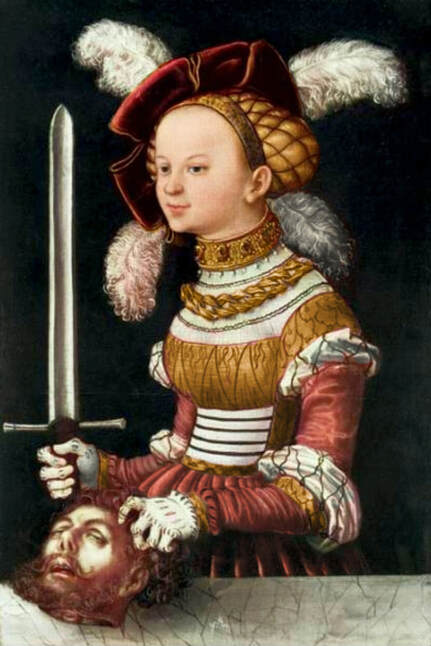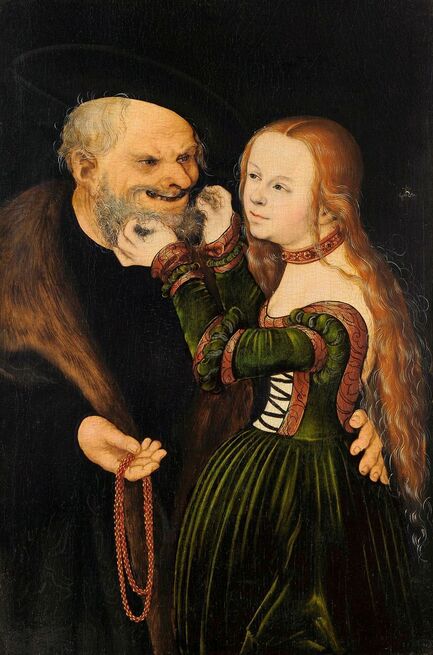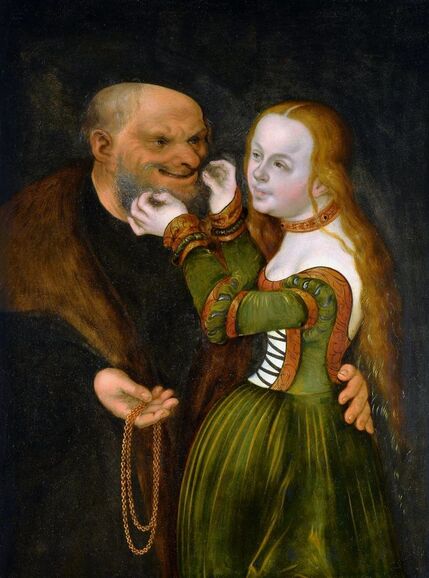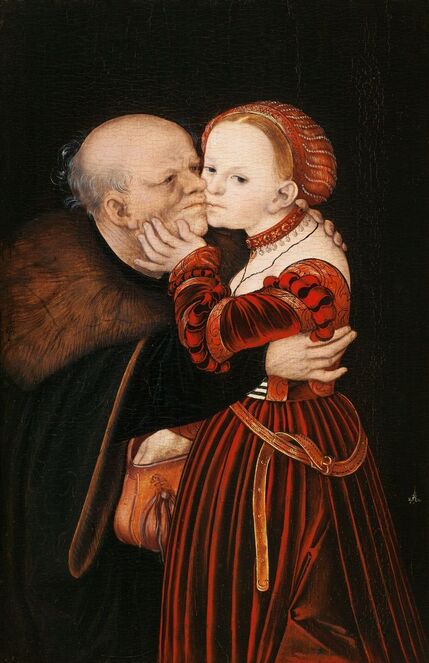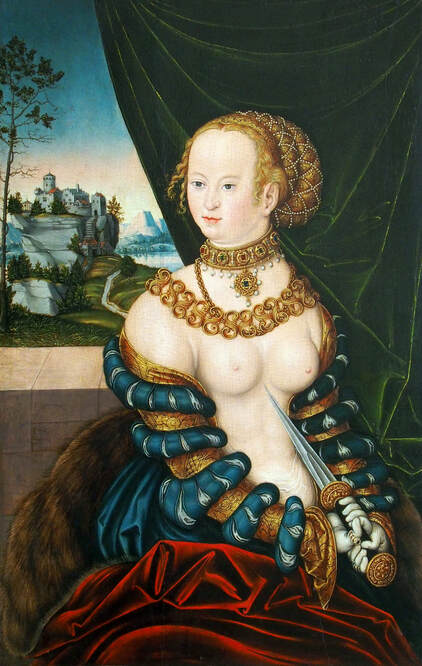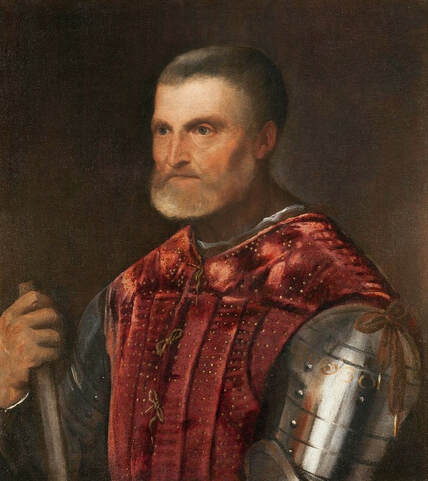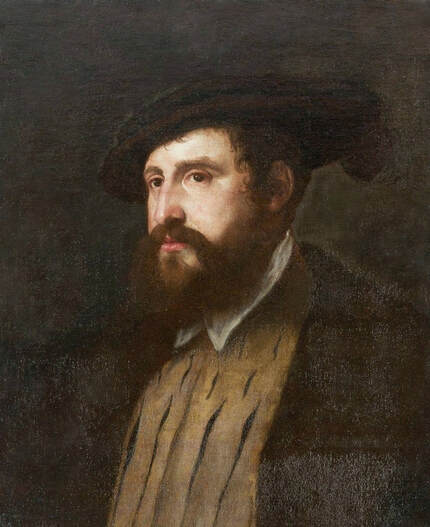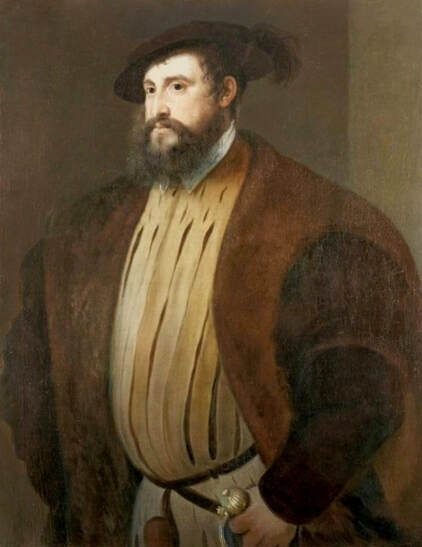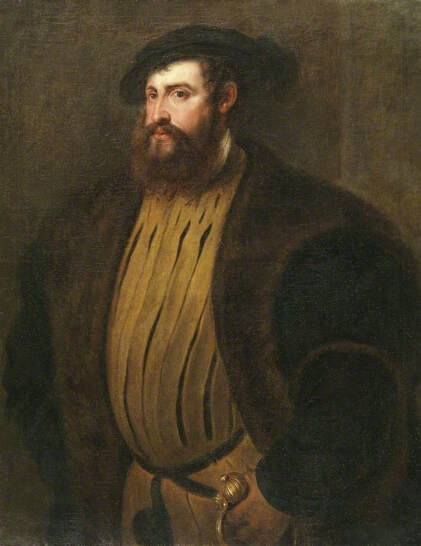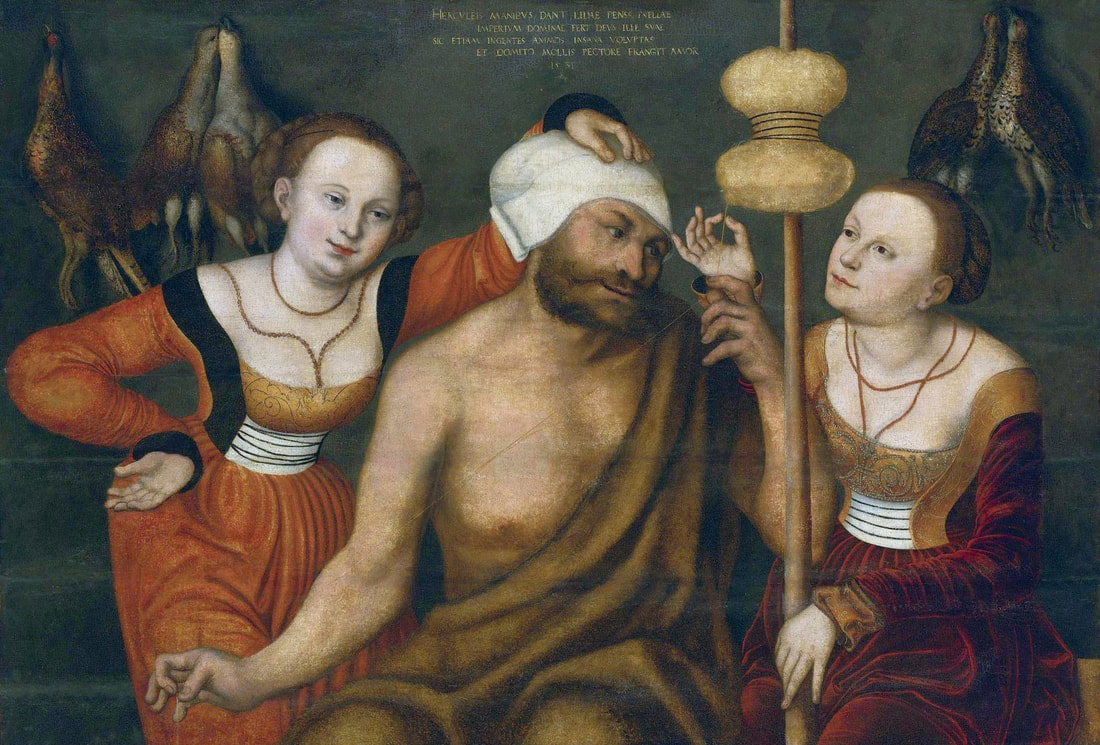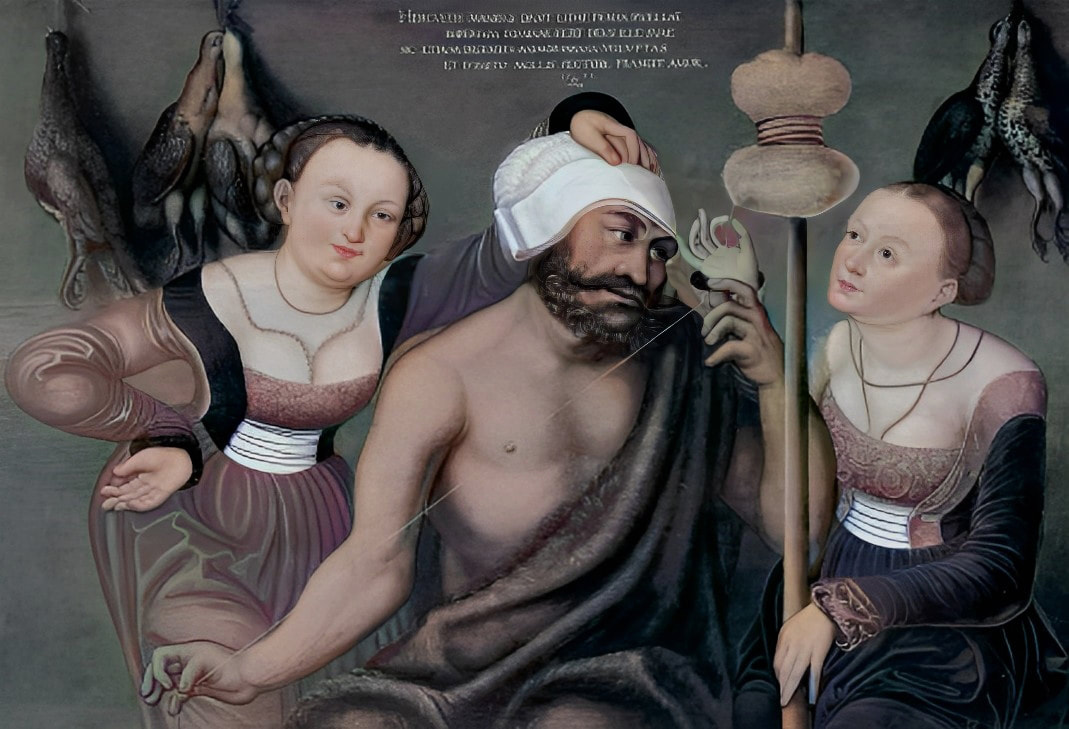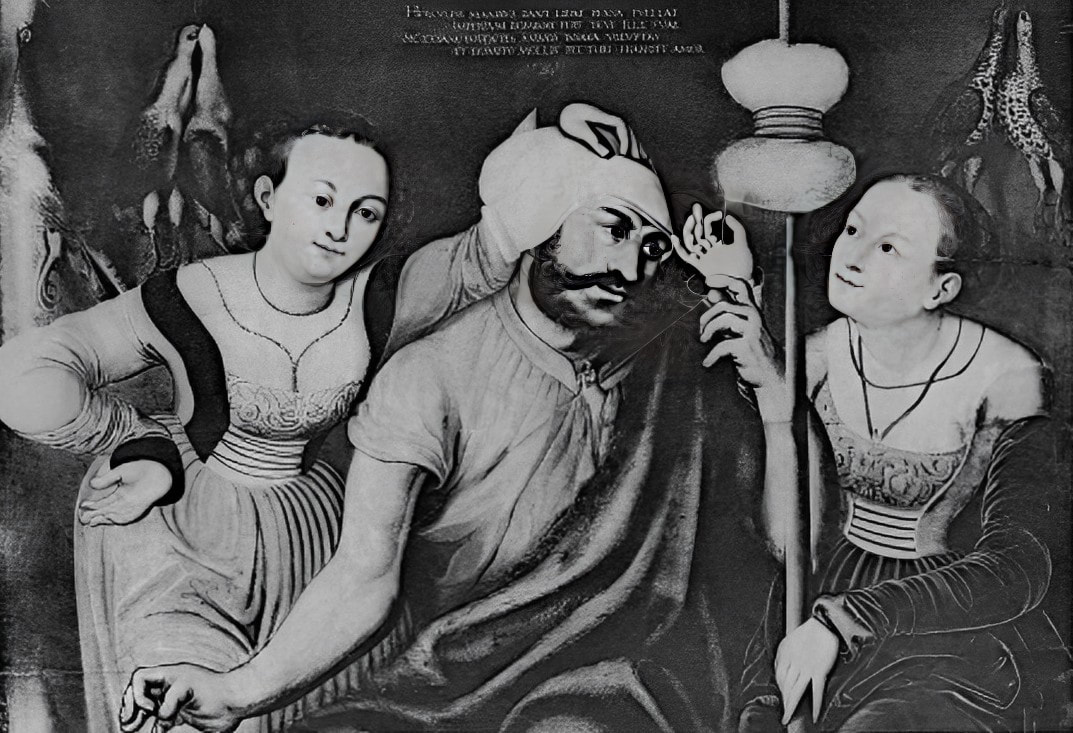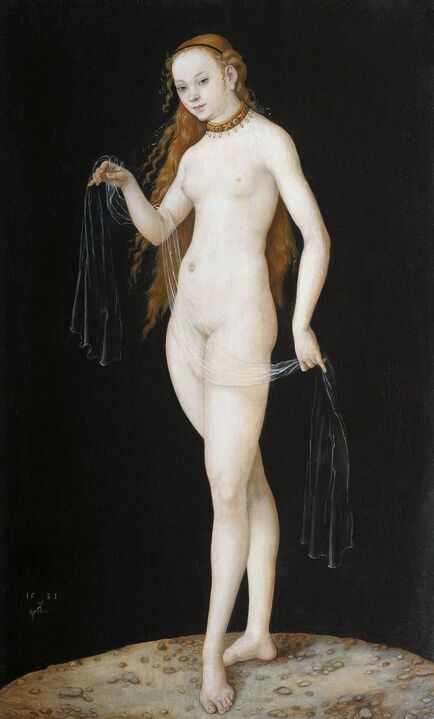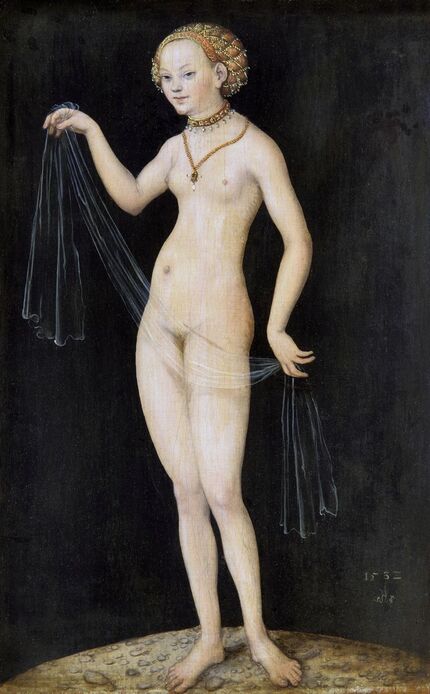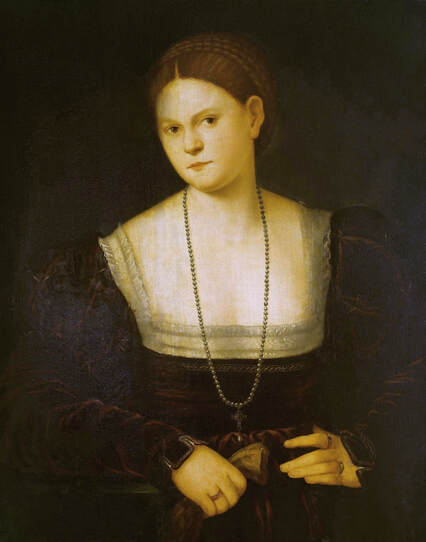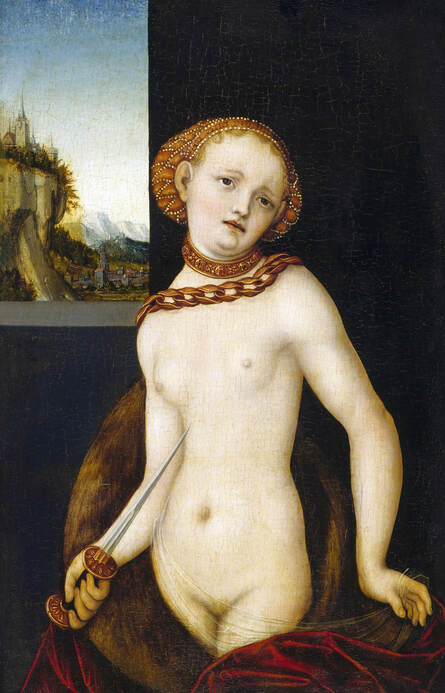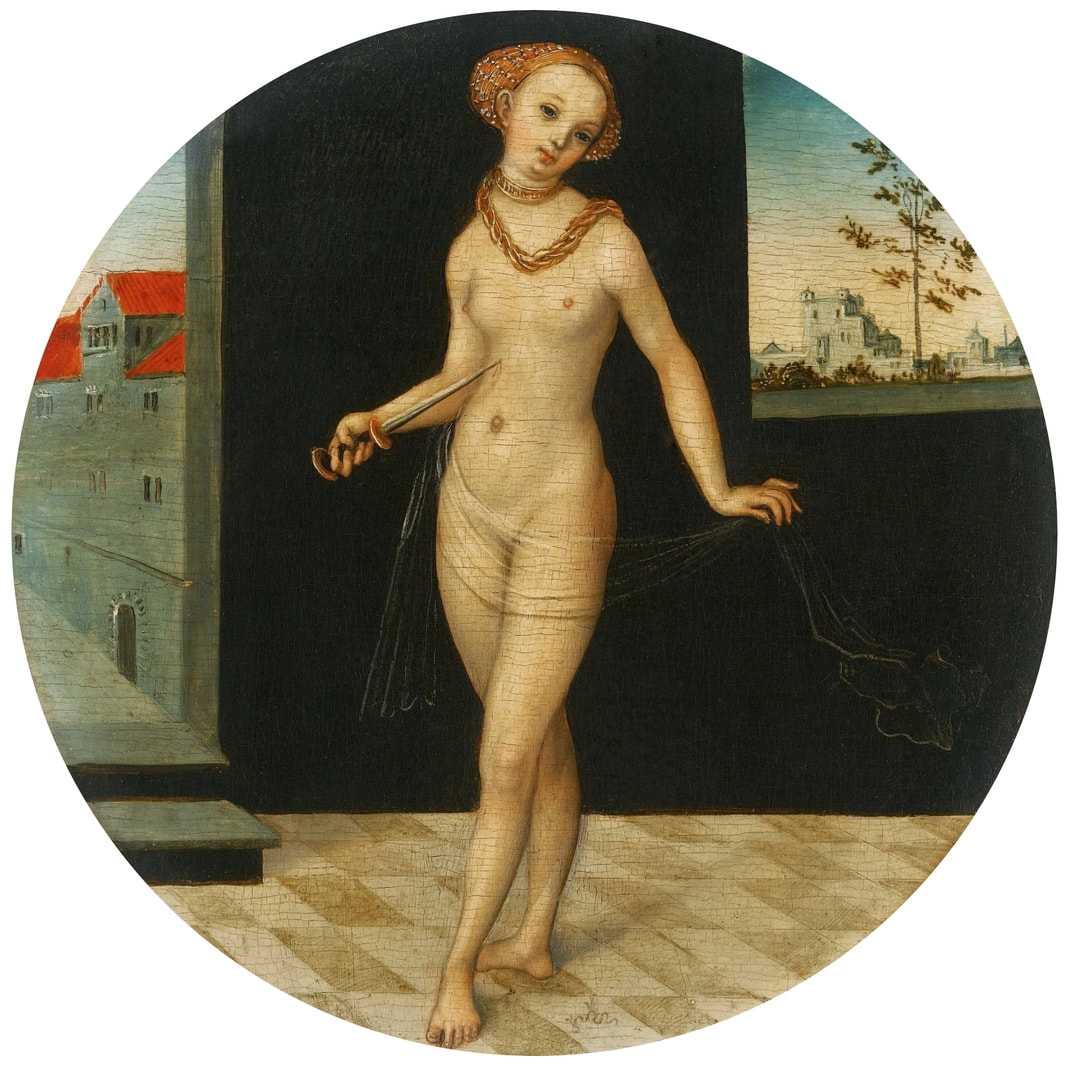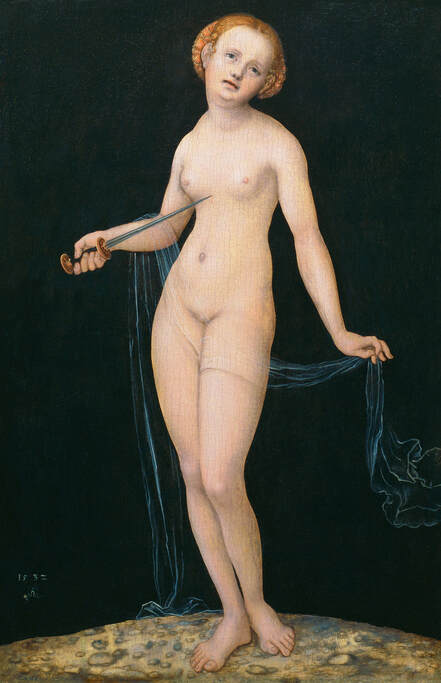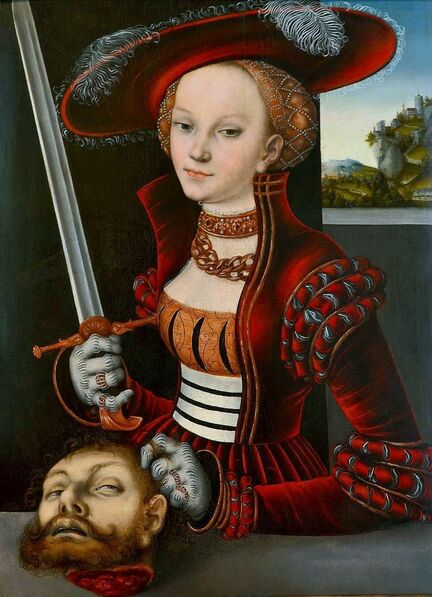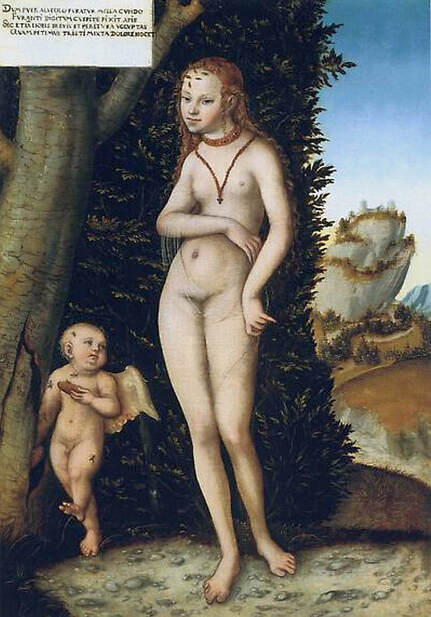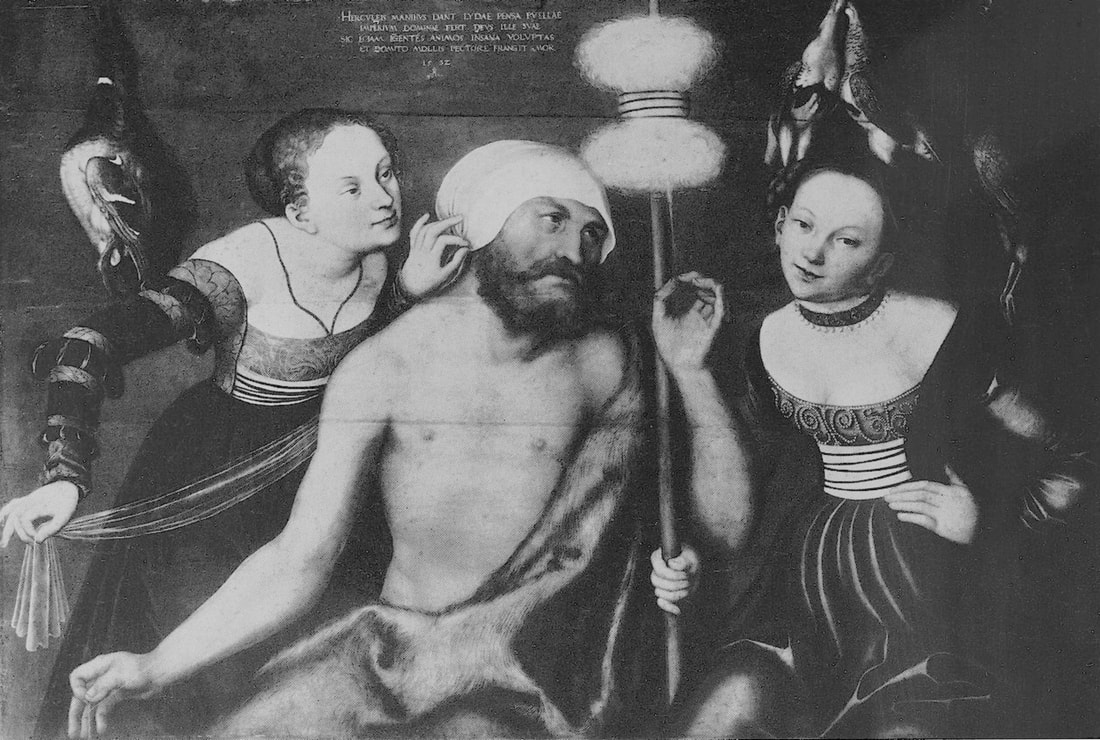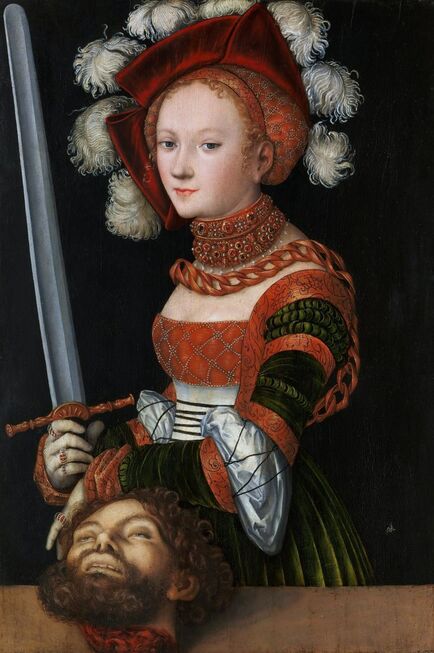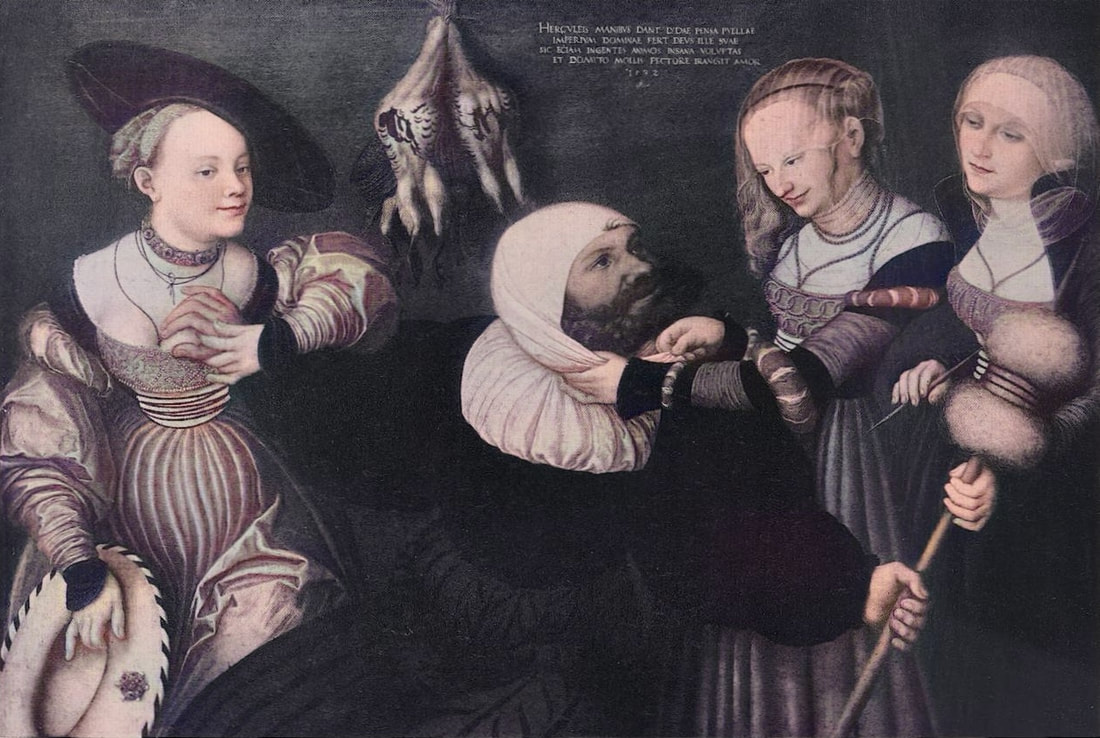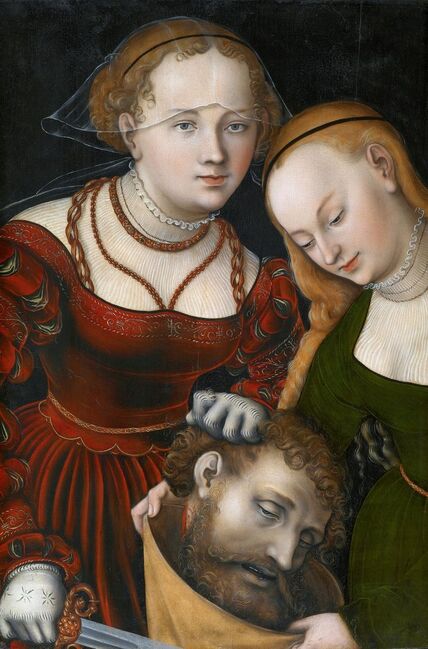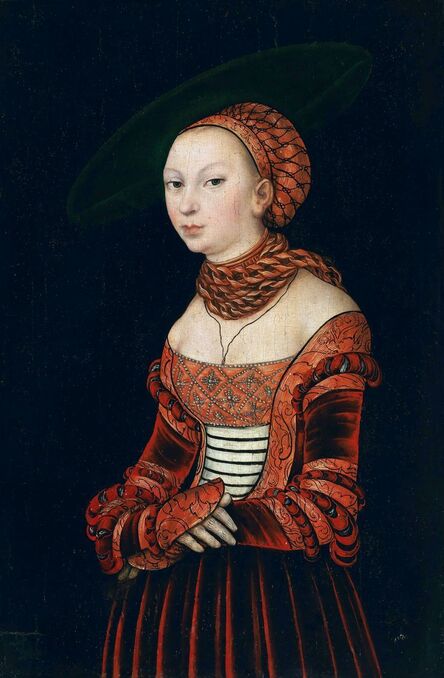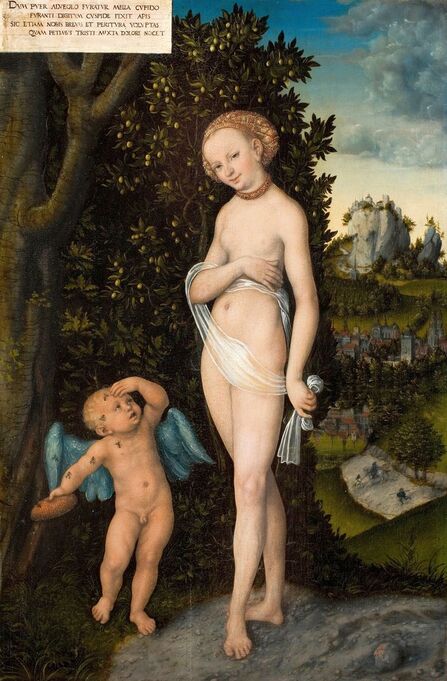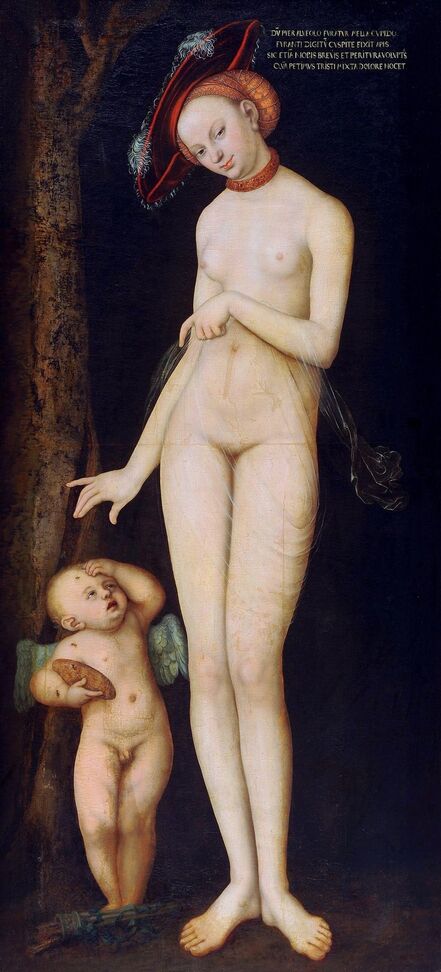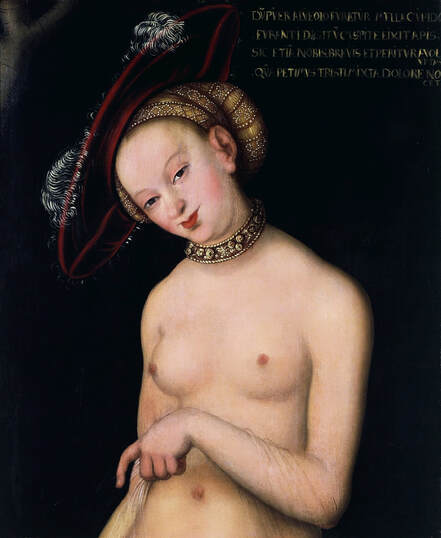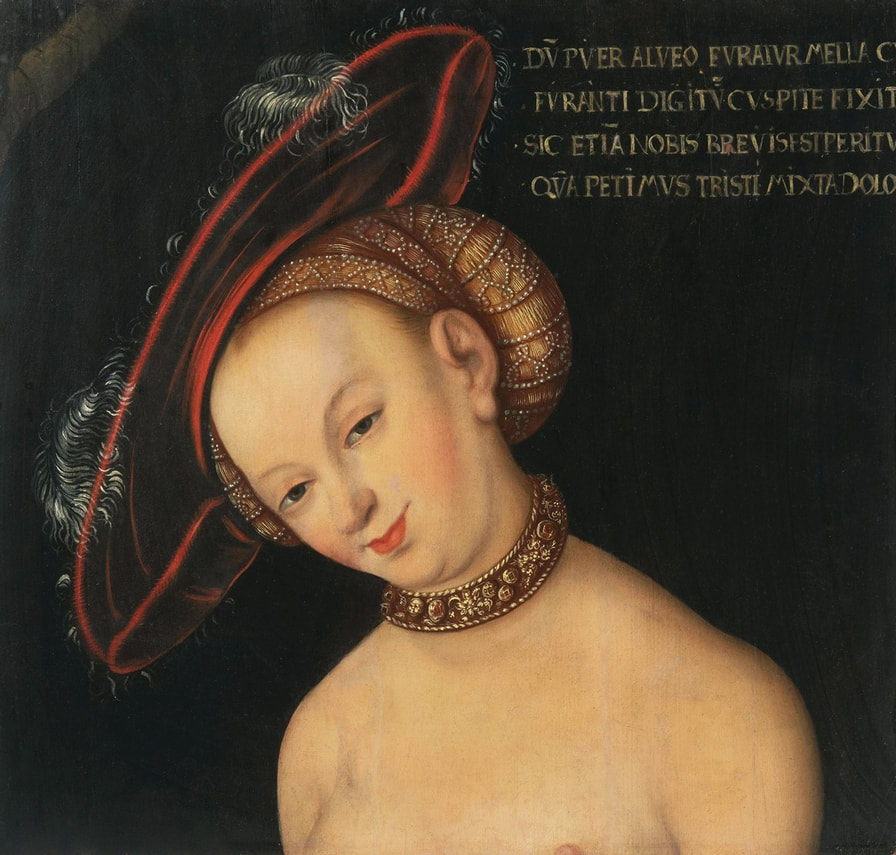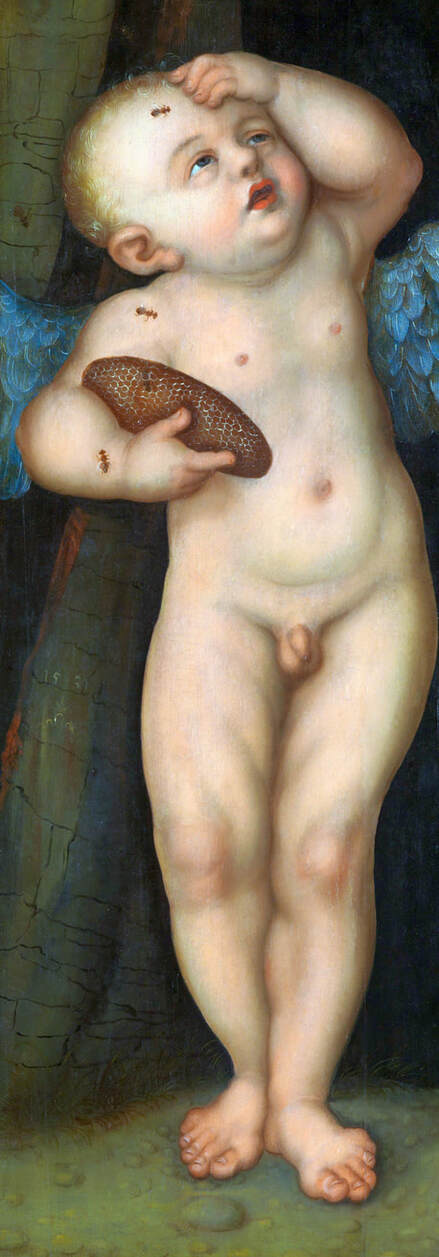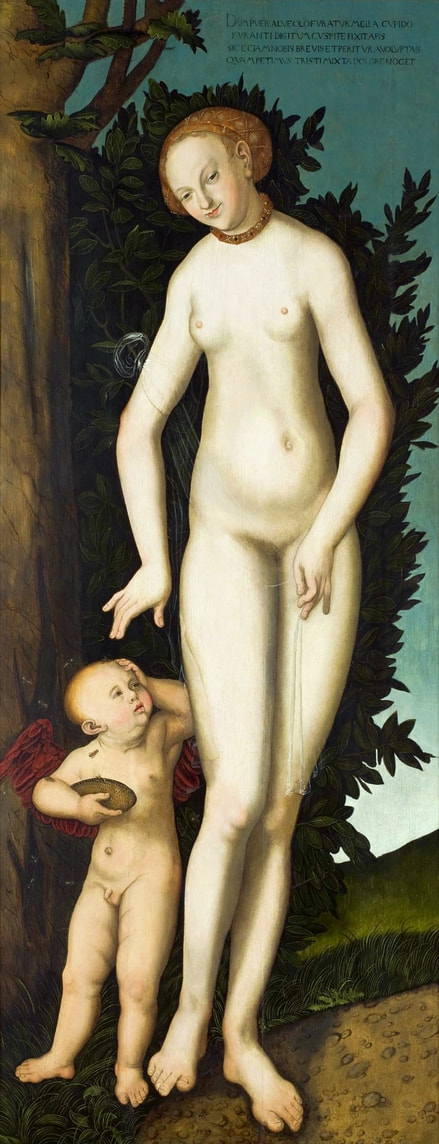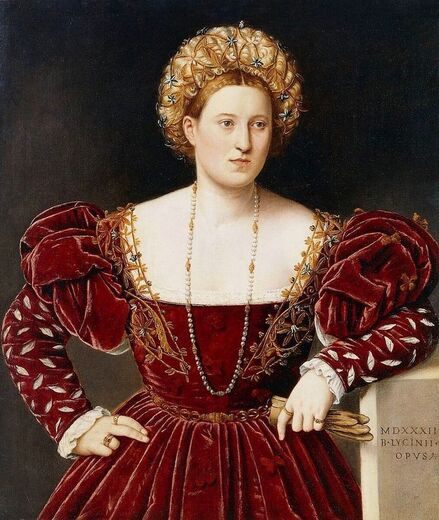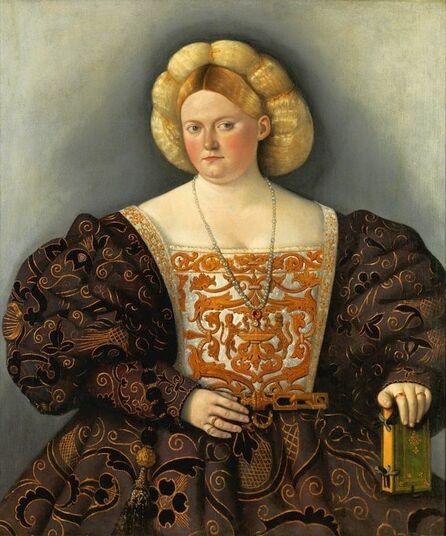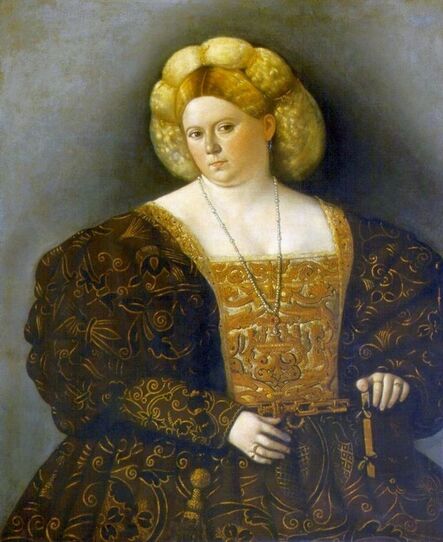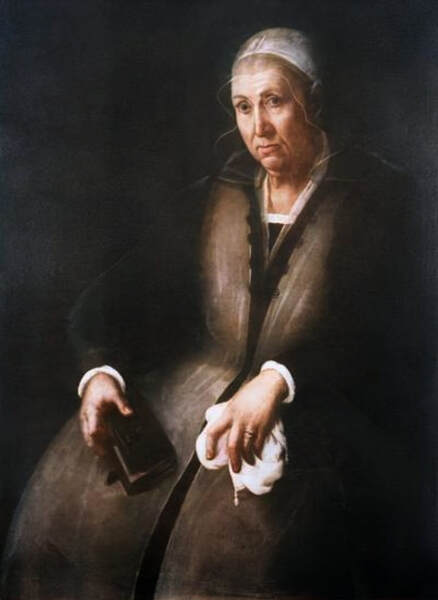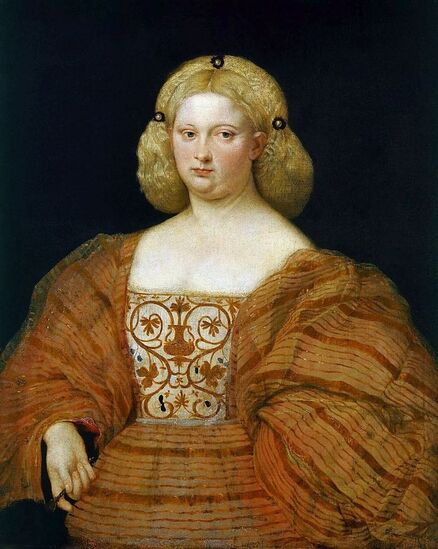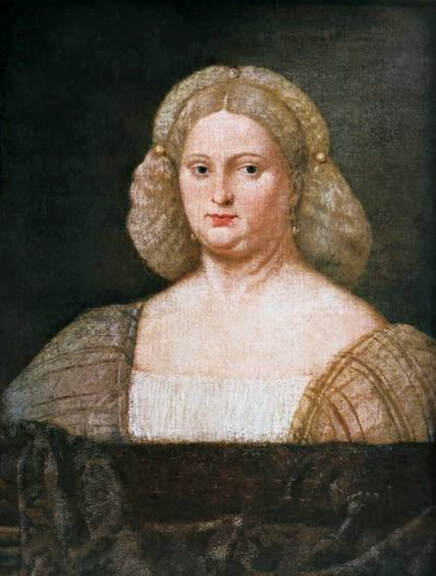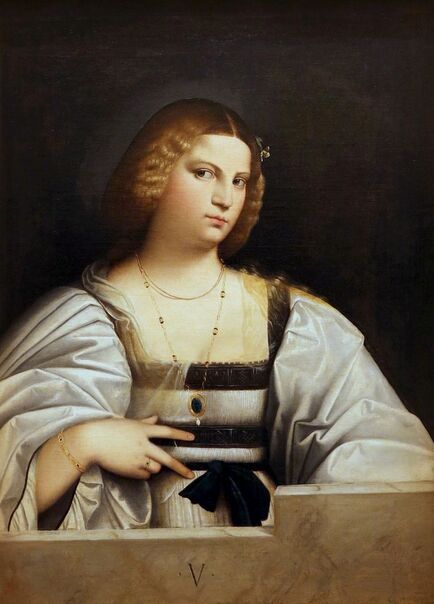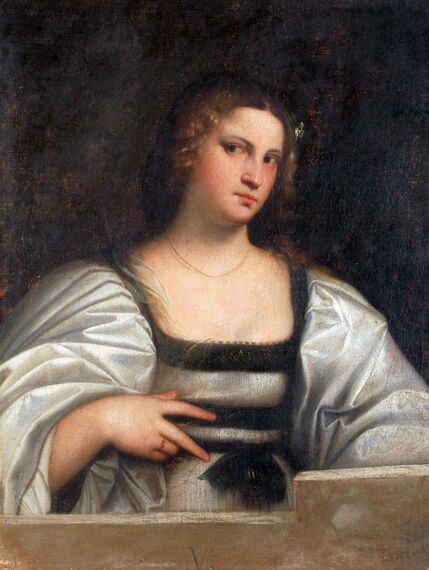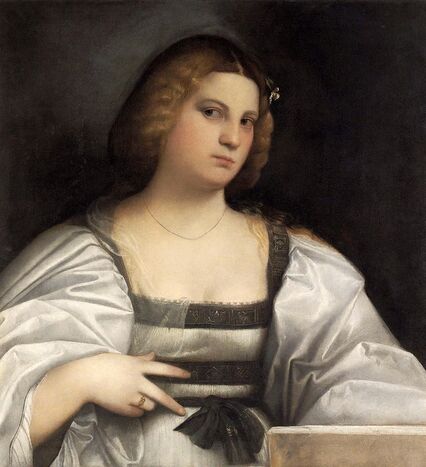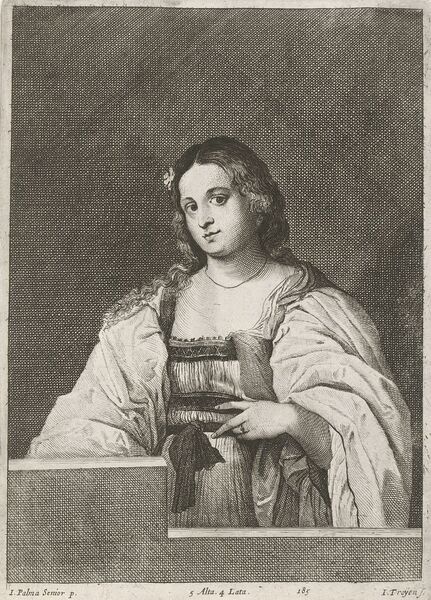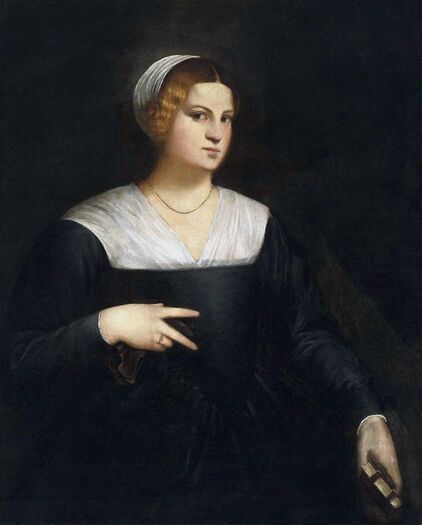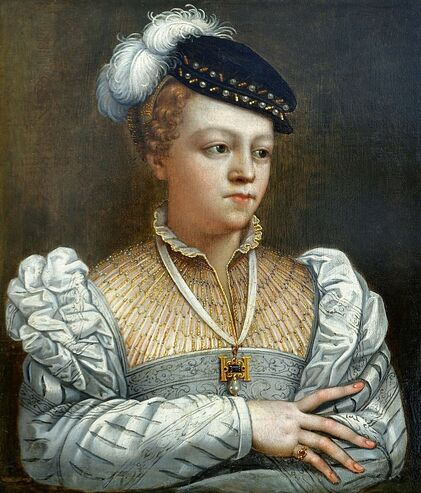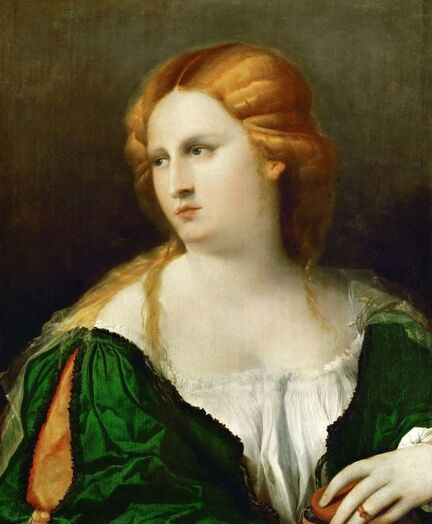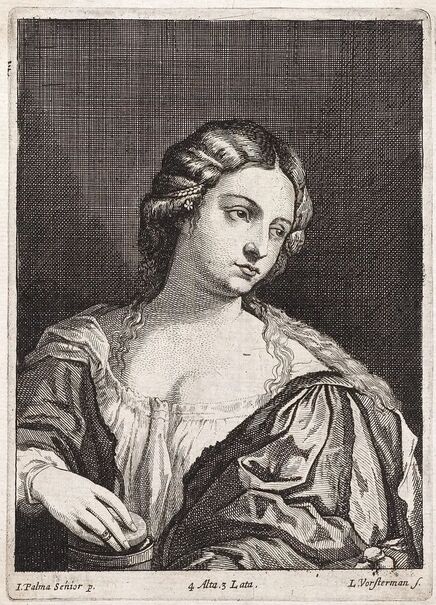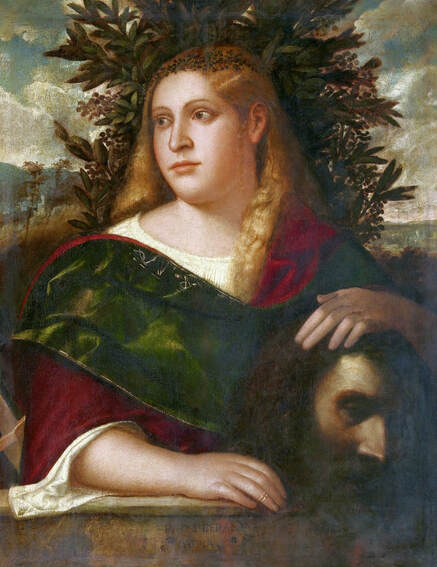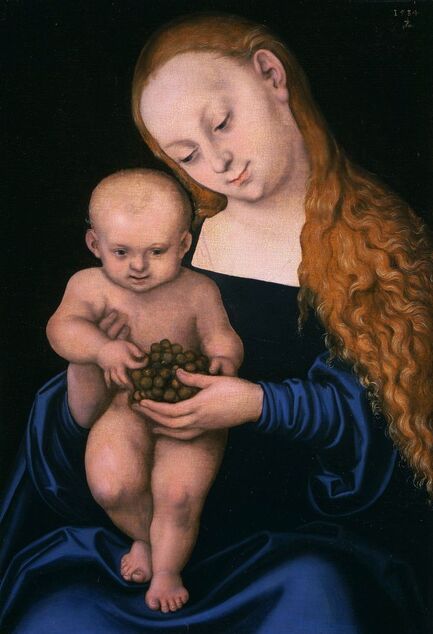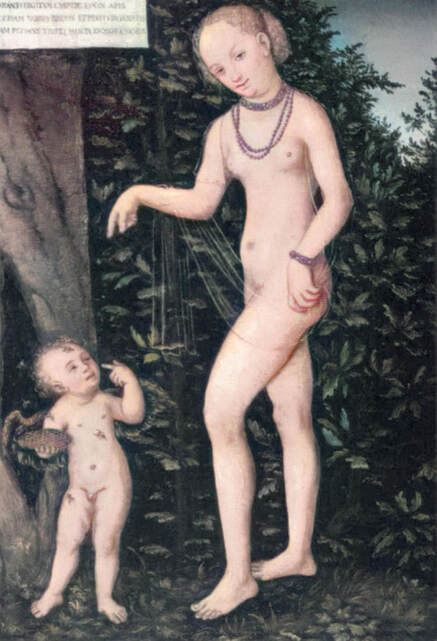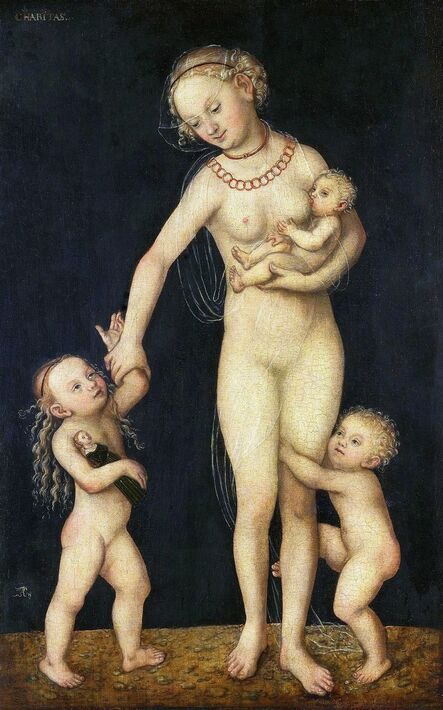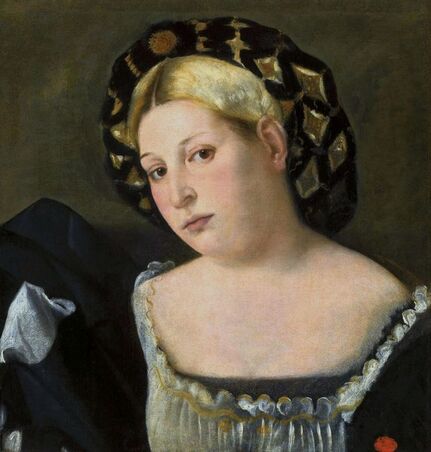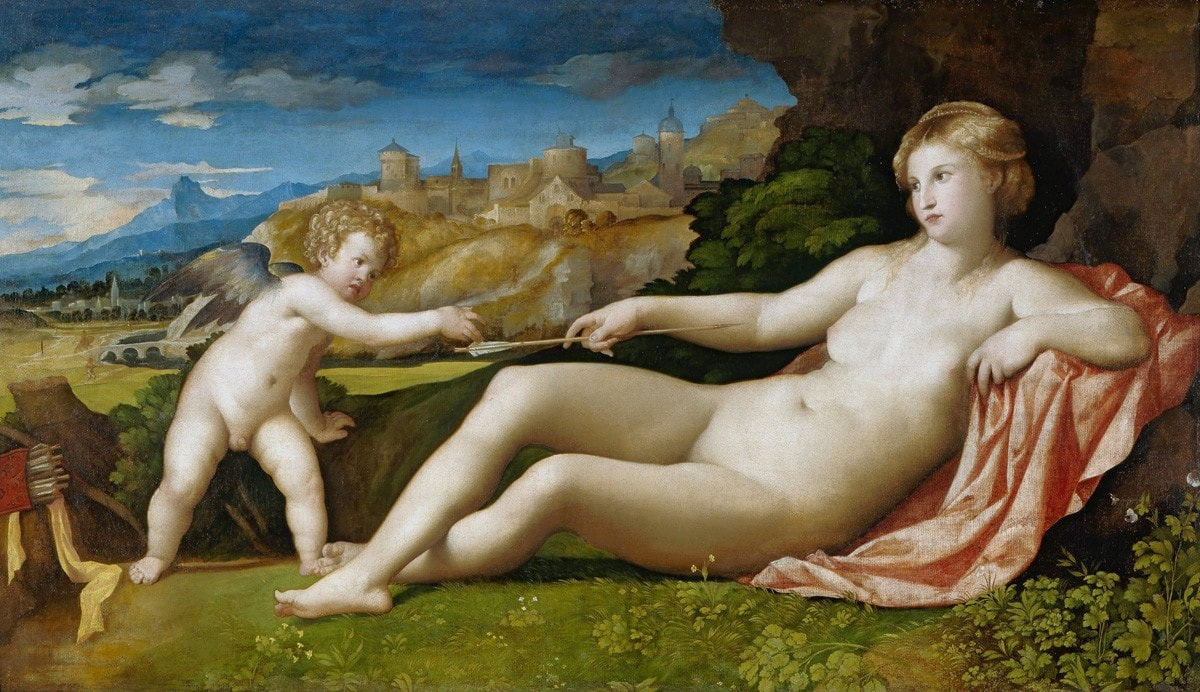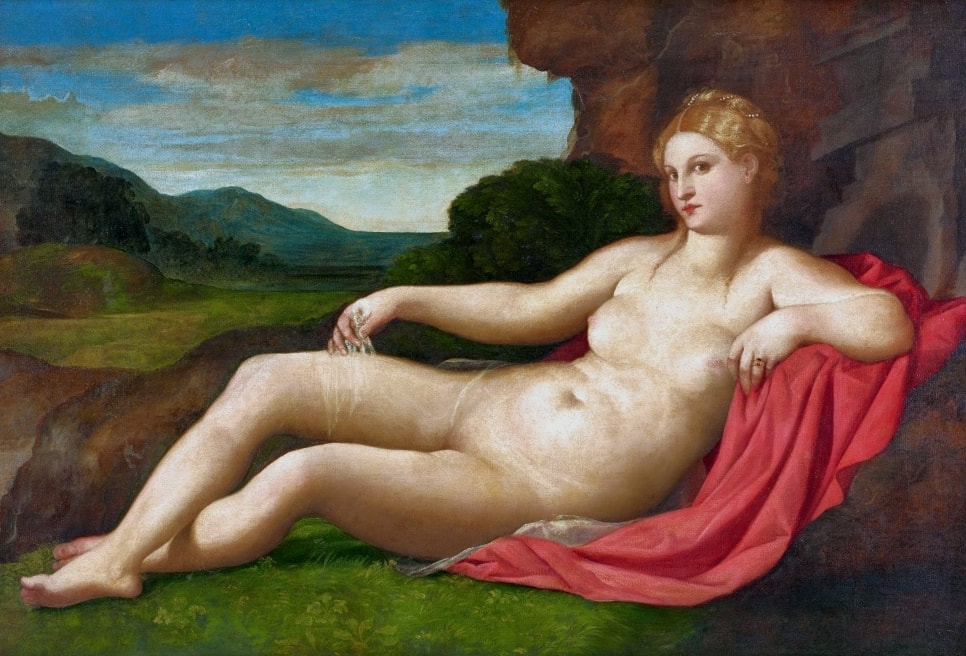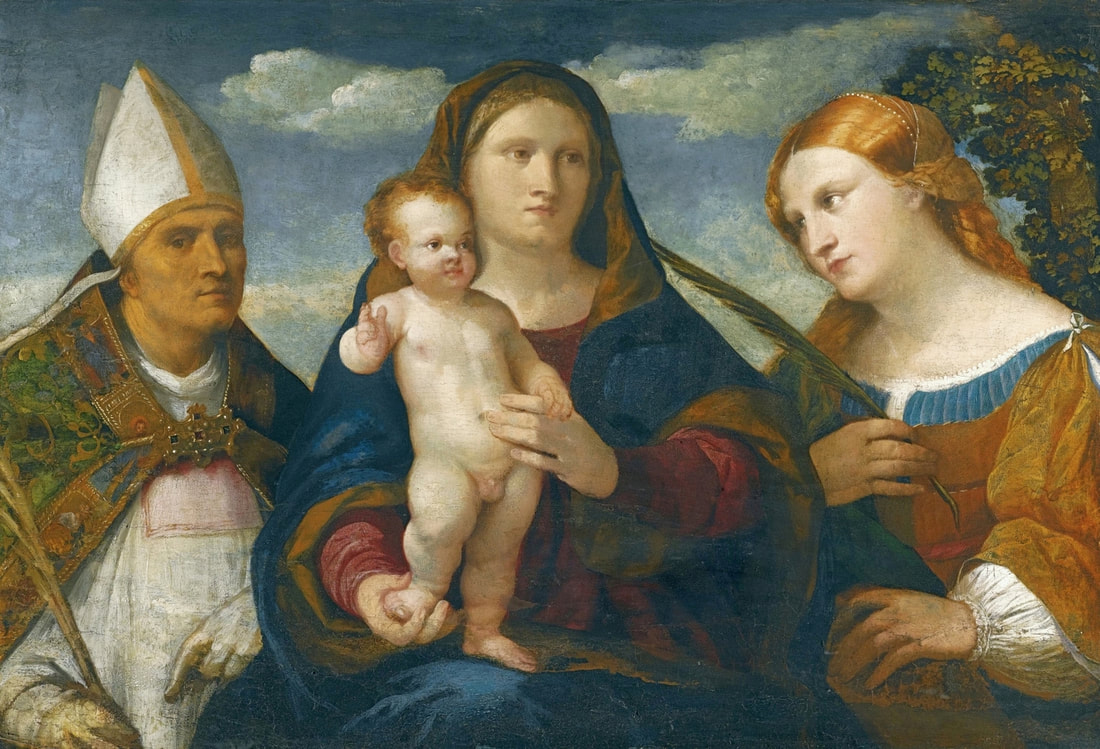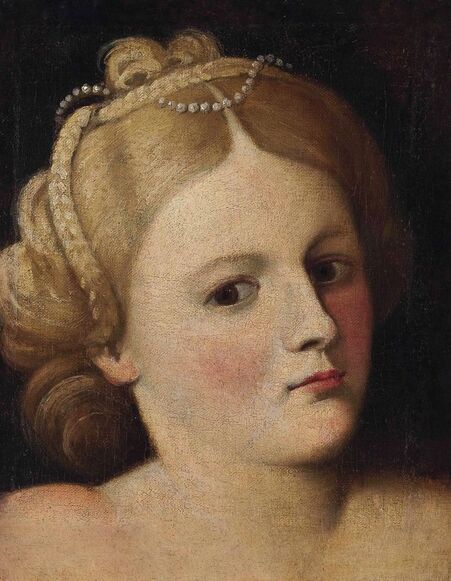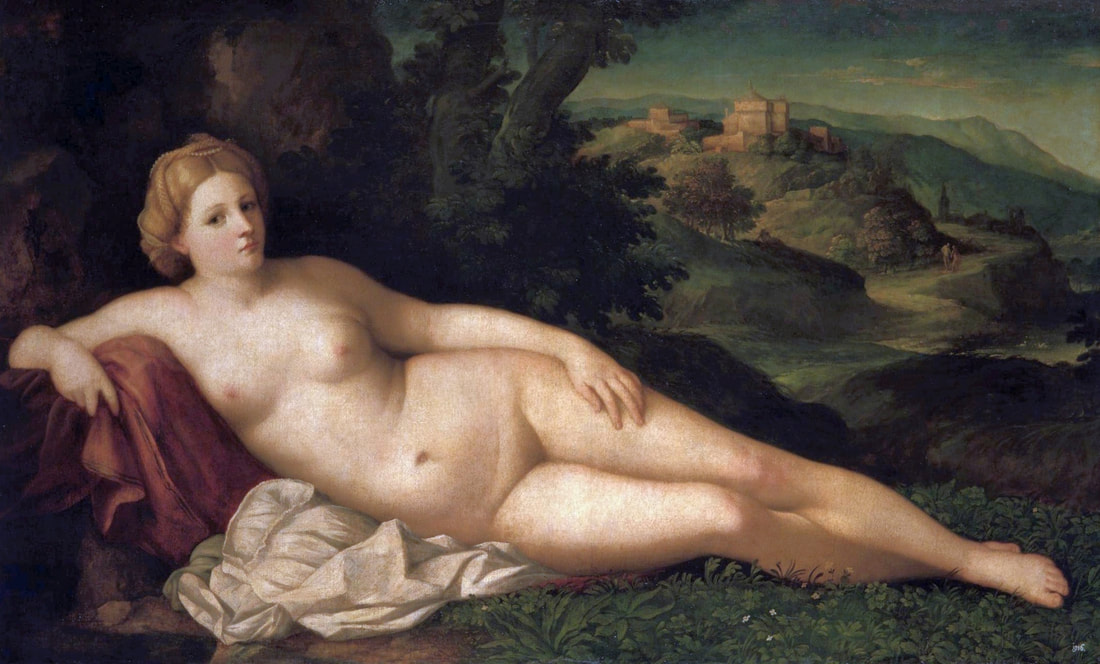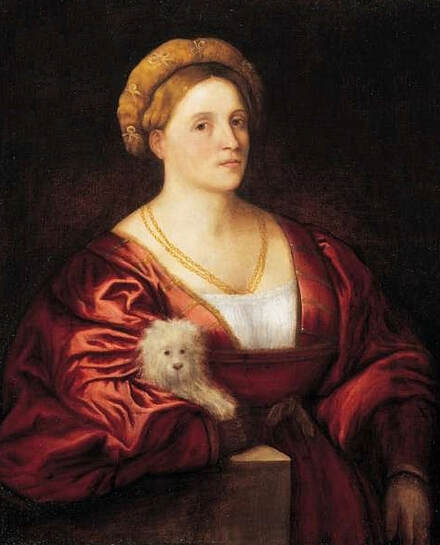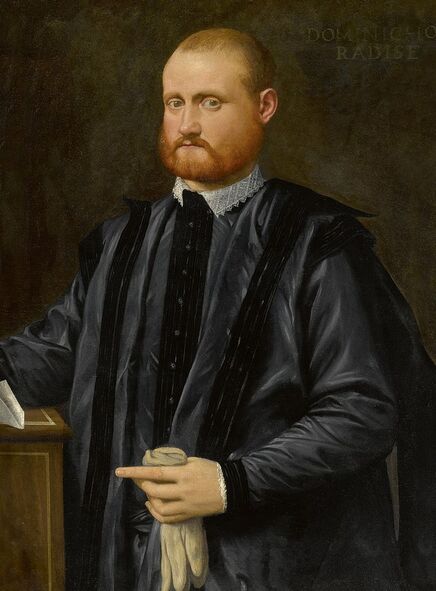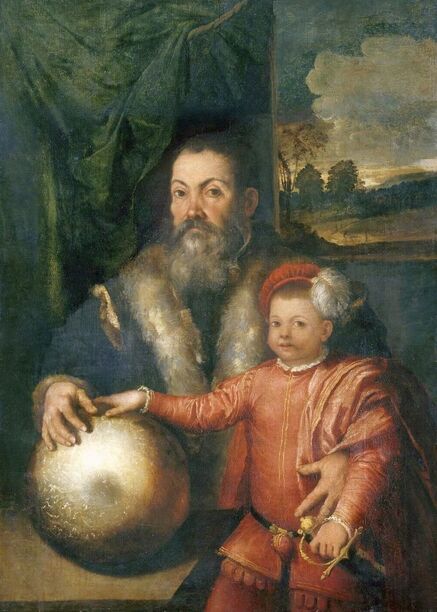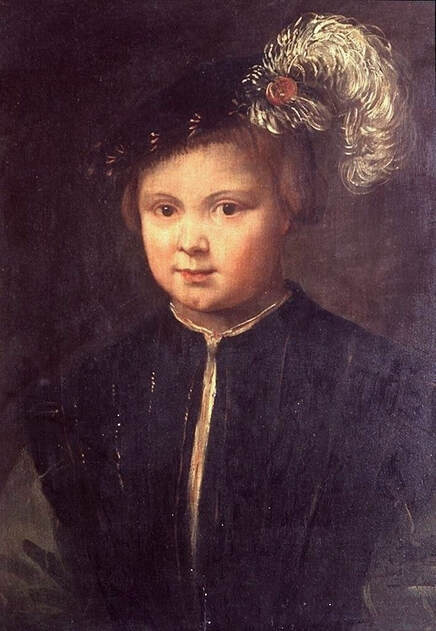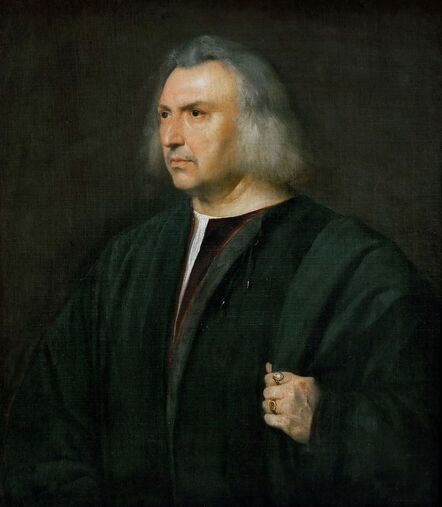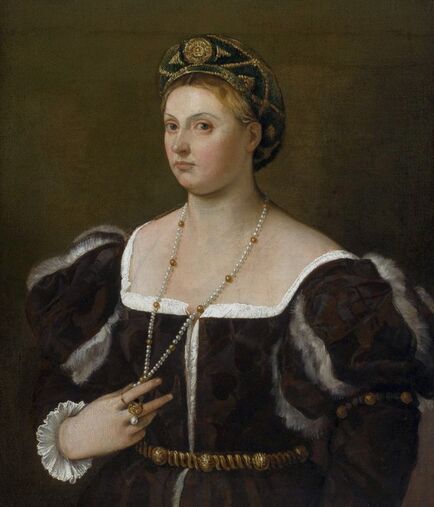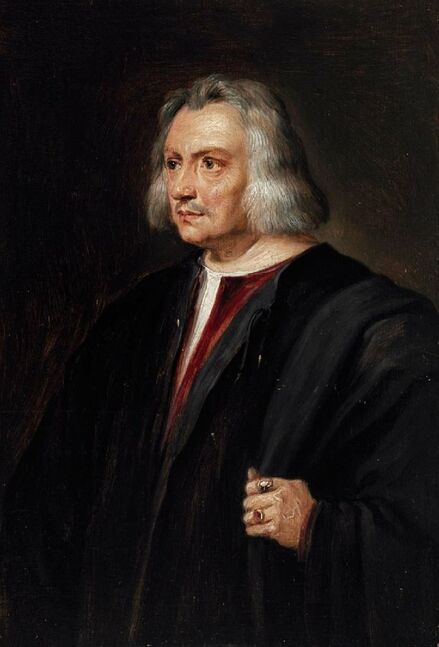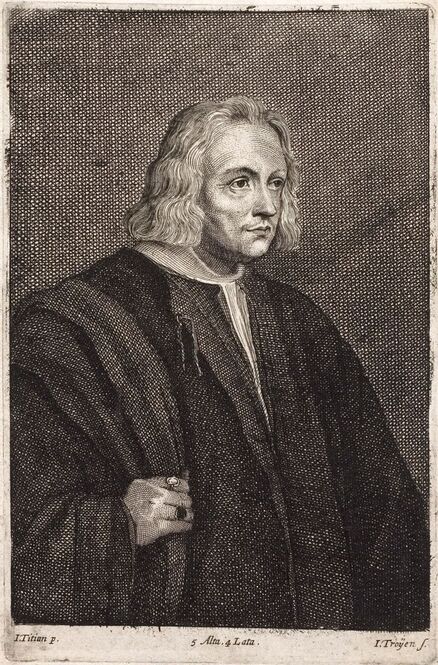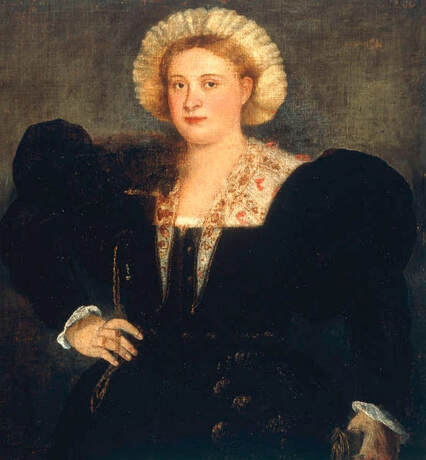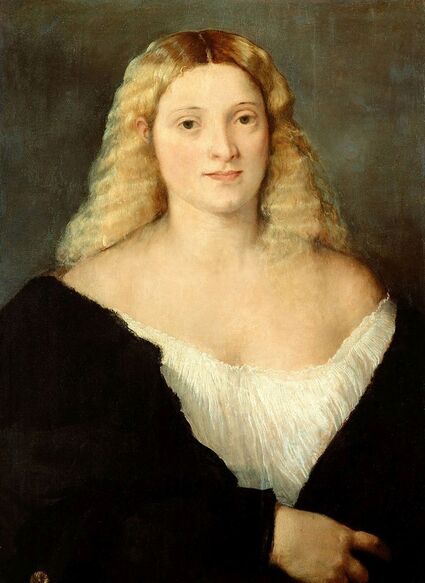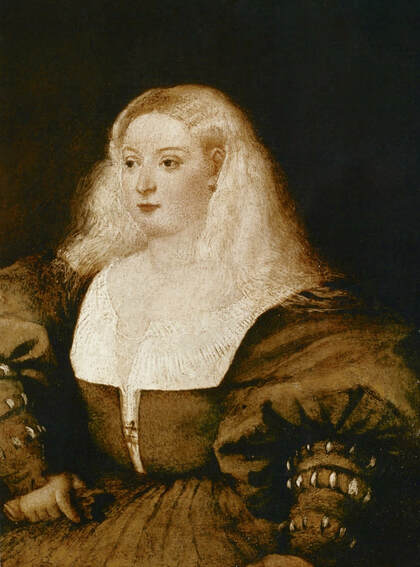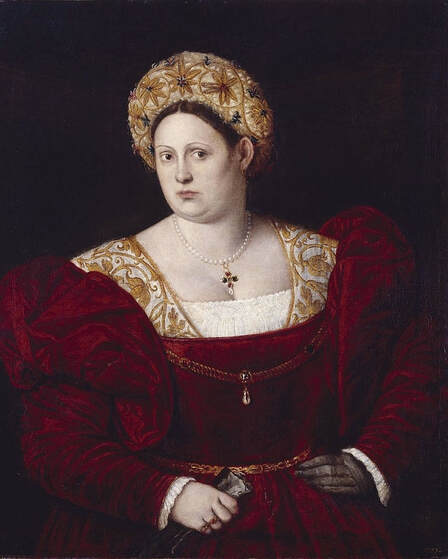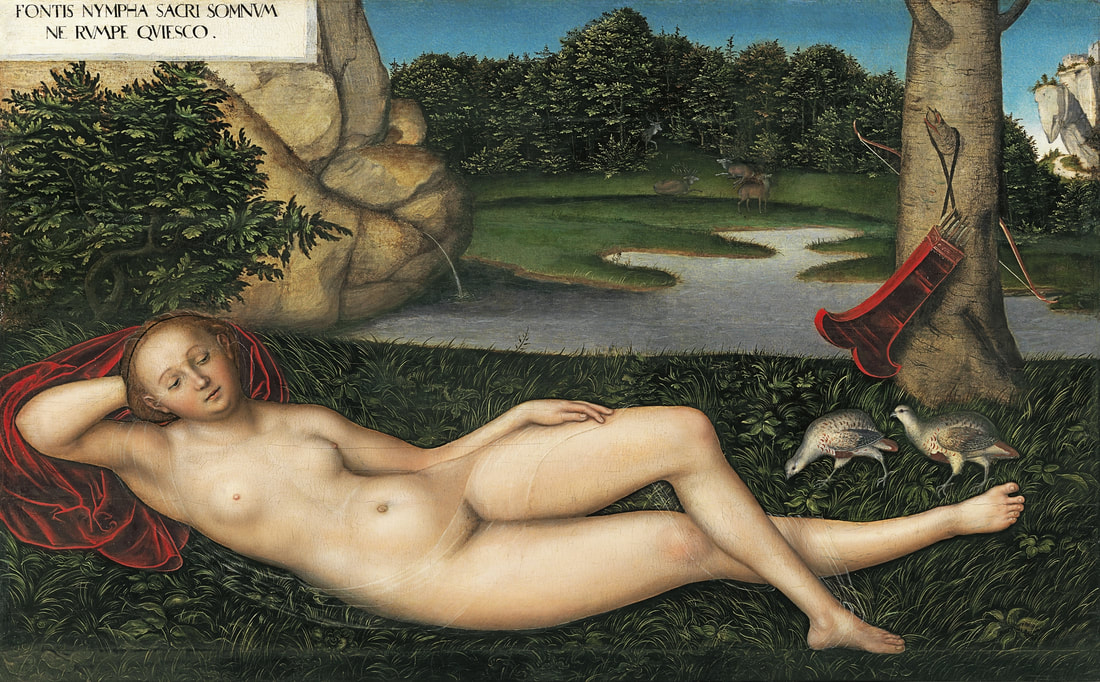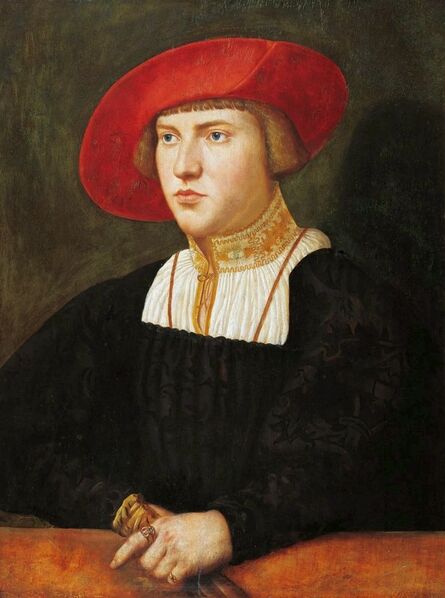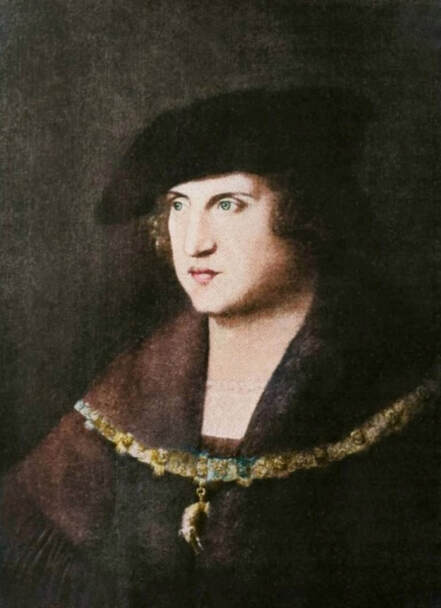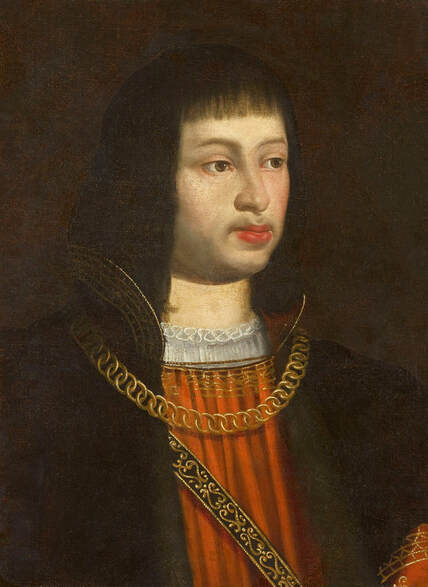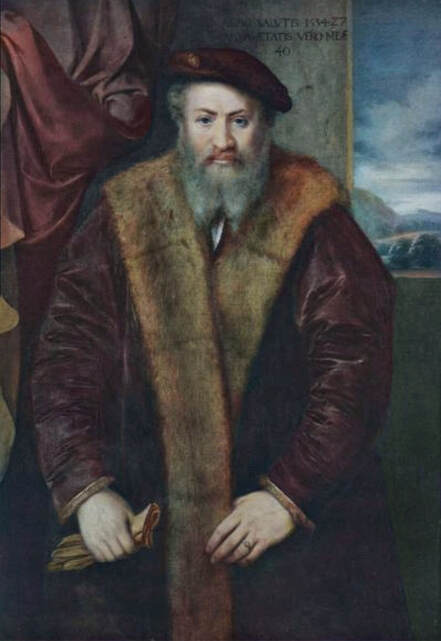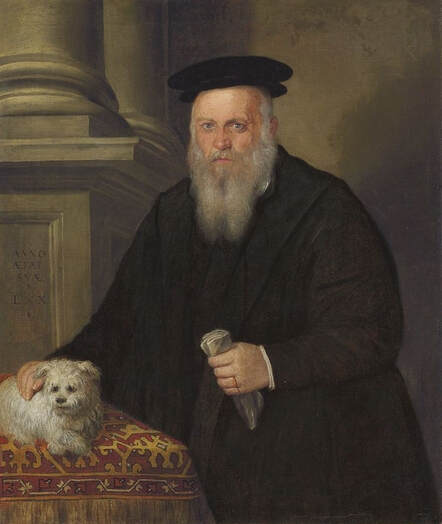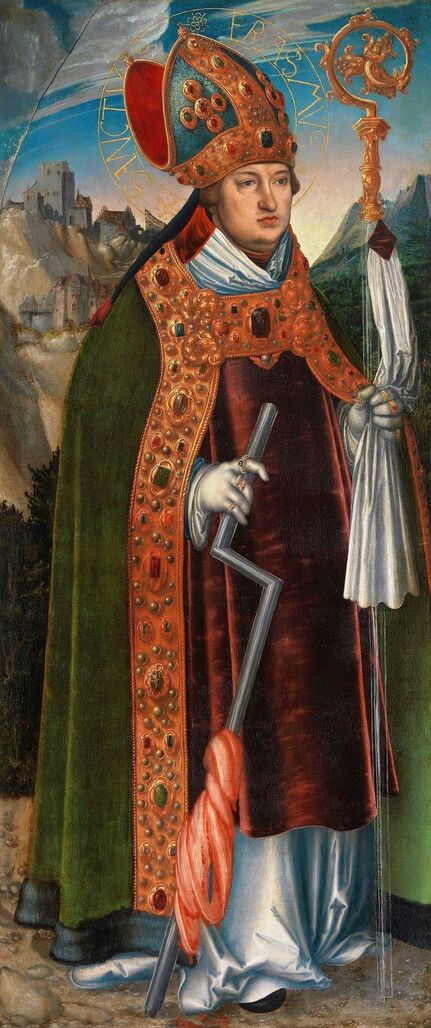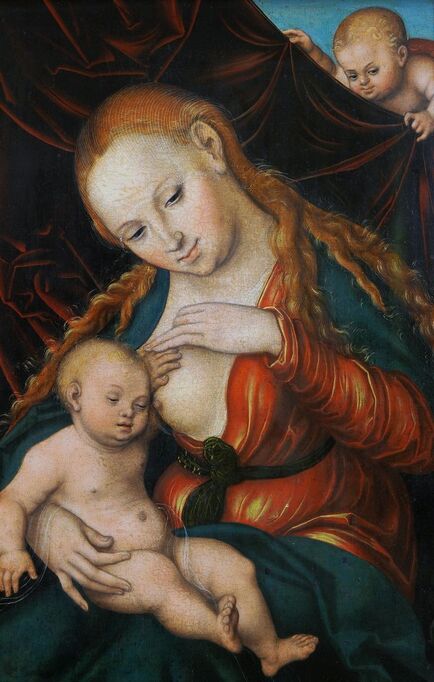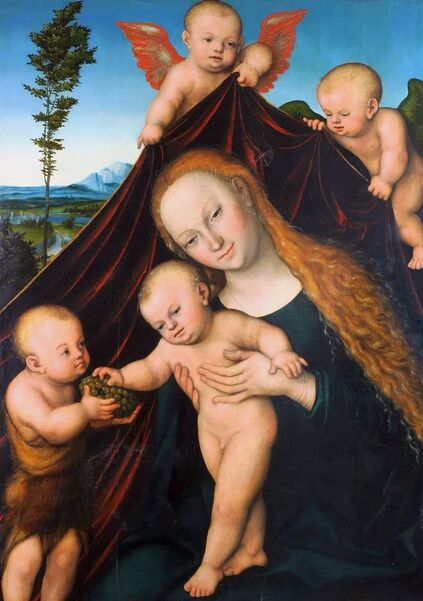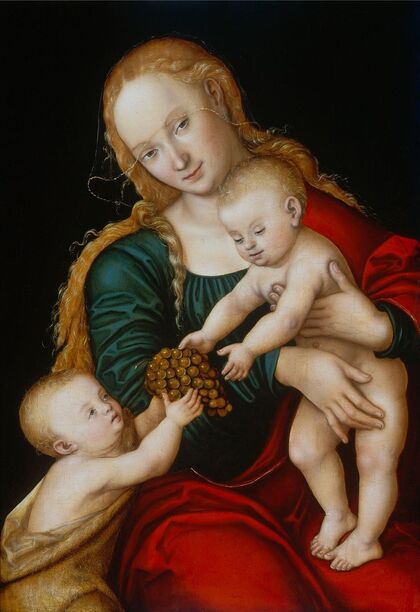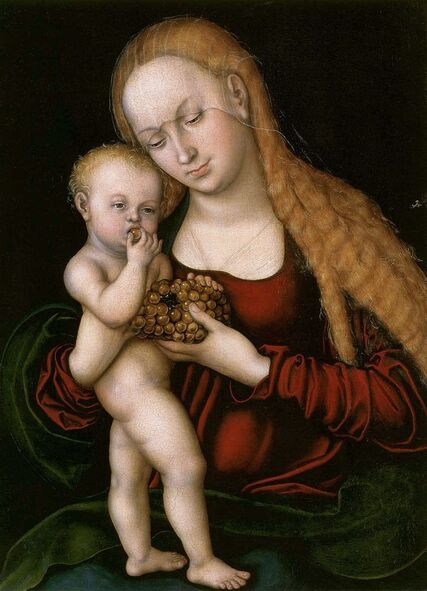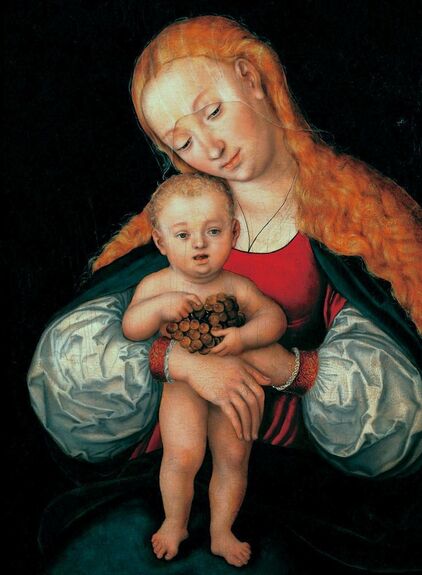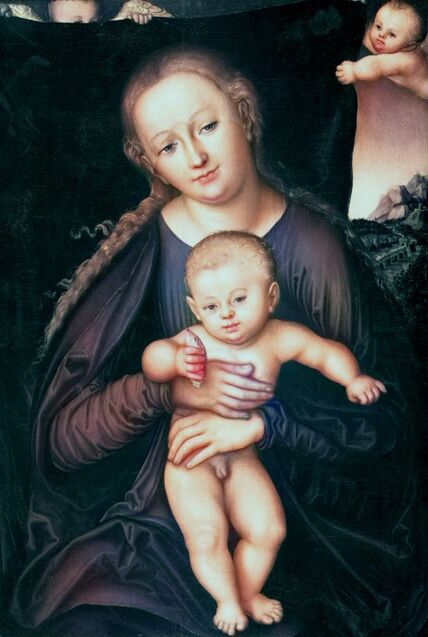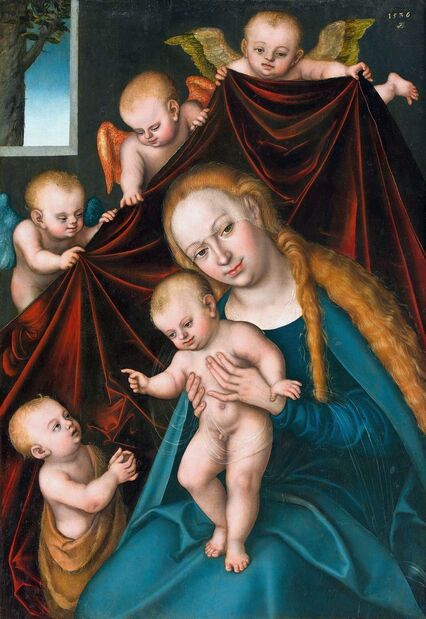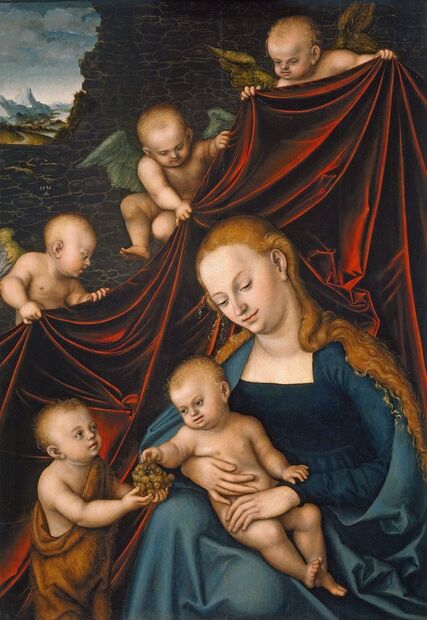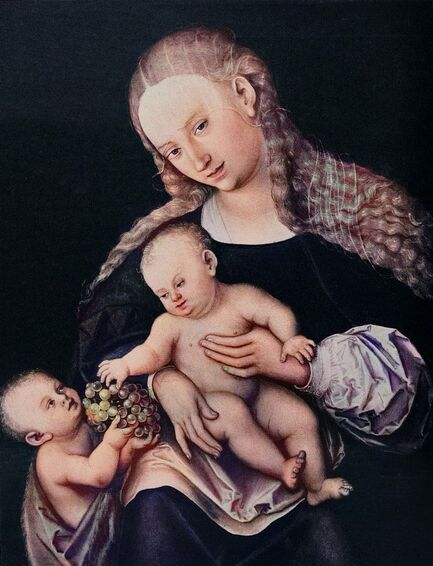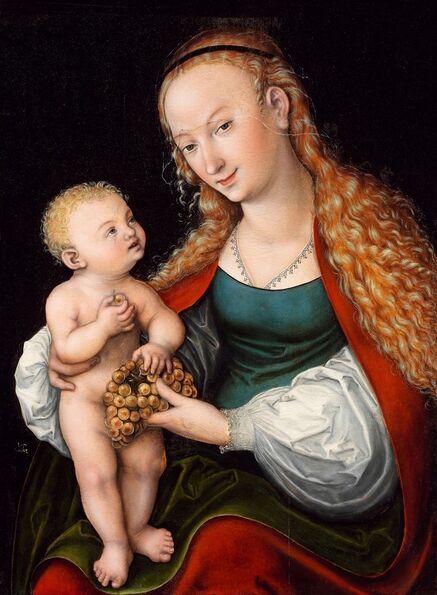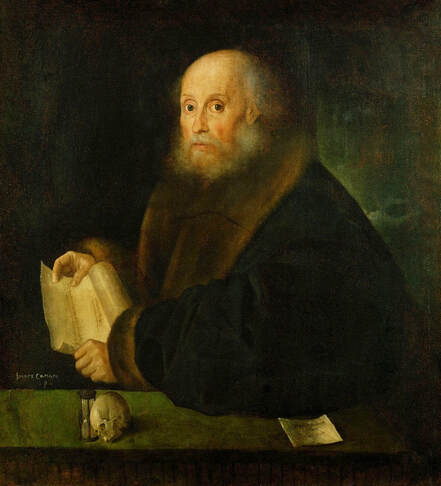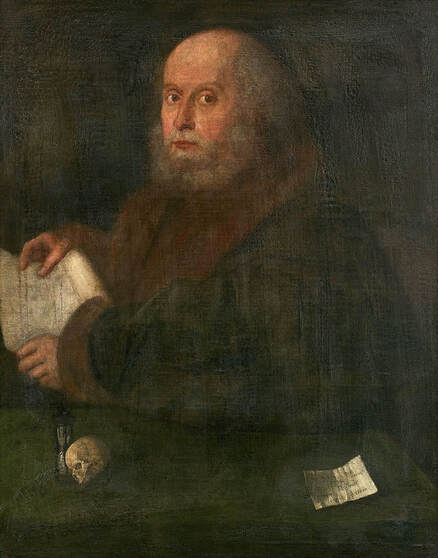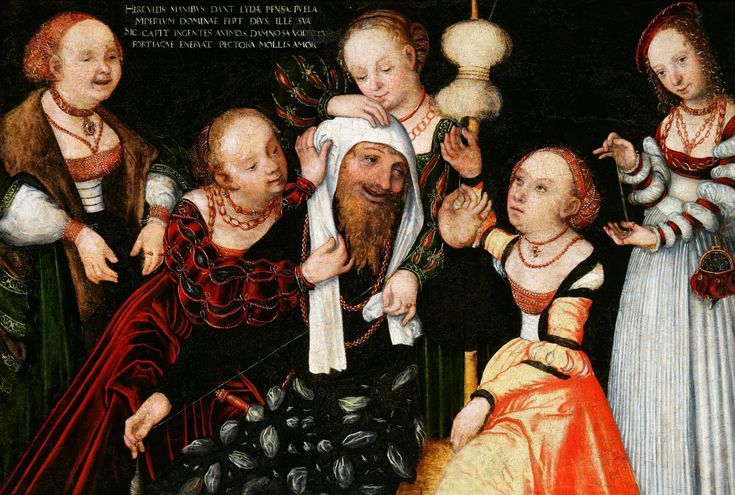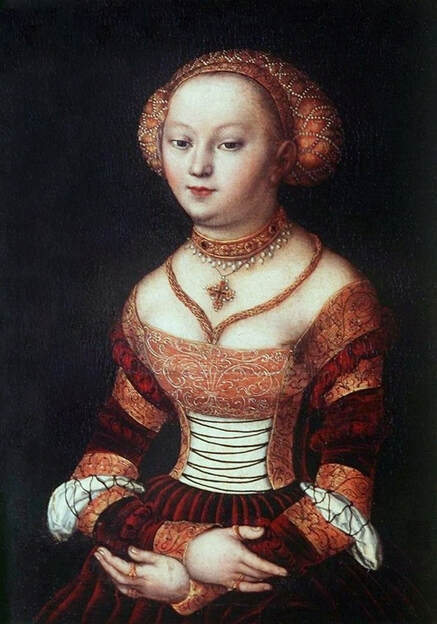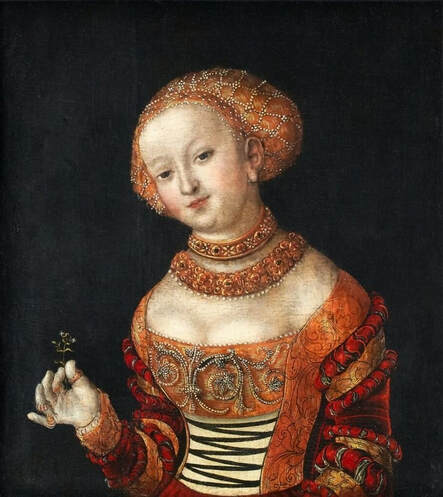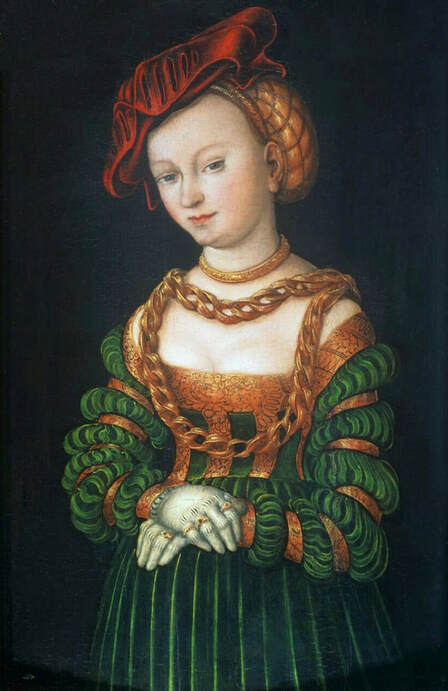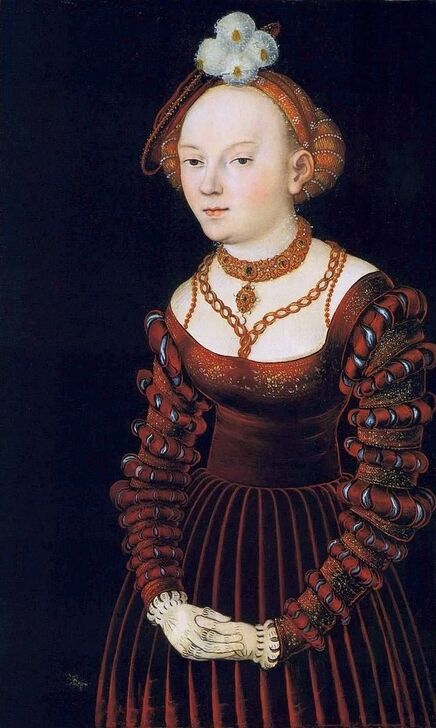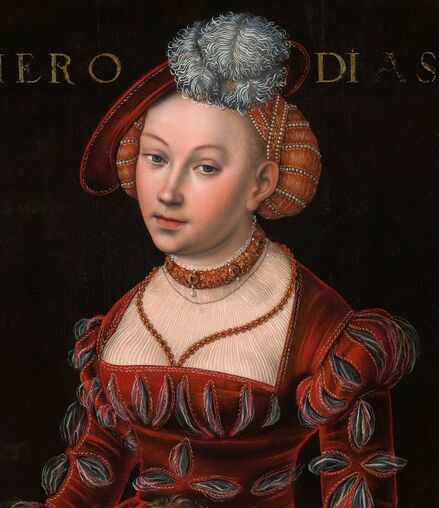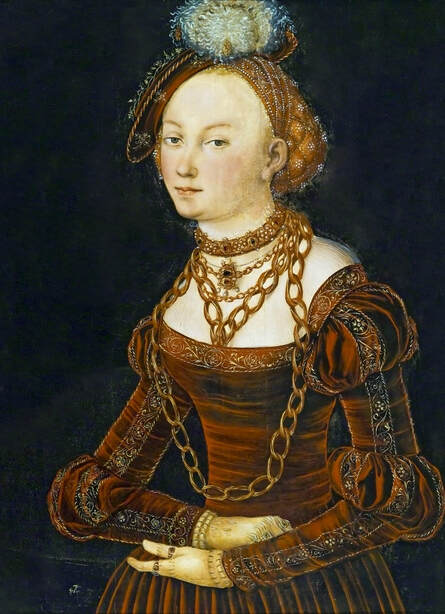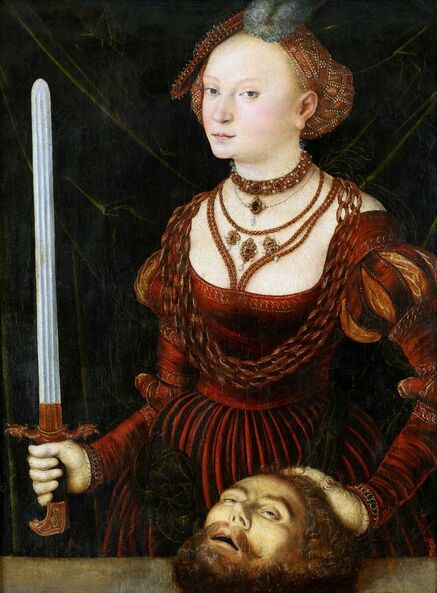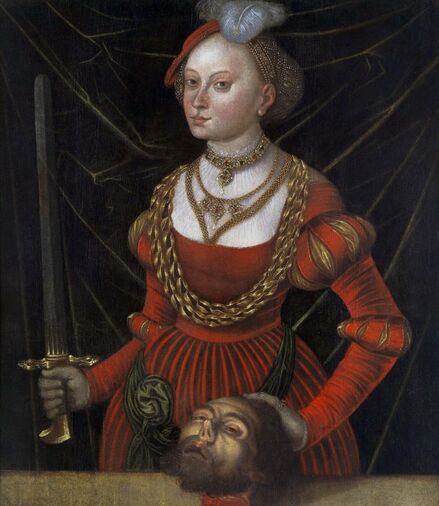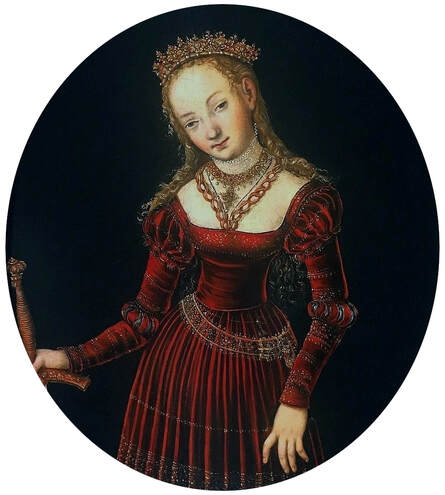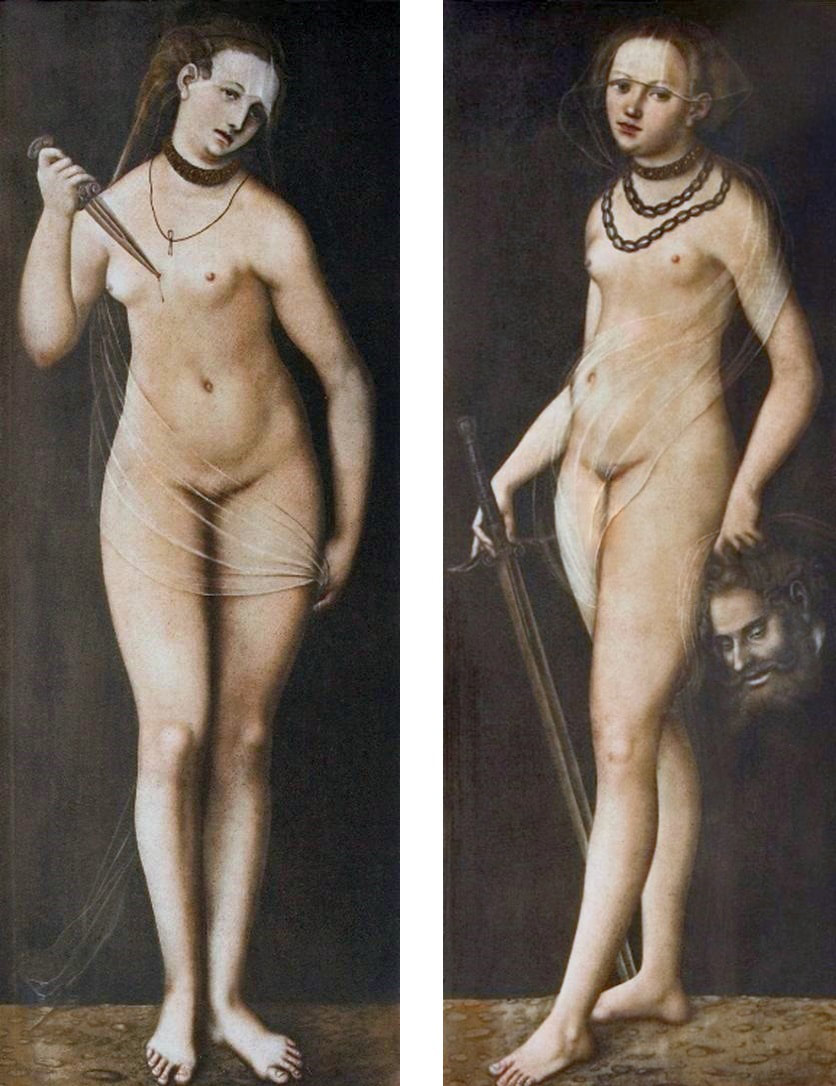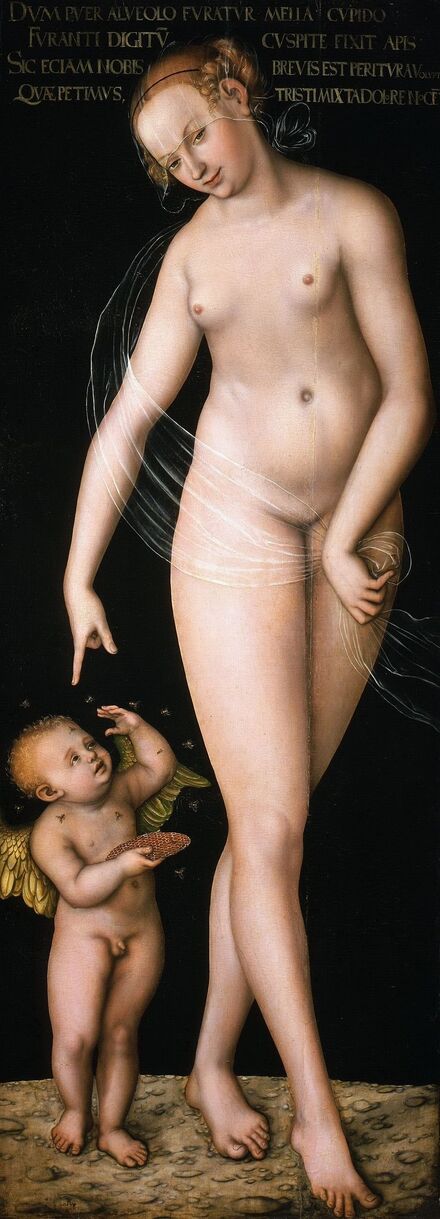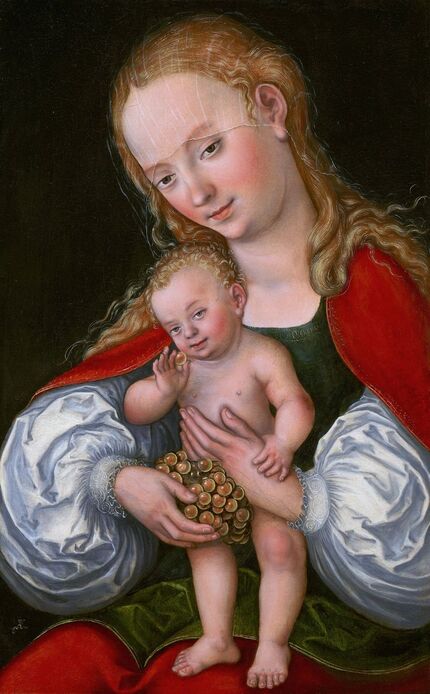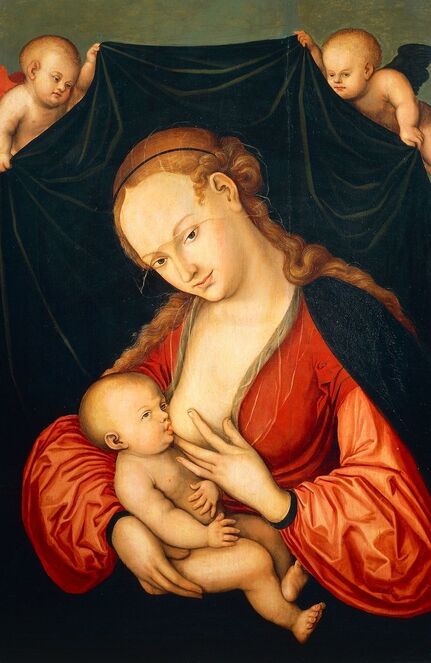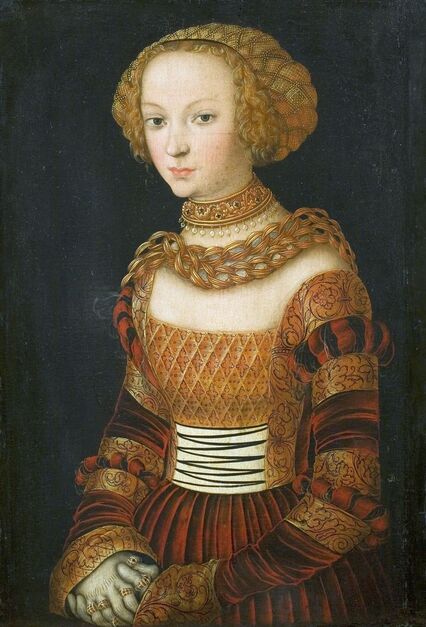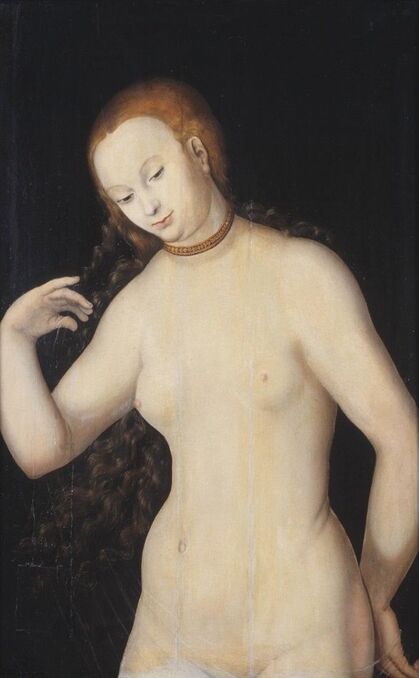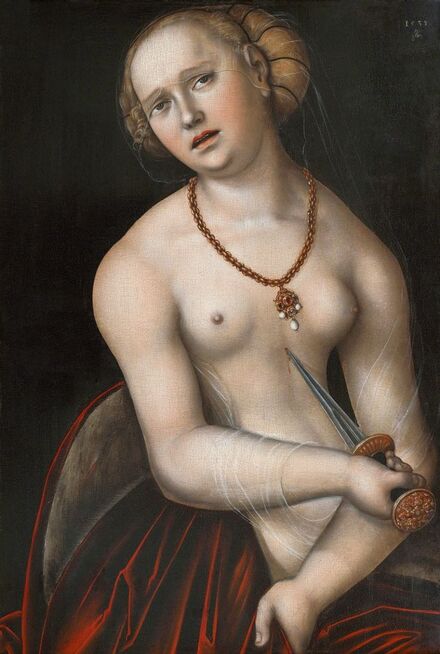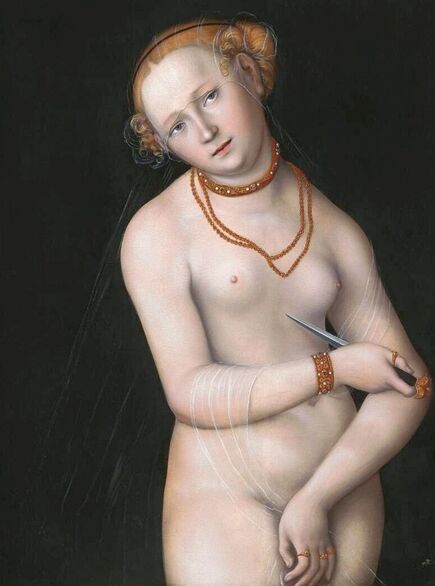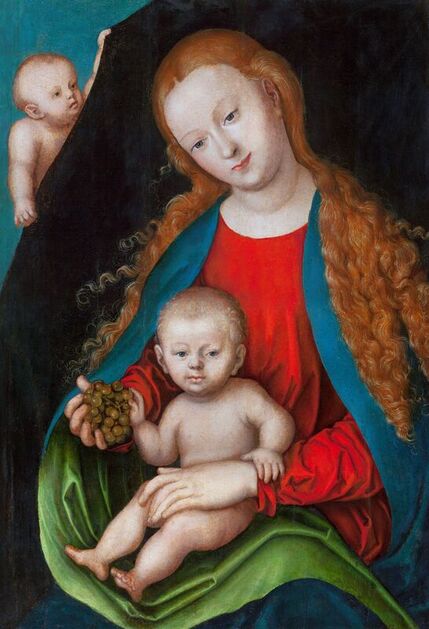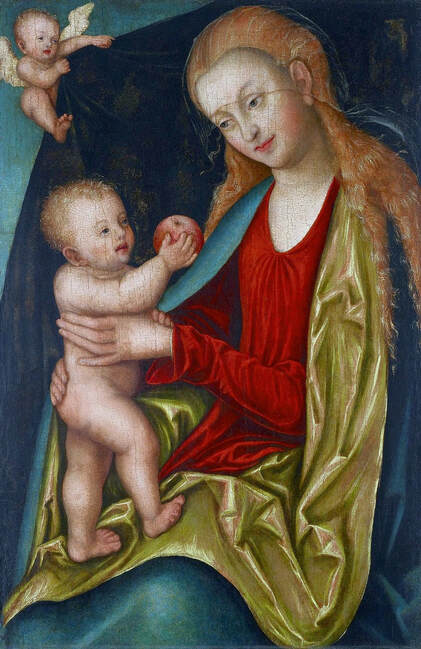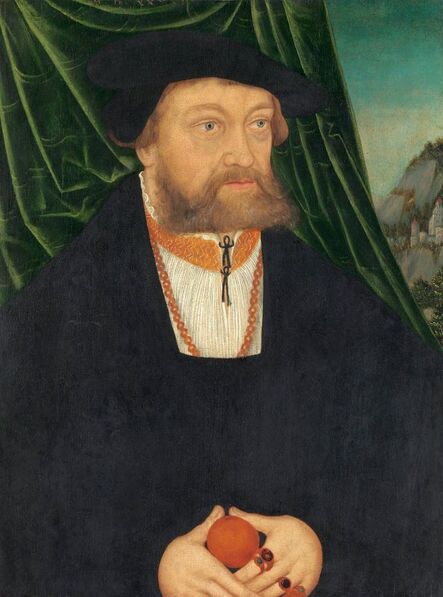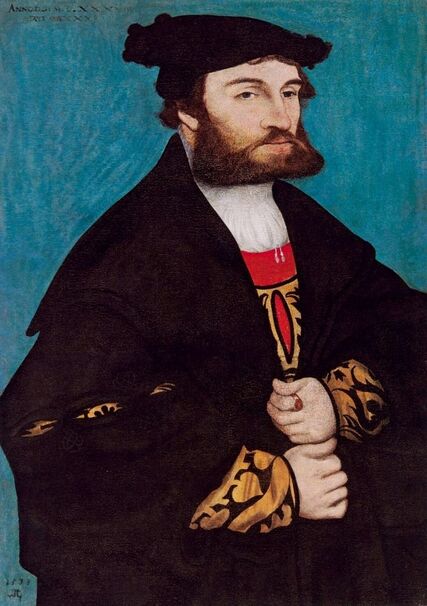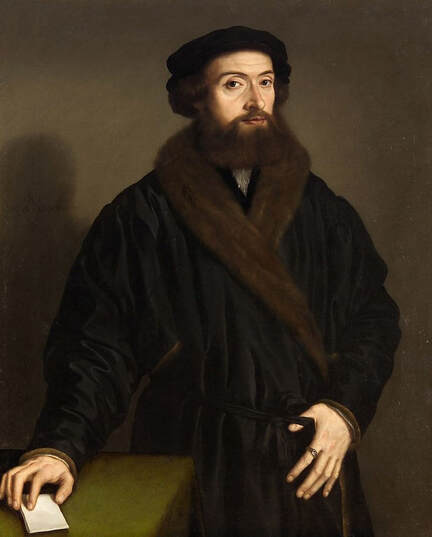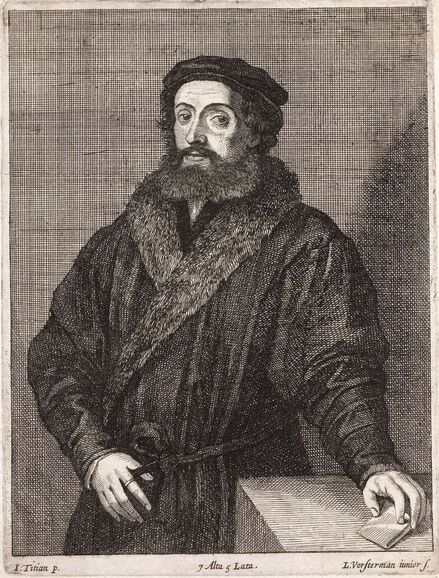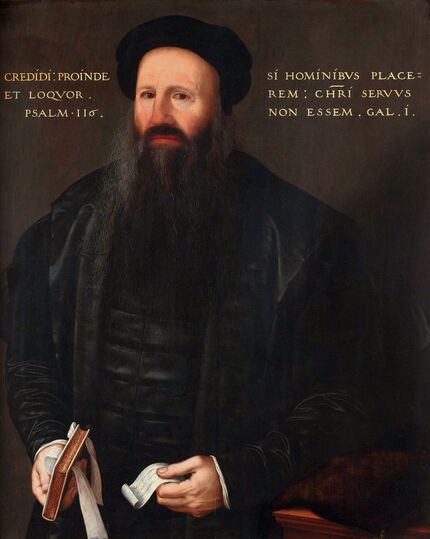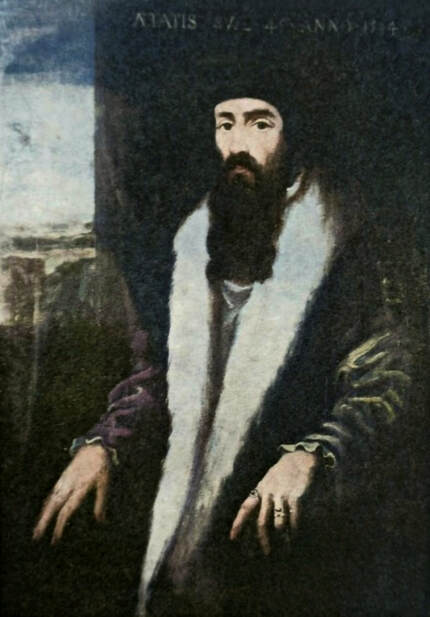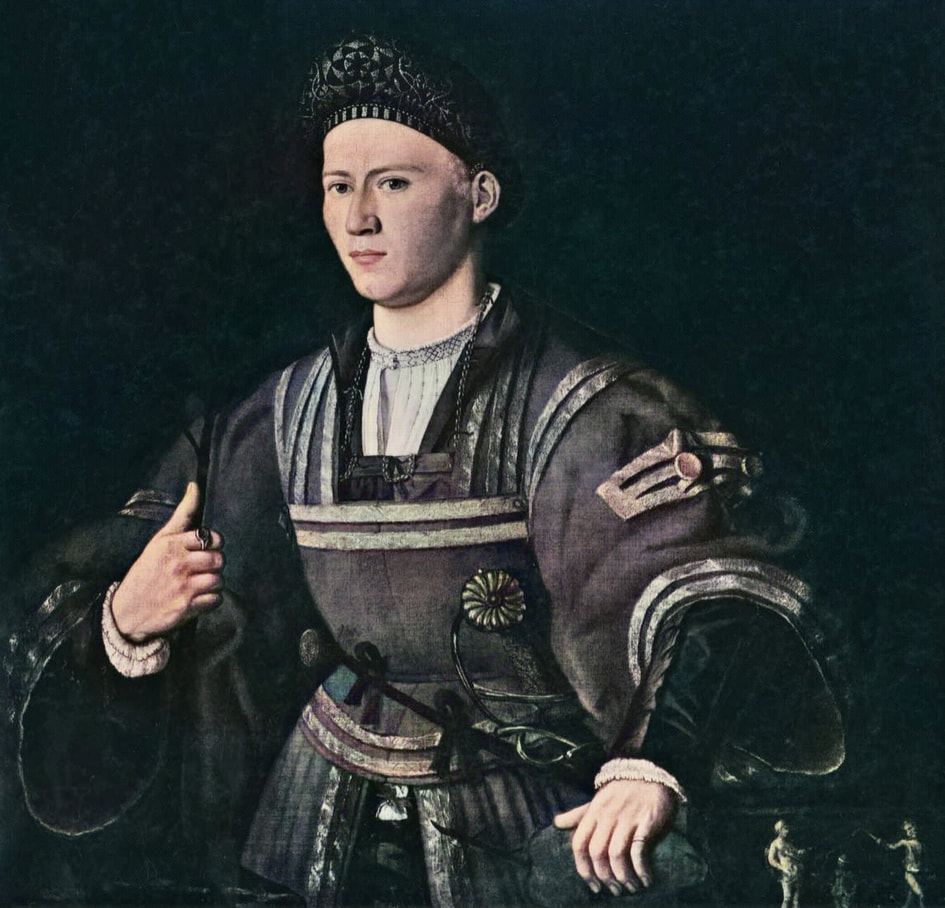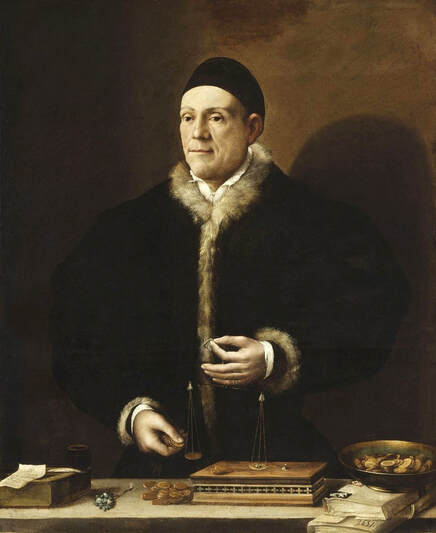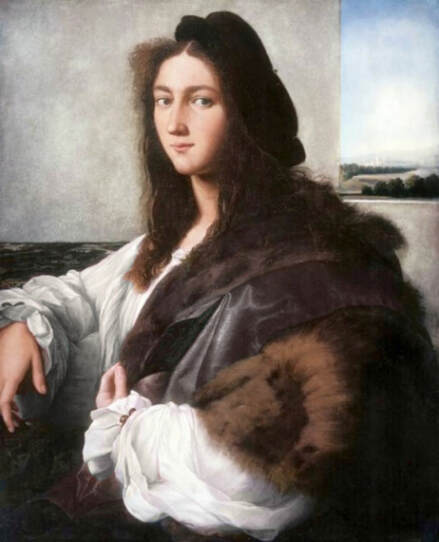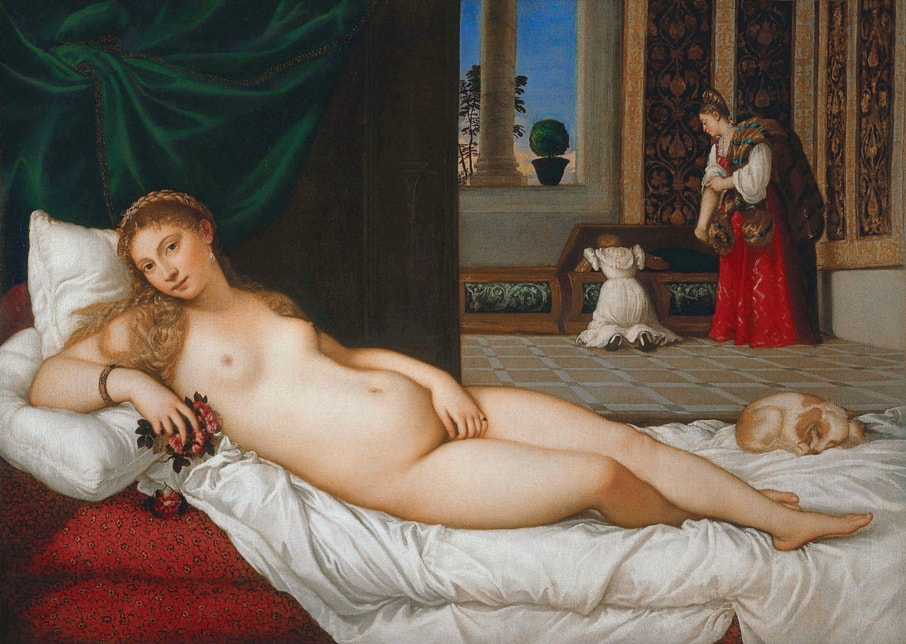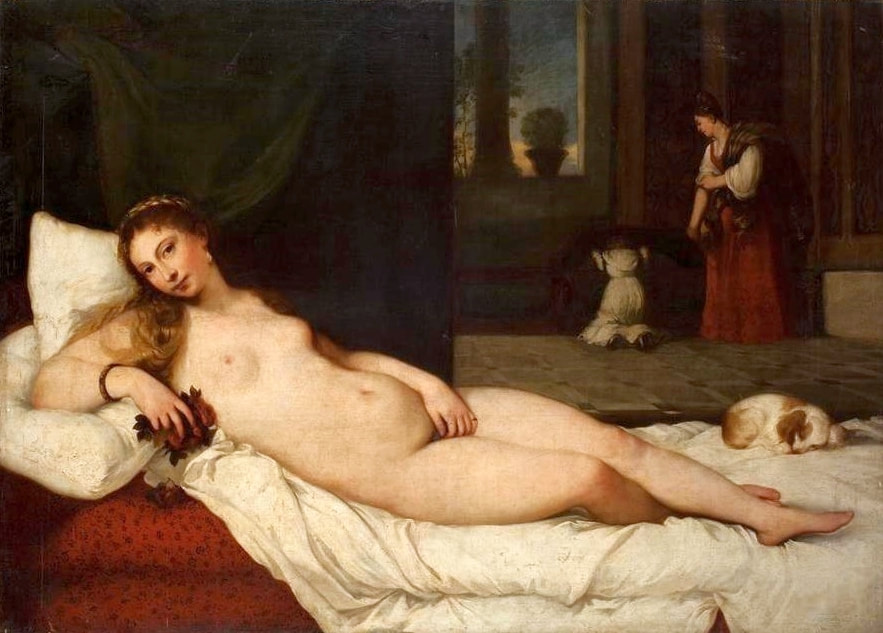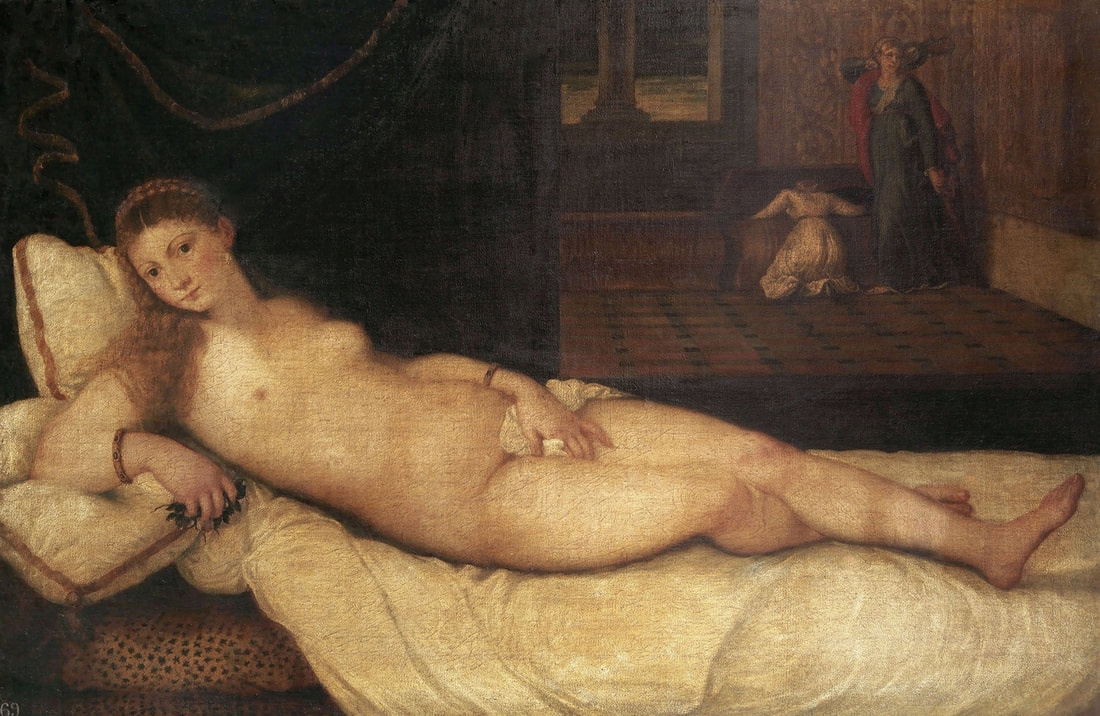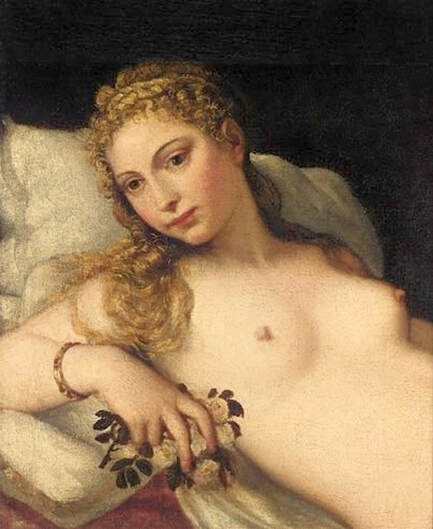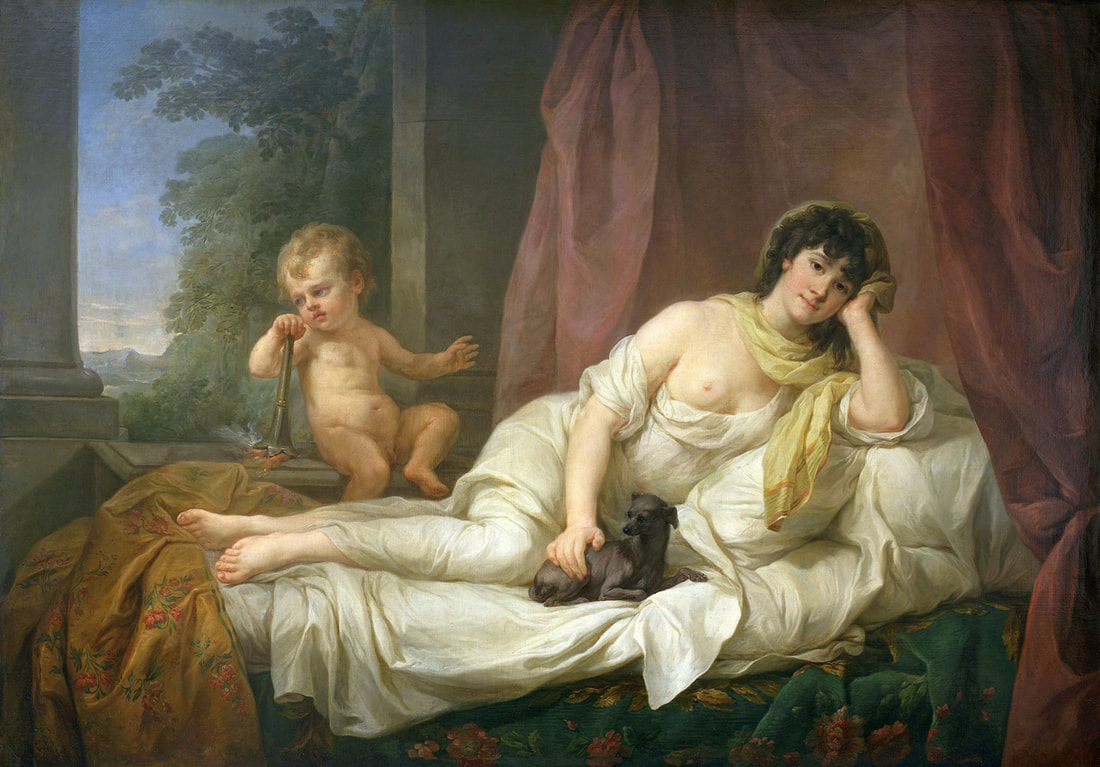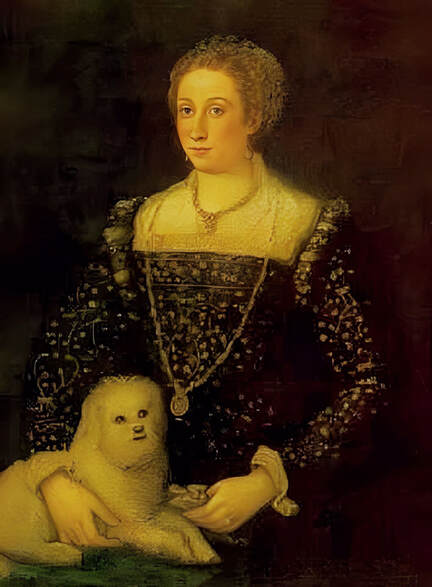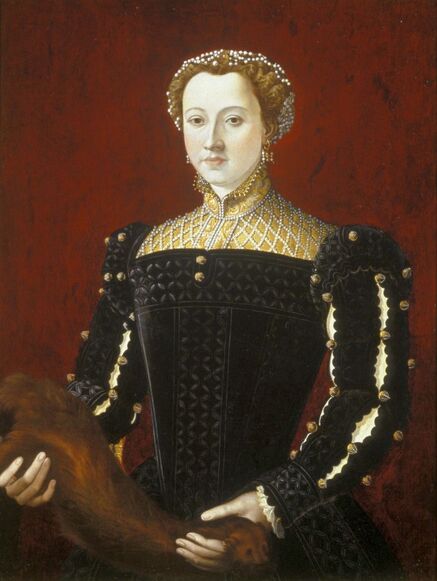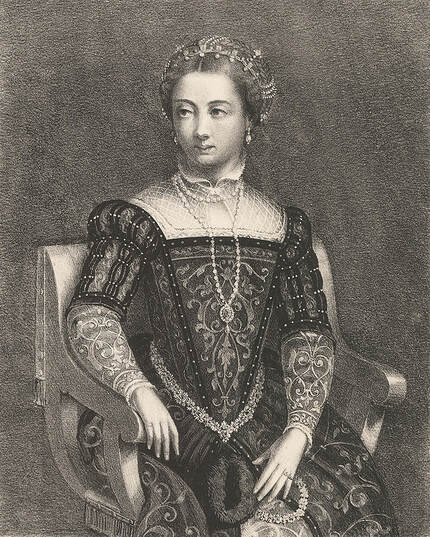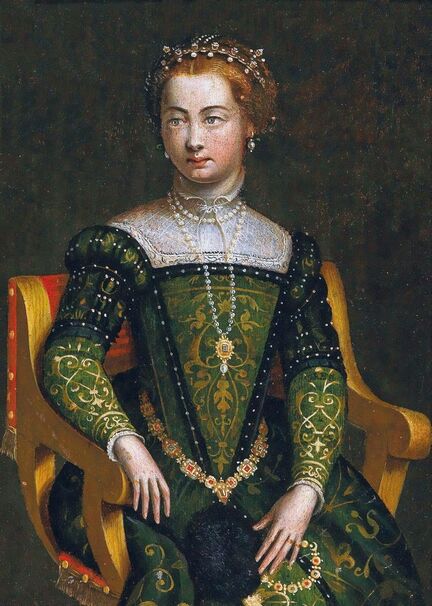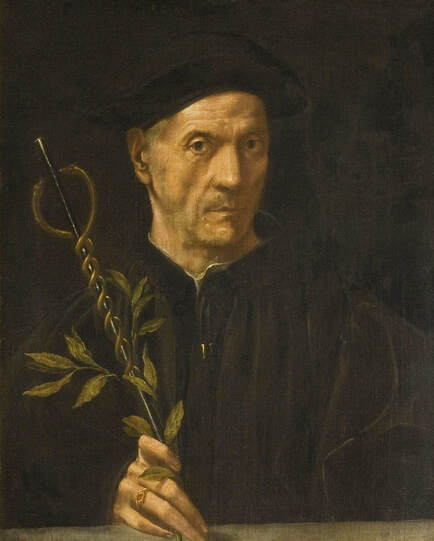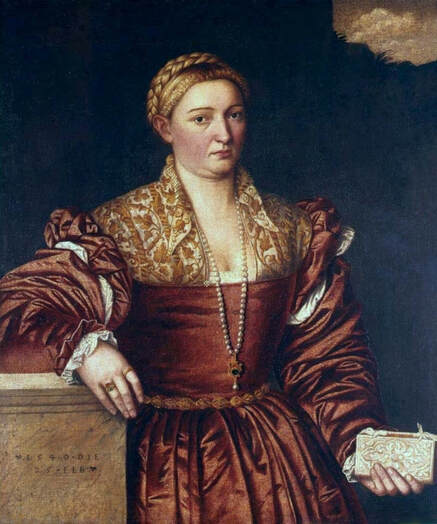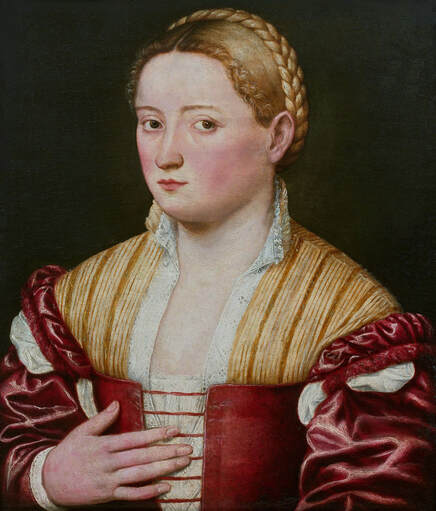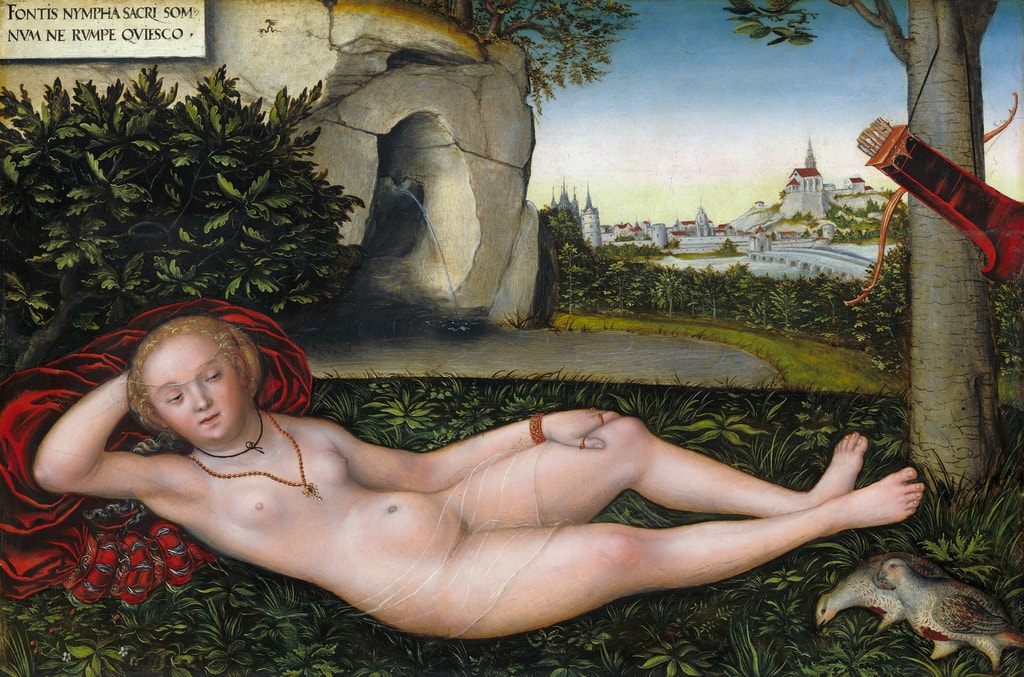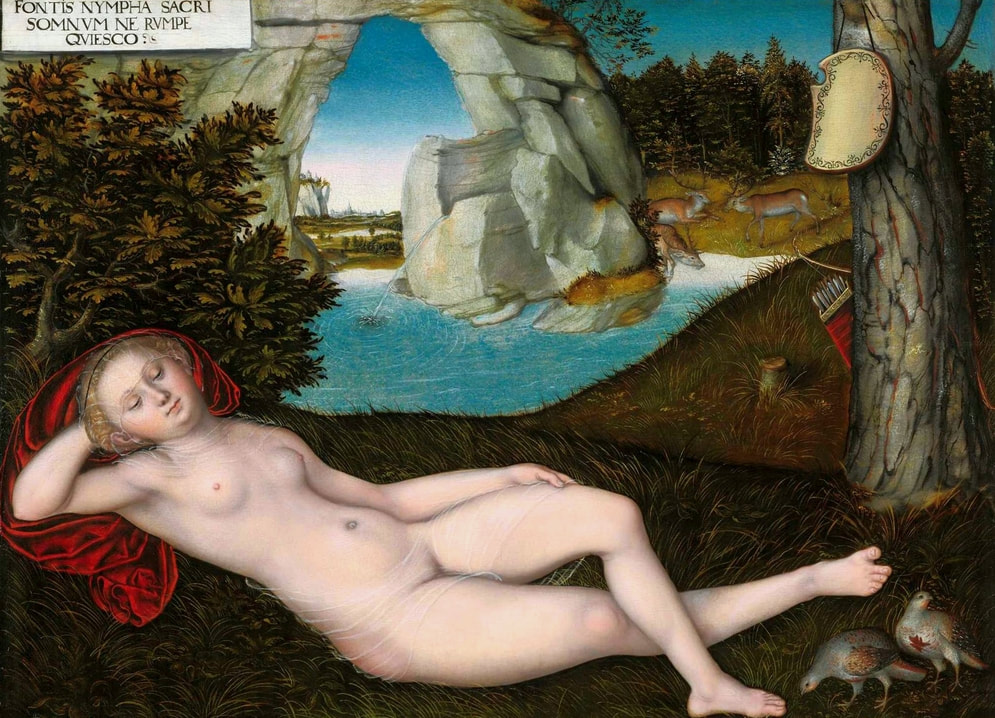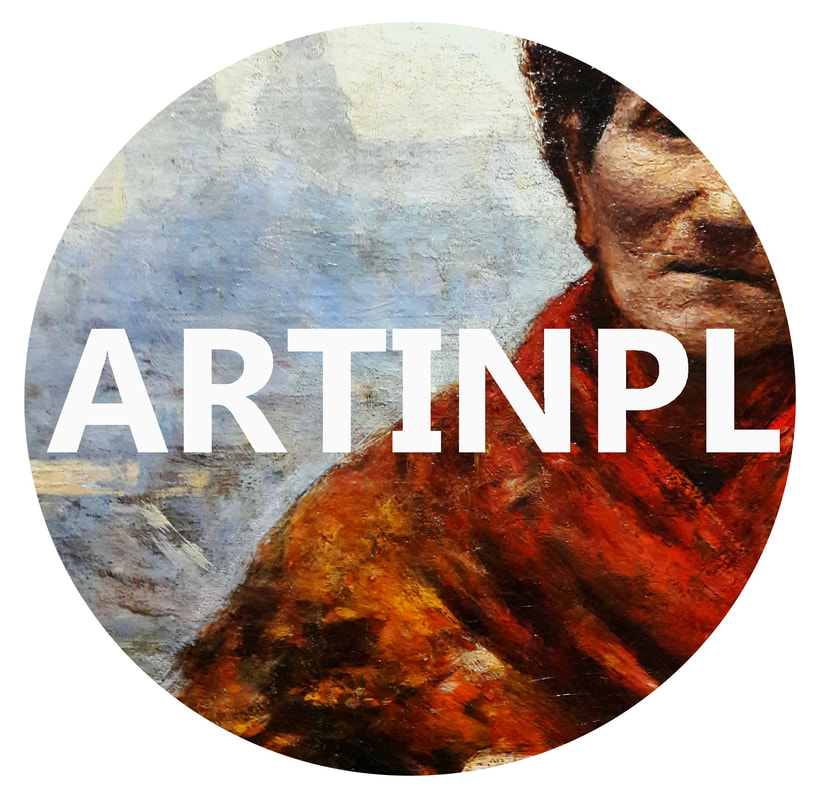|
Portraits of Hedwig Jagiellon and Anna Jagellonica by Lucas Cranach the Elder
Despite numerous suitors for her hand, the Crown Princess Hedwig Jagiellon remained unmarried at the age of 17. In 1529, Krzysztof Szydłowiecki and Jan Tarnowski proposed to Damião de Góis, envoy of John III, king of Portugal, to marry Hedwig to king's brother Infante Louis of Portugal, Duke of Beja. At the same time negotiations were carried to marry her to Louis X, Duke of Bavaria and Habsburgs, on April 18, 1531 proposed Frederick, brother of Louis V, Count Palatine of the Rhine.
To attract suitable marriage proposal, Hedwig's father continued to amass a considerable dowry for her. He commissioned the most luxurious items in Poland and abroad, like the casket, created by Jacob Baur and Peter Flötner in Nuremberg in 1533, adorned with jewels from Jagiellon collection (Hermitage Museum). He also charged his banker Seweryn Boner with the acquisition in Venice of some lengths of silk, several hundred ells of satin, five cloth of gold bales, thirty bales of fine Swabian and Flemish linen as well as pearls for 1,000 florins. In her letter of 19 April 1535 the Princess asked her father for a larger amount of cloth of gold. The marriage was a political contract, and Princess' role was to seal the alliance between countries by producing offspring. Thanks to this she could also have some power in her new country and Hedwig's stepmother, Bona Sforza, knew perfectly about it. It was she who probably took care of providing some erotic items in Hedwig's dowry. In 1534 it was finally decided, in secret from Bona, who was unfavorable to the Hohenzollerns, that Hedwig will marry Joachim II Hector, Elector of Brandenburg and the marriage contract was signed on 21 March 1535. Sigismund commissioned some portraits of Hedwig from court painter Antonius (most probably Antoni of Wrocław), which were sent to Joachim. The groom arrived to Kraków with a retinue of 1000 courtiers and 856 horses and Sigismund's nephew Albert, Duke of Prussia with his wife Dorothea of Denmark and 400 people. Apart from 32,000 red zlotys in cash Hedwig also received from her father robes, silverware, "other indispensable utensils", money for personal use, as well as a rich bed with canopy (canopia alias namiothy), which she took with her to Berlin. A large painting by Lucas Cranach the Elder from about 1530 in the Gemäldegalerie in Berlin (oil on panel, 166.9 x 61.4 cm, inv. 594), which was transferred from the Royal Prussian Castles in 1829/1830, shows Hedwig as Venus and Cupid. The sitter's resemblance to the princess from her earlier portraits by Cranach, which I have identified, is undeniable - paintings in Veste Coburg (M.163) and Prague Castle (HS 242). This erotic painting was undeniably part of her dowry. A portrait from the same collection, which depicts Hedwig as Judith with the Head of Holofernes and dated 1531, was acquired from Suermondt collection in Aachen (oil on panel, 72 x 56 cm, inv. 636A). As the portraits of her stepmother, it most probably also has a political meaning, or the Princess just wanted to be depicted as her beautiful stepmother. Aachen was an Imperial City, where coronations of emperors were held till 1562 and in 1815, control of the town was passed to the Kingdom of Prussia. Already in 1523 Joachim I Nestor, Elector of Brandenburg wanted Hedwig's hand for one of his sons. It is possible that her portrait as Judith was sent to the Hohenzollerns or to the Habsburgs already in 1531 to underline that the Jagiellons would not permit them to take their crown. A similar painting to that of Hedwig's, depicting Venus with Cupid stealing honey by Lucas Cranach the Elder and dated 1531, is in the Borghese Gallery in Rome (oil on panel, 169 x 67 cm, inv. 326). It was aquired in 1611 and bears the same inscription as effigy of Katarzyna Telniczanka as Venus. The woman has features of Hedwig's cousin Anna Jagellonica (1503-1547), Queen of Germany, Bohemia, and Hungary. Anna was a daughter of Vladislaus II, King of Bohemia, Hungary and Croatia, elder brother of Sigismund I, and his third wife, Anne of Foix-Candale. On 26 May 1521 she married Archduke Ferdinand of Austria, grandson of Emperor Maximilan I, who was elevated to the title King of the Romans by his brother Emperor Charles V in 1531. On her golden hairnet embroidered with pearls there is a monogram W.A.F.I. or W.A.F. which can be interpreted as Wladislaus et Anna (parents), Ferdinandus I (husband), Wladislaus et Anna Filia (daughter of Vladislaus and Anne) or Wladislaus et Anna de Fuxio (Vladislaus and Anne of Foix). Similar monogram of her parents WA is visible on a golden pendant at her hat in her portrait at the age of 16 by Hans Maler, created in 1520 (private collection). A portrait of Anna's husband, painted by Cranach in 1548, so after her death, is in Güstrow Palace (G 2486). The register of paintings of Boguslaus Radziwill (1620-1669) from 1657 (AGAD 1/354/0/26/84), which included several paintings by Cranach, lists: "Image of the Three Cupids", "Image of the Three Goddesses", "A picture of the Emperor's face on one side and Adam and Eve on the other by Lucas Cranach", "Judith" and "Lucas Cranach's art with Venus and Cupid". In his "Thoughts on painting" (Considerazioni sulla pittura), written between 1617 and 1621 in Rome, Italian physician and art collector Giulio Mancini (1559-1630), claimed that "lascivious paintings in similar places where a man stays with his wife are appropriate, because such a view is very beneficial for excitement and for making beautiful, healthy and vigorous sons" (pitture lascive in simil luoghi dove si trattenga con sua consorte sono a proposito, perché simil veduta giova assai all’eccitamento et al far figli belli, sani e gagliardi) (partially after "Ksiądz Stanisław Orzechowski i swawolne dziewczęta" by Marcin Fabiański, p. 60).
Portrait of Crown Princess Hedwig Jagiellon (1513-1573) as Venus and Cupid by Lucas Cranach the Elder, ca. 1530, Gemäldegalerie in Berlin.
Portrait of Crown Princess Hedwig Jagiellon (1513-1573) as Judith with the Head of Holofernes by Lucas Cranach the Elder, 1531, Gemäldegalerie in Berlin.
Portrait of Queen Anna Jagellonica (1503-1547) as Venus with Cupid stealing honey by Lucas Cranach the Elder, 1531, Borghese Gallery in Rome.
Portraits of Zofia Szydłowiecka by Lucas Cranach the Elder and workshop
On April 4, 1528, John Zapolya, elected King of Hungary, came to Tarnów in the company of Grand Crown Hetman and voivode of Ruthenia, Jan Amor Tarnowski (1488-1561). As a result of the double election and the lost battle with Archduke Ferdinand I near Tokaj, Zapolya sought a safe haven - first in Transylvania and then in Poland.
For the duration of his stay, Hetman Tarnowski made the entire castle and the city of Tarnów at his disposal, for which, he was severely reprimanded by Ferdinand I. To this, in a letter dated in Sandomierz on 25 July 1528, he was to reply that the holy laws of friendship did not allow him to refuse hospitality. From April to September 1528, the city became, under the patronage of Queen Bona, the seat of the Hungarian king and the center of activities aimed at restoring his throne. The Queen did it secretly so as not to reveal her role to the Habsburg agents. Zapolya sent ambassadors to Bavaria, King Francis I of France, the Pope and a number of other states. Finally he approached the Ottoman Porte and returned to Hungary on October 2, 1528. He expressed his gratitude for the hospitality of the people of Tarnów by granting a trade privilege and founding a beautiful altar for the collegiate church, not preserved. To the Hetman he offered a mace and a golden shield, estimated at 40,000 Hungarian red zlotys (after Andrzej Niedojadło's "Goście zamku tarnowskiego" and Przemysław Mazur's "Król Jan Zápolya w Tarnowie - Tarnów 'stolicą' Węgier"). On May 8, 1530 in the royal Wawel Cathedral, in the presence of the king and queen, the bishop of Kraków, Piotr Tomicki, celebrated the wedding of sixteen-year-old Zofia Szydłowiecka and forty-two-year-old (which was then considered an advanced age) Hetman Jan Amor Tarnowski. Zofia, born in about 1514, was the eldest daughter of Krzysztof Szydłowiecki (1467-1532), Great Chancellor of the Crown and Zofia Targowicka (ca. 1490-1556) of Tarnawa coat of arms. They had 9 children, but only three daughters reached adulthood. Szydłowiecki was a political opponent of Queen Bona and supporter of the Habsburgs - in 1527 he reported to his friend Albert of Prussia, that the Queen extended her influence to almost all spheres of political life. In addition to a luxurious lifestyle, for which he earned the name of the Polish Lucullus among his contemporaries, he was a patron of art and science and collected illuminated codices. Erasmus of Rotterdam dedicated his work "Lingua" to him, published in Basel in 1525. In 1530 the Crown Chancellor thanked to Jan Dantyszek for the portrait of Hernán Cortés that he sent to him, adding that the man's deeds are known to him ex libro notationum received as a gift from Ferdinand of Austria. After his death in 1532, Jan Amor Tarnowski, become the guardian of his younger daughters. In 1519, when his second daughter Krystyna Katarzyna, future duchess of Ziębice-Oleśnica was born, Krzysztof Szydłowiecki commissioned a votive painting, most likely, for the Collegiate Church of St. Martin in Opatów, where he also offered a portrait of Beatrice of Naples as Madonna and Child by Timoteo Viti or Lucas Cranach the Elder. This painting, attributed to Master Georgius, a painter apparently of Bohemian origin, was later in the collection of count Zdzisław Tarnowski in Kraków, now in the National Museum in Kraków (tempera and gold on wood, 60.5 x 50 cm, MNK I-986). It shows the Virgin and Child with Saint Anne and the founder kneeling and looking at the Virgin. His effigy, armour and attire are very similar to these visible in the miniature from the Liber geneseos illustris familiae Schidloviciae (The genealogical book of the Szydłowieckis) in the Kórnik Library, created by Stanisław Samostrzelnik in 1532. The effigy of Saint Anne, mother of the Virgin Mary, the protector of pregnant women and patron saint of families and children, on the right is very similar to the portrait of Zofia Szydłowiecka née Goździkowska of Łabędź (Swan) coat of arms, mother of Krzysztof in the same Liber geneseos illustris familiae Schidloviciae. Also face features of Saint Anne are very similar to effigies of sons of Zofia Goździkowska - from the bronze tomb monument of Krzysztof Szydłowiecki in the Collegiate Church in Opatów, attributed to Bernardino Zanobi de Gianotis and marble tombstone of Mikołaj Stanisław Szydłowiecki (1480-1532) in Szydłowiec, created by Bartolommeo Berrecci or workshop, both from about 1532. Consequently the woman depicted as the Virgin must be Zofia Targowicka, wife of Krzysztof Szydłowiecki. A similar woman to the effigy of the Virgin from Szydłowiecki's votive painting was depicted as Madonna and as Venus in two small paintings, both by Lucas Cranach, his son or workshop. The image of Venus, today in private collection (wood, 42 x 27 cm), had been in the collection of Munich art dealer A.S. Drey, before being acquired by the Mogmar Art Foundation in New York in 1936. It is similar to effigies of Beata Kościelecka and Margaret of Brandenburg (1511-1577), Duchess of Pomerania as Venus, therefore should be dated to around 1530, when Zofia Szydłowiecka, the eldest daughter of Krzysztof was about to get married. The Madonna with similar face was purchased from Monsignor J. Shine on April 1954 by the National Gallery of Ireland in Dublin (transferred to linen, attached to plywood, 72.3 x 49.5 cm, NGI.1278). A miniature tondo from the collection of Jean-Baptiste Bourguignon de Fabregoules (1746-1836), offered to the Musée Granet in Aix-en-Provence by his sons in 1860 (wood, 14 cm, inv. 343), shows her in a dress and pose similar to that of Queen Bona in a miniature sold at Hôtel Drouot in Paris on 30 October 1942. The same woman was also depicted as Judith with the head of Holofernes in a painting by workshop Lucas Cranach the Elder, similar to the portrait of Queen Bona in Vienna and in Stuttgart. This painting was acquired by William Delafield in 1857 and was sold in London in 1870 (wood, 39.7 x 26.7 cm). Her face is very similar to the portrait of Krzysztof Szydłowiecki in the Liber geneseos illustris familiae Schidloviciae. If the portrait as Judith was a political statement of support of the Queen's policies and not a whim of a young girl willing to emulate the Queen, this will add a further explanation to a series of caricature portraits of this girl in the arms of an ugly, old man. One of the best of these caricature portraits is in the Museum Kunstpalast in Düsseldorf (wood, 38.8 x 25.7, M 2248). Before 1860 it was in the collection of Count August von Spee (1813-1882) from an old Rhenish noble family from the Archdiocese of Cologne, while the Archbishop of Cologne was one of the Electors of the Holy Roman Empire. On 5 January 1531 Ferdinand of Austria had been elected the King of the Romans and so the legitimate successor of the reigning Emperor, Charles V, who was crowned as Holy Roman Emperor in 1530. A workshop copy of this painting from the collection of Baron Samuel von Brukenthal (1721-1803), a personal advisor of Empress Maria Theresa, is in the Brukenthal National Museum in Sibiu, Transylvania (wood, 37.4 x 27.6 cm, inv. 218). Brukenthal came from Transylvanian Saxon lesser nobility, while the Saxons were partisans of Ferdinand of Austria and supported the House of Habsburg against John Zapolya. Several other copies of this composition exist. The girl was also depicted in another version of the scene, kissing the old man, in the National Gallery in Prague (wood, 38.1 x 25.1 cm, O 455). It was bequeathed by Dr. Jan Kanka in 1866 and its earlier history is unknown. This work of fairly high standard, may have been produced by the master himself. On 24 October 1526 the Bohemian Diet elected Ferdinand King of Bohemia under conditions of confirming traditional privileges of the estates and also moving the Habsburg court to Prague. We can assume with high probability that the paintings were commissioned by partisans of Ferdinand I or even by himself, dissatisfied that the eldest daughter of Szydłowiecki joined the camp of his opponent, "a great enemy of the king of Rome" Queen Bona (as later reported an anonymous Habsburg agent at the Polish court in an encrypted message). It is possible that the painting "A woman courted by the old man", mentioned in the register of paintings of Boguslaus Radziwill (1620-1669) from 1657 (AGAD 1/354/0/26/84), where there were several paintings by Cranach, was another version or a copy of one of these two compositions. She was also depicted in another painting by workshop of Lucas Cranach the Elder from the early 1530s, in guise of Lucretia, legendary heroine of ancient Rome, just before she commits suicide, now in the Historical Museum in Regensburg (wood, 62 x 41 cm, LG 14). The painting was purchased from the Swiss art market by Hermann Göring in 1942. Seized by the Allies after the World War II, it was acquired by the Federal Republic of Germany. Her splendid gown, open at the front and revealing her naked chest, is similar to those visible in the miniatures of Barbara Tarnowska née Szydłowiecka and Anna Szydłowiecka née Tęczyńska from the mentioned Liber geneseos. The castle behind on a fantastic rock is undoubtedly one of the Tarnowski mansions in mythical disguise, possibly the favorite residence of Jan Amor Tarnowski in Wiewiórka near Dębica, who died there in 1561. This cannot be confirmed with certainty because the opulent residence in Wiewiórka was almost completely destroyed and no confirmed view of the castle preserved. This defensive manor on a hill surrounded by a moat, had at least one tower and a drawbridge, as well as barrel vaulted cellars, which preserved. Many important political and cultural figures of 16th-century Poland visited the court in Wiewiórka, and in 1556 a meeting of the hetman's supporters was held there, during which postulates of religious reforms for the next Sejm were drafted, including, among others, the marriage of priests.
Virgin and Child with Saint Anne with portraits of Krzysztof Szydłowiecki, his wife Zofia Targowicka and mother Zofia Goździkowska by Master Georgius, 1519, National Museum in Kraków.
Portrait of Zofia Szydłowiecka (1514-1551) as Venus and Cupid by Lucas Cranach the Elder, Lucas Cranach the Younger or workshop, ca. 1530, Private collection.
Portrait of Zofia Szydłowiecka (1514-1551) as Madonna and Child with Infant John the Baptist and angels by Lucas Cranach the Elder, Lucas Cranach the Younger or workshop, ca. 1530 or after, National Gallery of Ireland.
Miniature portrait of Zofia Szydłowiecka (1514-1551) by workshop of Lucas Cranach the Elder, ca. 1530, Musée Granet in Aix-en-Provence.
Portrait of Zofia Szydłowiecka (1514-1551) as Judith with the head of Holofernes by workshop Lucas Cranach the Elder, ca. 1530, Private collection.
Ill-Matched Couple, caricature of Zofia Szydłowiecka (1514-1551) and her husband by Lucas Cranach the Elder and workshop, ca. 1530, Museum Kunstpalast in Düsseldorf.
Ill-Matched Couple, caricature of Zofia Szydłowiecka (1514-1551) and her husband by workshop of Lucas Cranach the Elder, ca. 1530, Brukenthal National Museum in Sibiu.
Ill-Matched Couple, caricature of Zofia Szydłowiecka (1514-1551) and her husband by Lucas Cranach the Elder and workshop, ca. 1530, National Gallery in Prague.
Portrait of Zofia Szydłowiecka (1514-1551) as Lucretia by workshop of Lucas Cranach the Elder, ca. 1532, Historical Museum in Regensburg.
Portrait of Krzysztof Szydłowiecki, Great Chancellor of the Crown by Titian
"I am a great admirer of beautiful and artistic paintings" (Ego multum delector in pulcra et artificiosa pictura), wrote Krzysztof Szydłowiecki (1467-1532), Vice-Chancellor of the Crown, in a letter of May 17, 1512 from Toruń to Fabian Luzjański, Bishop of Warmia. He asked for help in obtaining from Flanders via Gdańsk the painting of the Madonna Monstra te esse Matrem ("Show thyself a mother").
From 1496 Szydłowiecki was a courtier of Prince Sigismund and from 1505 he was a marshal of the prince's court. From the moment of the coronation of Sigismund I, Krzysztof occupied various important positions and he become the Great Chancellor of the Crown in 1515. He managed Polish foreign policy during the reign of Sigismund I. In 1515, together with Bishop Piotr Tomicki, he developed an agreement with the Habsburgs, which was signed during the Congress of Vienna and Emperor Maximilian I, as a sign of respect and gratitude, granted Krzysztof the title of baron of the Holy Roman Empire (he rejected the princely title offered to him by the emperor). Thanks to numerous grants, as well as bribes (from Emperor Maximilian alone, he accepted 80,000 ducats for supporting Austria at the congress of monarchs in Vienna, and also took money from the monarch of Hungary, John Zapolya, and Francis I of France; the city of Gdańsk also paid for the protection), he made a huge fortune. The chancellor died on December 30 , 1532 in Kraków, and was buried in the collegiate church in Opatów. His tombstone, decorated with a bronze bas-relief, was made in the workshop of Bartolommeo Berrecci and Giovanni Cini in Kraków. He ordered the tombstone for himself during his lifetime and after his death, in about 1536, on the initiative of his son-in-law Jan Amor Tarnowski (1488-1561), it was enlarged by adding a bas-relief depicting relatives and friends moved by the news of the chancellor's death, on the pedestal of the monument (so-called Opatów Lamentation). Szydłowiecki imitated the luxurious lifestyle of Prince Sigismund, who in 1501 ordered several illuminated prayer books (or one book adorned by several illuminators), and the following year bought paintings with views of different buildings from Italian merchant (Ilalo qui picturas edificiorum dno principi dedit 1/2 fl.). Despite being a political opponent of Queen Bona, he followed the example of the queen, who at her court employed Italian painters and imported paintings from Italy for her vast collection (after "Bona Sforza" by Maria Bogucka, p. 105). His splendid castle on the island in Ćmielów, rebuilt in renaissance style between 1519-1531, was destroyed in 1657 by Swedish and Transylvanian forces, which also massacred many noble families who had taken refuge there (after "Encyklopedia powszechna", Volume 5, p. 755). This veritable Apocalypse, known as the Deluge (1655-1660), as well as other invasions and wars, left very little trace of the chancellor's patronage. Before 1509, Krzysztof's brother Jakub Szydłowiecki, Grand Treasurer of the Crown, brought from Flanders a "masterly made" painting of the Madonna (after "Złoty widnokrąg" by Michał Walicki, p. 108). In 1515 the chancellor offered to the Collegiate Church in Opatów a painting of Madonna and Child (disguised portrait of Beatrice of Naples, Queen of Hungary and Bohemia) by Timoteo Viti or Lucas Cranach the Elder, and in 1519 Master Georgius created a portrait of Krzysztof as a donor (National Museum in Kraków, MNK I-986). More than a decade later, in 1530, the chancellor received from Jan Dantyszek the portrait of Hernán Cortés, most likely by Titian, and a portrait of the chancellor was mentioned in the vault of the Nesvizh Castle in the 17th century. Most likely in Venice, in 1515 or after, Krzysztof acquired Legenda aurea sive Flores sanctorum by Jacobus de Voragine for his library (a printed bookplate with his coat of arms is on the back of the front cover), today in the National Library of Poland (Rps BOZ 11). It was created in the 1480s for Francesco Vendramini from Venice and illuminated by miniaturists active in Padua and Venice. In 1511, one of Poland's finest Renaissance painters and miniaturists, Stanisław Samostrzelnik, who also worked for the royal court, became his court painter (pictori nostro) and chaplain, and in this capacity he accompanied Szydłowiecki on his travels. Stanisław probably stayed with his patron in 1514 in Buda, where he became familiar with the Italian Renaissance. He decorated documents issued by the chancellor, such as the privilege of Opatów of August 26, 1519, with the portrait of the chancellor as a kneeling donor, wearing a fine gold-engraved armor and a crimson tunic. Shortly before the chancellor's death, he began working on a series of miniature portraits of members of the Szydłowiecki family, known as Liber geneseos illustris familiae Schidloviciae (1531-1532, Kórnik Library), including the effigy of the chancellor in another beautiful armour decorated with gold and crimson tunic. Earlier, in 1524, Samostrzelnik illuminated the Prayer Book of Szydłowiecki, adorned with chancellor's coat of arms in many miniatures. It is dated (Anno Do. MDXXIIII) and has a painted bookplate. The manuscript was disassembled at the turn of the 18th and 19th centuries. Probably a Milanese antiquarian cut out miniatures from it, some of which, in the number of ten, were acquired by Biblioteca Ambrosiana in Milan (F 277 inf. no 1-10), while the manuscript, divided into two parts and acquired by the City of Milan from the library of the princes of Trivulzio, is kept in the Archivio Storico Civico (Cod. no 459, Cod. no 460). One miniature, the Flight into Egypt, is largely inspired by a painting by Hans Suess von Kulmbach, created in 1511 for the Skałka Monastery in Kraków. The others could derive from paintings in the Szydłowiecki collection or the royal collection - the Massacre of the Innocents, reminiscent of Flemish paintings and the Madonna and Child, in a manner that brings to mind the Italian paintings. The prayer book is one of the two important polonica of the Jagiellonian period in Milan. The other is also in Ambrosiana, in a part dedicated to art collection - Pinacoteca. It is a sapphire intaglio with bust of Queen Bona Sforza, attributed to Giovanni Jacopo Caraglio (inventory number 284). If not for the Latin inscription on her dress (BONA SPHOR • REG • POLO •), it would be considered to represent an Italian princess, which is generally correct. The exact provenance of these two works of art is unknown, so we cannot rule out the possibility that they were diplomatic gifts to Francesco II Sforza (1495-1535), the last member of the Sforza family to rule Milan, and Bona's relative. The ruling houses of Europe exchanged such gifts and effigies at that time, including the portraits of important notables. In the same Ambrosiana in Milan there is also a portrait of an old man in armour by Titian (oil on canvas, 65 x 58 cm, inventory number 284). It is dated around 1530, the time when Chancellor Szydłowiecki received a portrait of the Spanish conquistador, most likely by Titian. The work arrives in Ambrosiana together with the nucleus donated in 1618 by Cardinal Federico Borromeo who in the Musaeum reports that "Titian would have liked to paint his father like this, in armour, to jokingly celebrate the nobility he said he had achieved with such an offspring" (Tiziano avrebbe voluto dipingere suo padre così corazzato, per celebrare scherzosamente la nobiltà che egli diceva di aver conseguito con una tale prole). "Jokingly", because the old man's truly lordly attire and pose do not suit the simple clerk that was Titian's father, Gregorio Vecellio. He held various minor posts in Cadore from 1495 to 1527, including that of an officer in the local militia and, from 1525, superintendent of mines. We should doubt that anyone really wanted to joke around with their father like that, especially a respected painter such as Titian, thus this suggestion has not convinced art historians of the identity of the model. The man in the portrait wears costly armour etched with gold and a crimson velvet tunic, known as a brigandine, a garment usually made of thick fabric, lined inside with small oblong steel plates riveted to the fabric. Very similar velvet brigandine in the Royal Armoury (Livrustkammaren) in Stockholm (LRK 22285/LRK 22286), is considered as a war booty from Warsaw (1655), just like another, larger (23167 LRK). Szydłowiecki's son-in-law, Jan Amor Tarnowski, was depicted in armour with crimson brigandine and holding a baton in a painting by circle of Jacopo Tintoretto (Private collection). The sitter in Ambrosiana painting is also holding a miltary baton, that is traditionally the sign of a field marshal or a similar high-ranking military officer. Chancellor Szydłowiecki is generally not considered an important military commander, like Tarnowski, but he held several military positions, such as the castellan of Kraków (1527-1532), who commanded the nobility of his county during a military campaign (after "Ksie̜ga rzeczy polskich" by Zygmunt Gloger, p. 153-154), and in all mentioned effigies by Samostrzelnik, as well as in his tombstone, he was portrayed like an important military officer. The age of the sitter also matches the age of the chancellor, who was 64 in 1530. Finally, the man in the portrait bears a strong resemblance to Szydłowiecki as represented in a medal by Hans Schwarz from 1526 (The State Hermitage Museum, ИМ-13497). The Chancellor's characteristic facial features, a pointed nose and protruding lower lip, are similar to those of his tombstone effigy, his portraits by Master Georgius and Samostrzelnik (Liber geneseos ...), as well as in the marble tombstone of his brother Mikołaj Stanisław (1480-1532) by Bartolommeo Berrecci or workshop, founded by Krzysztof (Saint Sigismund's church in Szydłowiec). It is not without reason that Szydłowiecki was known as the Polish Lucullus, in memory of a Roman general and statesman famous for his lavish lifestyle.
Portrait of Krzysztof Szydłowiecki (1467-1532), Great Chancellor of the Crown in armour with crimson brigandine and holding a baton by Titian, ca. 1530, Pinacoteca Ambrosiana in Milan.
Portrait of Hernán Cortés by Titian or circle
Around 1529 King Ferdinand of Austria, personally handed (manu porrexit et dedit) to Chancellor Krzysztof Szydłowiecki an interesting book written in Latin with the words: "that what is written in it should be believed as in the Gospels". It was the work of the conqueror of Mexico, Hernán Cortés (Ferdinandus Corthesius), containing a description of his deeds, Liber narrationum. In 1529, Cortés, who arrived in Europe in 1528, stayed at the imperial court to personally justify himself for accusations of various kinds of abuse. On this occasion he presented his monarch with the gifts of a new world, and next to them, the greatest peculiarity for Europe, the Indians. In a letter of July 23, 1529 from Kraków (Acta Tomiciana, XI / 287) chancellor Szydłowiecki even asked the Polish envoy Jan Dantyszek, who was staying at the court of Charles V to bring him an Indian. "The glorious deeds" of Cortés, a man singularis et magnanimi, as Szydłowiecki writes to Dantyszek, apparently interested him keenly since he sought the "image" (effigies) of the famous Spaniard, according to letter of 27 April 1530 (Acta Tomiciana, XII / 110), and he also received it from Dantyszek (after "Kanclerz Krzysztof Szydłowiecki ..." by Jerzy Kieszkowski, Volume 3, pp. 336, 618-619).
During his stay in Spain in 1529, Cortés obtained from Charles V the title of Marquis of the Valley of Oaxaca and the government over future discoveries in the South Sea and returned to Mexico in 1530. At that time, Dantyszek accompanied the Emperor on his journey from Barcelona (July 1529) through Genoa and Piacenza to Bologna - the place of the coronation, where the court stopped for a longer time and where Dantyszek stayed from the autumn of 1529 to the spring of 1530. The next longer stop was in Mantua, from where, after May 30, he set out with the imperial court through Trento and Innsbruck to Augsburg, where the emperor met his brother Ferdinand I and where Dantyszek stayed until the beginning of December 1530, taking part in the Imperial Diet (after "Itinerarium Jana Dantyszka" by Katarzyna Jasińska-Zdun, p. 198). It is said that in 1530, Titian was invited to Bologna by Cardinal Ippolito de' Medici, through the agency of Pietro Aretino. There he made a most beautiful portrait of the Emperor showing him in armour holding a commander's baton, according to Vasari's "Lives of the Artists" (confirmed by a letter dated 18 March 1530 from Giacomo Leonardi, ambassador of the Duke of Urbino to the Republic of Venice), considered lost. According to other authors, they did not meet in person in 1530 (after "The Earlier Work of Titian" by Sir Claude Phillips, p. 12), while a number of art historians are insisting that the painter must have seen the sitter to paint a portrait and attributing errors to Vasari. However, it is also likely that Titian created his portrait based on a preparatory drawing by another artist who was in Bologna. In 1529 Christoph Weiditz, a German painter and medalist, active mainly in Strasbourg and Augsburg (he went to the royal court in Spain in 1528-1529), created a bronze medal of Cortés at the age of 42 (DON·FERDINANDO·CORTES·M·D·XXIX·ANNO·aETATIS·XXXXII). It should be noted that the similarity of the model with the most famous images of Cortés is quite general. That same year and around Weiditz also created a medal of Jan Dantyszek and of Elisabeth of Austria (d. 1581), illegitimate daughter of Emperor Maximilian I (after "Artyści obcy w służbie polskiej" by Jerzy Kieszkowski, p. 15). There is no mention of any precious material, such as gold or silver, regarding the "image" of the Spanish conquistador for Szydłowiecki, so it was most likely a painting commissioned in Italy from an artist close to the Imperial court. Dantyszek was renowned for his artistic taste and commissioned and received exquisite works of art. Conrad Goclenius, the closest confidant of humanist Erasmus of Rotterdam, thanks to Dantyszek's support received a rich beneficium and various gifts from him: furs, bas-reliefs, his portrait, for which he gave Dantyszek a portrait of Erasmus painted by Holbein (In praesentia in ejus rei symbolum mitto tibi dono effigiem D. Erasmi Roterodami, ab Ioanne Holbeyno, artificumin - wrote Goclenius in a letter of April 21, 1531 from Leuven), a bust of Charles V and others, which were part of a later rich collection at the ducal residence of Dantyszek in Lidzbark (after "Jan Dantyszek - człowiek i pisarz" by Mikołaj Kamiński, p. 71). In a letter to Piotr Tomicki of March 20, 1530, Dantyszek sadly informed that for eighty ducats he sold to Anton Welser an emerald received from Prince Alfonso d'Este during his stay in Ferrara in 1524, which he intended to give to the addressee, to the wife of Helius Eobanus Hessus he offered a chain and pearls set in gold, a Spanish horse to Piotr Tomicki, gold (or ducats) from Spain to his friend Jan Zambocki, earrings or rings (rotulae), unspecified handicrafts of Spanish women and scissors or pliers (forpices) to Queen Bona, and expensive silk fabrics and gold coins with images of rulers to Johannes Campensis (after "Itinerarium Jana Dantyszka", pp. 224, 226). In April 1530, when he sent his letter to Szydłowiecki, Dantyszek was in Mantua and the most important effigies of Federico II Gonzaga, Duke of Mantua created at that time were painted by Titian - in 1529 and 1530, one is in Prado in Madrid (inventory number P000408, after "El retrato del Renacimiento", pp. 215-216). Therefore, the diplomat must have commissioned or purchased a painting from the Venetian master. On October 29, 2019 a portrait of gentleman (Retrato de caballero) by Italian school was sold in Seville, Spain (oil on canvas, 58 x 48 cm, Isbilya Subastas, lot 62). This portrait is almost an exact, reduced version of a painting attributed to Peter Paul Rubens (oil on canvas, 121.5 x 101 cm, The Courtauld Gallery in London), painted between 1608-1612, a copy of a painting by Titian which the painter probably saw in Mantua. Other copy, attributed to Jan Steven van Calcar, is in the Klassik Stiftung Weimar (G49). An engraving by George Vertue dated 1724 bears an inscription identifying the sitter as Hernán Cortés and the artist as Titian (HERNAN CORTES. Ex pictura TITIANI or Titian pinx - Scottish National Portrait Gallery, FP I 38.1 or British Museum, R,7.123). The same effigy was also reproduced as Cortés by Titian in Historia de la conquista de México, published in Madrid in 1783 - engraving by Fernando Selma (HERNAN CORTES. Titian Vecel pinx. / Ferdin Selma. sc.). The style of the painting sold in Seville is indeed close to Titian and his entourage, in particular Bonifazio Veronese, hence it is a one of a series of similar effigies ordered in Venice, the lost painting from the Gonzaga collection in Mantua copied by Rubens being probably a prototype. The man in the described portrait resembles the effigy of the Spanish explorer and conqueror of Mexico, published in Academie des sciences et des arts … by Isaac Bullart in 1682 (Volume 2, p. 277, National Library of Poland, SD XVII.4.4179 II), his portrait in the Museum of Cultures of Oaxaca (Museo de las Culturas de Oaxaca) in Santo Domingo, Mexico and a likeness from the Portrait Gallery of the Viceroys (series in the Salon de Cabildos, Palacio del Ayuntamiento), both most probably from the 17th century. Cortés died on December 2, 1547 in Castilleja de la Cuesta near Seville. Consequently, the painting made around 1530 for Chancellor Szydłowiecki was most likely a copy of the described painting, possibly by Titian himself, as it was a gift for one of the most important people in Poland-Lithuania.
Portrait of Hernán Cortés (1485-1547) by Titian or circle, ca. 1530, Private collection.
Portrait of Hernán Cortés (1485-1547) by Jan Steven van Calcar after Titian, ca. 1530, Klassik Stiftung Weimar.
Portrait of Hernán Cortés (1485-1547) by Peter Paul Rubens after Titian, 1608-1612, Courtauld Gallery in London.
Portraits of Princes of Ostroh by Lucas Cranach the Elder and workshop
Soon after death of Constantine, Prince of Ostroh king Sigismund had to deal with the quarrel between his son and his stepmother over the fabulous inheritance. Prince Ilia took the body of his father to Kiev, where he was buried in the Chapel of Saint Stephen of the Pechersk Lavra with great splendor. Already in 1522 his father assured him the succession to the starost of Bratslav and Vinnytsia, confirmed by the privilege of the king Sigismund issued at Grodno Sejm, "on Friday before Laetare Sunday 1522".
Then Prince Ilia sent from Kiev one hundred horsemen to the Turov Castle, on which a dower of his stepmother was secured. They took the castle by force, they sealed all things in the treasury, as well as privileges and even the testament of the deceased prince, handing them over to Turov governor. Alexandra's brother, Prince Yuri Olelkovich-Slutsky (ca. 1492-1542), intervened with the king, who sent his courtier to Prince Ilia, ordering him to return the castle and to pay a dowry of his sister Sophia: "As for Princess Alexandra's daughter, she [mother] is not to give her the third part of the dowry or the trousseau; but her brothers, Prince Ilia and the son of Princess Alexandra, Prince Vasily, her daughter, and their sister to equip and pay her dowry" (royal decree issued on August 5, 1531 in Kraków). In 1523, when he was twelve years of age, Ilia's father enaged him to a five-year-old daughter of his friend George Hercules Radziwill, Anna Elizabeth (1518-1558). George Hercules obtained a dispensation from Pope Clement VII as the groom was baptized and brought up in the "Greek rite". After death of his father the young prince lived in Kraków at the royal court, where he studied Latin and Polish. In 1530, 1531 and 1533 he fought with the Tatars and between 1534-1536 he took part in the Muscovite-Lithuanian war where he commanded his own armed forces. In 1536 Radziwill demanded that Ilia fulfill the contract, he however refused to marry Anna Elizabeth or her sister Barbara, citing the lack of his own consent and because he fell in love with Beata Kościelecka, a daughter of king's mistress. In a document issued on December 20, 1537 in Kraków king Sigismund released him from this obligation. "Prince Ilia falls from one mud to another", wrote to Albert of Prussia, royal courtier Mikołaj Nipszyc (Nikolaus Nibschitz), who also very negatively characterized liberated daughters of George Hercules Radziwill, about the planned marriage of Ilia with Kościelecka. The engagement with Beata was sealed with the royal blessing on January 1, 1539, and the wedding, on February 3 of the same year, was held at the Wawel Castle, one day after the wedding of Isabella Jagiellon and John Zapolya, King of Hungary. After the wedding ceremony, a jousting tournament was organized, in which Ilia took part. The prince wore silver armor lined with black velvet, a Tatar belt and leather shoes with spurs and silver sheets. During a duel with young king Sigismund Augustus, Ilia fell from his horse and suffered severe injuries. On August 16, 1539 in Ostroh, he signed his last will in which he left his possessions to the unborn child of Beata, a daughter born three months later. By virtue of the judgment of August 1531 Princess Alexandra was granted the towns of Turov and Tarasovo in today's Belarus and Slovensko, near Vilnius. As a wealthy widow in her late 20s, she most probably lived with her stepson in Kraków and in Turov. A painting by workshop of Lucas Cranach the Elder dated '1531' below inscription in Latin, most probably the first approach to this subject by Cranach, shows a courtly scene of Hercules and Omphale. A young man in guise of mythical hero is flanked by two noblewomen as Omphale's ladies. Partridges, a symbol of sexual desire hangs over the heads of the women. In the myths Omphale and Hercules became lovers and they had a son. The painting is known from several versions, all by Cranach's workshop as original, likely to be by the master's hand, is considered lost. One copy was reported before 1891 in the Wiederau Castle, built between 1697 and 1705 in a village south of Leipzig by David von Fletscher, a merchant of Scotish origin, royal Polish and electoral-Saxon privy and commercial councilor. The other was owned by the Minnesota Museum of Art until 1976, and another was sold in Cologne in 1966. There is also a version which was sold in June 1917 in Berlin together with a large collection of Wojciech Kolasiński (1852-1916), a minor Polish painter better known as an art restorer, collector, and antiquarian of Warsaw (Sammlung des verstorbenen herrn A. von Kolasinski - Warschau). The audacious woman on the left has just put a woman's cap on the head of a god of strength dressed in a lion's skin. Her bold pose is very similar to that visible in a portrait of Beata Kościelecka, created by Bernardino Licinio just a year later. Also her face features resemble greatly other effigies of Beata. The woman on the right bears the features of Princess Alexandra Olelkovich-Slutska, the young man is therefore Prince Ilia, who just returned from a glorious expedition against Tatars. Princess Alexandra, a beautiful young woman, like Queen Bona and Beata Kościelecka, also deserved to be represented in "guise" of the goddess of love - Venus. A small painting of a nude woman by Lucas Cranach the Elder, acquired by Liechtenstein collection in 2013, and sometimes considered a fake, is dated '1531' and the woman resemble greatly Princess Alexandra. This work predates by one year a very similar Venus in the Städel Museum in Frankfurt.
Portrait of Beata Kościelecka, Ilia, Prince of Ostroh and Alexandra Olelkovich-Slutska as Hercules and Omphale's maids from the Kolasiński collection by workshop of Lucas Cranach the Elder, 1531, Private collection.
Portrait of Beata Kościelecka, Ilia, Prince of Ostroh and Alexandra Olelkovich-Slutska as Hercules and Omphale's maids from Cologne by workshop of Lucas Cranach the Elder, 1531, Private collection.
Portrait of Beata Kościelecka, Ilia, Prince of Ostroh and Alexandra Olelkovich-Slutska as Hercules and Omphale's maids from Minnesota Museum of Art by workshop of Lucas Cranach the Elder, 1531, Private collection.
Portrait of Alexandra Olelkovich-Slutska, Princess of Ostroh nude (Venus) by Lucas Cranach the Elder or workshop, 1531, Liechtenstein Museum in Vienna.
Portrait of Alexandra Olelkovich-Slutska, Princess of Ostroh nude (Venus) by Lucas Cranach the Elder, 1532, Städel Museum in Frankfurt.
Portrait of Alexandra Olelkovich-Slutska by Bernardino Licinio
The number of portraits by Licinio that can be associated with Poland and Lithuania allows us to conclude that he became the favorite painter of the Polish-Lithuanian royal court in Venice in the 1530s, especially of Queen Bona, Duchess of Bari and Rossano by her own right. It seems also that portraits were commissioned in Licinio's and Cranach's workshops at the same time as some of them bear the same date (like the effigies of Andrzej Frycz Modrzewski). Fashion in the 16th century was an instrument of politics, so in portraits for German "allies" the model was depicted dressed more in German style and for Italian "allies" in Italian style, with exceptions like the portrait of Queen Bona by Cranach in Florence (Villa di Poggio Imperiale) or her portrait by Giovanni Cariani in Vienna (Kunsthistorisches Museum).
After death of his father in 1530 Prince of Ostroh, Constantine Vasily (1526-1608), the younger son of Grand Hetman of Lithuania, was brought up in Turov by his mother Princess Alexandra Olelkovich-Slutska, who administered the lands on behalf of her minor son. On January 15, 1532, the king ordered Fyodor Sangushko (d. 1547), starost of Volodymyr and Ivan Mykhailovych Khorevitch, starost of Queen Bona in Pinsk, to be commissioners for the implementation of the agreements reached between Ilia, Constantine Vasily's elder brother, and Alexandra. In 1537 a royal privilege to trade in Tarasov was issued in her name. Unlike other children of wealthy magnates Constantine Vasily did not travel to Europe and did not study in European universities. It is believed that his education was entirely at home. In particular, Constantine Vasily was taught by a tutor well versed in Latin and his home education was quite thorough, as evidenced by his subsequent great cultural and educational activity and knowledge of other languages (apart from Ruthenian, he knew Polish and Latin). At that time, it was much more important for the sons of magnates to acquire military knowledge and skills than to master languages and arts of discourse, especially this concerned the families of border officials, whose possessions constantly suffered from Tatar attacks. As important landowners Alexandra and her son were undoubtedly frequent guests at the multicultural, itinerant royal court in Lviv, Kraków, Grodno or Vilnius, where they could also meet many Italians, like the royal architect and sculptor Bernardo Zanobi de Gianottis, called Romanus. In a letter written in Belarusian on August 25, 1539, to a trusted servant in Vilnius, Szymek Mackiewicz (Mackevičius), Queen Bona commented on the alterations in the palace's loggia to be made by master Bernardo (after "Spółka architektoniczno-rzeźbiarska Bernardina de Gianotis i Jana Cini" by Helena Kozakiewiczowa, p. 161). This would explain later contacts of Constantine Vasily with Venice. Also the ancestral nest of the family - Ostroh was a multicultural city, where, apart from orthodox Ruthenians, many Jews, Catholics and Muslim Tatars also lived (after "Konstanty Wasyl Ostrogski wobec katolicyzmu i wyznań protestanckich" by Tomasz Kempa, p. 18). In 1539, the struggle for the inheritance gained a new intensity after the death of Ilia and his wife Beata Kościelecka's entry into management of all estates. The protegee of Sigismund and Bona once accused Alexandra and her son of intending to seize all estates by force and she obtained from Sigismund a relevant decree to prevent it. In 1548 Princess Alexandra was mentioned in a letter regarding the appointment of the Kobryn archimandrite. Seven year later, in 1555, "Duchess Constantinova Ivanovitch Ostrozka, Voivodess of Trakai, Hetmaness Supreme of the Grand Duchy of Lithuania, Princess Alexandra Semenovna" had a case with Prince Semyon Yurievich Olshanski about mutual wrongs in the neighboring estates of Turov and Ryczowice and in 1556 she was granted the privilege to found a town on her estate of Sliedy. From February to June 1562, she conducted her own property and court affairs. She was still living in 1563 as on August 30, Duke Albert of Prussia addressed a letter to her, but on June 3, 1564, she was mentioned in the royal letter as deceased. Some researchers tend to think that it was Alexandra that was buried in Pechersk Lavra in Kiev next to her husband (after "Prince Vasyl-Kostyantyn Ostrozki ..." by Vasiliy Ulianovsky). The proud and fabulously rich Ruthenian princess, a descendant of Grand Princes of Kiev and Grand Dukes of Lithuania, could afford the splendor worthy of the Italian queen Bona and to be painted by the same painter as the queen. The young woman from a portrait by Bernardino Licinio in the Philadelphia Museum of Art (oil on panel, 69.5 x 55.9 cm, invenotry number Cat. 203) bear a striking resemblance to effigies of Alexandra by Lucas Cranach the Elder and workshop, indentified by me, especially her portrait as Venus (Liechtenstein Museum in Vienna) and in the scene of Hercules and Omphale from the Kolasiński collection, both dated '1531'. This portrait is dated to about 1530 and comes from the collection of an American corporate lawyer and art collector John Graver Johnson (1841-1917). The lady in a brown dress and an expensive necklace with a cross in Italian style around her neck, holds gloves in her right hand, accessories of a rich noblewoman.
Portrait of Alexandra Olelkovich-Slutska, Princess of Ostroh holding gloves by Bernardino Licinio, ca. 1531, Philadelphia Museum of Art.
Portraits of Catherine of Saxe-Lauenburg, Queen of Sweden as Lucretia by Lucas Cranach the Elder
In 1526, the thirty-year-old king of Sweden, Gustav I Vasa (1496-1560), sent Johannes Magnus, Archbishop of Uppsala to matchmaking for a thirteen-year-old Hedwig Jagiellon (1513-1573), daughter of Sigismund I and Barbara Zapolya. However, as the ruler of a poor country, elected king three years earlier from among the Swedish lords, and leaning towards Lutheranism, he was considered too modest party for the Jagiellonian princess and this candidacy was rejected (after "Jagiellonowie ..." by Małgorzata Duczmal, p. 295). He also tried in vain to obtain the hand of the widowed Duchess of Brzeg, Anna of Pomerania (1492-1550), and earlier he was rejected by Dorothea of Denmark (1504-1547), who become Duchess of Prussia and Sophia of Mecklenburg-Schwerin (1508-1541), later Duchess of Brunswick-Lüneburg, whose parents thought his reign was too unstable and he was heavily in debt.
Gustav was recommended to open negotiations with Saxe-Lauenburg. The duchy was considered rather poor but its dynasty was related to several of Europe's most powerful dynasties, including the House of Pomerania. The negotiations for the hand of Catherine of Saxe-Lauenburg (1513-1535), second daughter of Magnus I, Duke of Saxe-Lauenburg and Catherine of Brunswick-Wolfenbüttel, began in 1528. Finally, with mediation from Lübeck, they were completed and in late summer 1531, Catherine was escorted to Sweden. The wedding took place in Stockholm on her 18th birthday, September 24, 1531. Almost a year before the marriage, on November 12, 1530, Catherine's father Magnus received the enfeoffment of his duchy from Emperor Charles V at the Diet of Augsburg. His wife, Catherine's mother, also Catherine, was considered a strict Catholic with close ties to her Brunswick relatives, which prompted Gustav I to marry her daughter to dissuade the German Catholic princes from supporting King Christian II of Denmark. Catherine's mother was also respected by the Emperor and the Jagiellons. She was depicted as Saint Catherine in paintings by Lucas Cranach the Elder and his workshop (National Gallery of Denmark, Staatliche Kunsthalle Karlsruhe), together with Queen Barbara Zapolya (1495-1515) and Barbara Jagiellon (1478-1534), Duchess of Saxony. In 1531, Magnus spread the ideas of the Reformation in his duchy and became a Lutheran, like most of his subjects. For these reasons, their daughter could not be brought up as a Protestant, as some sources claim, and possibly converted to Lutheranism in Sweden. The marriage with Gustav Vasa was described as unhappy. In older Swedish historiography, Catherine is described as capricious, cold-hearted, and constantly complaining about all things Swedish. She had never learned the Swedish language either. Gustav himself only learned a little German, which made communication between the spouses very difficult. However, she fulfilled her dynastic duty and bore her husband a male heir to the throne named Eric, later Eric XIV, born on December 13, 1533. The first tutor of a young prince was a learned German, Georg Norman from Rügen. During a ball given in Stockholm in September 1535 in honor of her brother-in-law Christian III of Denmark, when Catherine was probably pregnant, the queen fell so badly while dancing with Christian that she became bedridden. She died the day before her 22nd birthday with her unborn child. Rumors claimed that Gustav murdered Catherine by hitting her on the head with an ax, after he learned from a spy that she had slandered him in front of the Danish king during the dance. Catherine was first buried in the Storkyrkan in Stockholm on October 1, 1535, and her body was moved in 1560 to Uppsala, where she was buried in the Cathedral along with Gustav and his second wife Margaret Leijonhufvud (1516-1551). Her effigy on the sarcophagus, carved by the Flemish painter and sculptor Willem Boy, is considered the most faithful, however the statue was created around 1571 in Flanders and sent to Sweden. In traditional historiography, Catherine has often been portrayed negatively as a contrast to Gustav's second wife, Margaret, a Swedish noblewoman, who has been presented as an ideal queen. The king married Margaret, on 1 October 1536, a year after Catherine's death. It is likely that she was a maid of honor to Gustav Vasa's first queen. Several portraits of Margaret survived, including the full-length effigy, attributed to the Dutch painter Johan Baptista van Uther, in which she was portrayed stereotypically for northern monarchs in rich costume and wearing crown jewels (Gripsholm Castle, NMGrh 434). The realism of this effigy suggests that it could be created in her lifetime, the author could be different and like the triple sarcophagus of Catherine, Gustav and Margaret it could be created in Flanders and sent to Sweden. No painted effigy of Catherine of Saxe-Lauenburg, made during her lifetime, is known. The portraits that have sometimes been identified as her likenesses are most likely portraits of Polish-Lithuanian noblewomen from the late 16th century (Gripsholm Castle, NMGrh 427, NMGrh 426). In 2013 a small portrait miniature of a lady in guise of naked Roman matron Lucretia was sold in London (oil on panel, 14.9 cm, tondo, Sotheby's, December 4, 2013, Lot 3). "Works such as this, most notably the portraits, seem to have been among the earliest German paintings to adapt the format of Renaissance medals or plaquettes", according to Catalogue Note. The painting most likely comes from the collection of the Dukes of Parma in northern Italy or Rome and later it was in the collection of Count Grigory Sergeievich Stroganoff (1829-1910) in Rome, Paris and Saint Petersburg. This provenance from the ducal collection in Italy suggests that the woman was an important international figure. Interestingly, the same woman, although dressed, is seen in a painting from the so-called Gripsholm suite or the triumphal paintings of Gustav Vasa, standing next to a man identified to represent the king himself. The paintings were probably commissioned by king Gustav or his wife to decorate one of the halls at Gripsholm Castle. The cycle is attributed to the local Swedish painter Anders Larsson, who in 1548 executed decorative paintings at Gripsholm Castle, but some undeniable influences from Cranch's works can be listed. This is particularly noticeable in the composition of the scenes and costumes, and the scene of a judgment with a woman falling to the ground supported by a man recalls the fable of the Mouth of Truth (Bocca della Verità) by workshop of Lucas Cranach the Elder, dated '1534' (Germanisches Nationalmuseum, Gm1108) and especially the version of this composition from the Schloss Neuhardenberg from about 1530. Consequently, the authorship of Cranach's studio cannot be ruled out, also because the whole cycle is known from 18th century watercolors, created in 1722 by Jacob Wendelius (Royal Library in Stockholm), as the original paintings not preserved. Additionally, many authors compare the scenes to works from Wittenberg's workshop. Interpretations of the paintings' motif have long been debated. Some authors thought it was an allegorical depiction of the king's war of liberation against the Danes in 1521-1523 and the woman is a symbol of the Catholic Church - Ecclesia. The story of Virginia and Appius Claudius, Karin Månsdotter and Eric XIV, Catherine Jagiellon, when Eric was planning to extradite her to Moscow were also suggested and that they were not paintings, but tapestries. The interpretation that the cycle was textiles does not exclude the authorship of Cranach's workshop because, like the Flemish painters, they produced cartoons for tapestries. Nicolaus "the Black" Radziwill had a tapestry after Lucas Cranach's "Baptism of Christ in Jordan", which he orders to hang in the hall of his palace for royal reception in 1553 (after "Lietuvos sakralinė dailė ..." by Dalia Tarandaitė, Gražina Marija Martinaitienė, p. 123) and the so-called Croy tapestry, commissioned by Philip I of Pomerania and created by Peter Heymans in 1554 (Pommersches Landesmuseum), was most likely based on a cartoon by Cranach's studio. In his 2019 article ("Gripsholmstavlorna ..."), Herman Bengtsson suggested that "it is not unlikely that the paintings depicted the legend of Lucretia, which was very popular and widespread in Northern Europe during the early Renaissance", with reference to the inventories drawn up in the 1540s and 1550s. However, the suicide scene is missing. The inventory of Gripsholm Castle in 1547-1548 mentions a small painting with "Luchresia" in the wife's chamber and inventory of the Norrby royal estate in 1554 lists four large new paintings with scenes from Lucretia's story. According to Peter Gillgren ("Wendelius' Drawings ...", 2021) the cycle depict the biblical story of Esther and Ahasuerus and the paintings (or tapestries) were produced in Poland in the 1540s and could have come with Catherine Jagiellon. At the Turku Castle in Finland in 1563 there was "an old piece with the story of Hestrijdz", which Catherine most probably brought with her from Poland because it is not listed in inventories from previous periods. Another proposal is that the cycle originally belonged to Gustav Vasa's first wife, Catherine of Saxe-Lauenburg, who evidently brought several lavish art objects with her to her new homeland (after "Gripsholmstavlorna ..." by Herman Bengtsson, p. 55). What is indisputable is the influence of the works of Cranach, costumes from the 1530s or 1540s and the predominant role of a woman. Her golden dress suggests she was a queen and the biblical or mythological disguise implies that she wants to emphasize her virtues. If we assume that this woman is Catherine of Saxe-Lauenburg, then the residence in the miniature from the collection of the Dukes of Parma should be her palace. The building on the left almost perfectly matches the large manor house (Stora borggården towards the east) of the Tre Kronor Castle in Stockholm, as depicted in a print from about 1670 by Jean Marot - Arcis Holmensis Area versus Orientem. Two windows and a rounded door are almost identical. The medieval castle was rebuilt and extended after 1527. During the reign of John III, the structure was rebuilt again by Dutch architects who made larger windows and built the castle church. Catholic chapel of John III's consort, Catherine Jagiellon, was installed in the northeast tower. Tre Kronor was destroyed in the fire of 1697, and the current Stockholm Palace was later built on the site. The same woman in a similar pose was depicted in another painting of Lucretia by Lucas Cranach the Elder, today in the Finnish National Gallery in Helsinki (oil and tempera on panel, 38 x 24.5 cm, inventory number S-1994-224). At the end of the 18th century it was possibly in a private collection in Finland. The painting is signed with artist's insignia (winged serpent) and dated '1530' on the left. Catherine was married to Gustav Vasa in 1531, however, preparation for such an important event as the royal wedding took time, which is why the marriage contract was most likely signed at least a year earlier. Although many items for the bride's dowry were collected throughout her young life, the more exquisite clothing, jewelry, and items fit for a queen must have been prepared and ordered shortly before the wedding. The trained eye will spot in the form of the castle on a fantastic rock behind her the building important for the history of Finland - Turku Castle viewed from the harbour. It was founded in the 1280s as an administrative castle of the Swedish crown. The castle's heyday was in the 1560s during the reign of Duke John of Finland (future John III) and Catherine Jagellon. As in the virtual reconstruction of the castle between 1505-1555, we can see two main towers and the main residential building on the left. Like the portrayed person, Catherine of Saxe-Lauenburg in the guise of Lucretia, the castle is also disguised, so this is probably not an exact appearance of the structure in 1530, however no view of the castle from that time has survived, so we cannot rule out that the tower originally had such a tall Nordic-style spire. Renaissance painters, especially in Italy, loved such riddles. The viewer must therefore strain his mind and find the true meaning. The "obvious things" were sometimes not so obvious, such as that Leonardo's Mona Lisa was probably not a woman and Raphael's Young Man from the Czartoryski collection was probably not a man. This painting was created for purely propaganda purposes. In the 1530s, Gustav Vasa started to bring in German officials, along with whom new visions of royal power arrived. In 1544, the monarchy was changed to hereditary and Gustav's eldest son Eric was named heir to the throne. So this painting is like a message: look my subjects, you will have a beautiful and virtuous queen, like the Roman Lucretia. She is healthy and will bear healthy sons. Our monarchy will modernize and the most famous German painting workshop created the effigy of your future queen. Another similar Lucretia by Cranach dated '1532' is in Vienna (oil on panel, 37.5 x 24.5 cm, Academy of Fine Arts, GG 557). It comes from the collection of an Austrian diplomat and art collector, Anton Franz de Paula Graf Lamberg-Sprinzenstein (1740-1822), who spent six years in Naples where he collected over 500 ancient Greek vases. In 1818, after retiring from the diplomatic service, he bequeathed to the Academy of Vienna his entire painting collection, including works by Titian and Rembrandt. We cannot exclude the possibility that this painting comes from the collection of Queen Bona Sforza, whose collections were moved to Naples after her death in Bari in 1557. In all mentioned paintings, the model's face resembles the effigy of Catherine of Saxe-Lauenburg from her tomb in Uppsala Cathedral, as well as effigies of her only son Eric XIV by the Flemish painter Domenicus Verwilt. The Duchess of Saxony Barbara Jagiellon was depicted as Lucretia and the majority of Gustav's potential wives - Hedwig Jagiellon, Anna of Pomerania and Sophia of Mecklenburg-Schwerin were depicted as nude Venus in Cranach's paintings. The Queen of Sweden followed the same fashion of mythological disguise in her portraits.
Portrait of Catherine of Saxe-Lauenburg (1513-1535), Queen of Sweden as Lucretia against the idealized view of Turku Castle by Lucas Cranach the Elder, 1530, Finnish National Gallery in Helsinki.
Miniature portrait of Catherine of Saxe-Lauenburg (1513-1535), Queen of Sweden as Lucretia by Lucas Cranach the Elder, 1530-1535, Private collection.
Portrait of Catherine of Saxe-Lauenburg (1513-1535), Queen of Sweden as Lucretia by Lucas Cranach the Elder, 1532, Academy of Fine Arts in Vienna.
Portraits of Dukes of Pomerania and Dukes of Brunswick-Lüneburg by Lucas Cranach the Elder
On January 23, 1530 in Berlin, Duke George I of Pomerania (1493-1531), son of Anna Jagiellon (1476-1503), sister of Sigismund I, married Margaret of Brandenburg (1511-1577), daughter of Joachim I Nestor (1484-1535), Elector of Brandenburg.
Margaret brought a dowry of 20,000 guilders into the marriage. She was quite unpopular in Pomerania due to Brandenburg's claims to Pomerania. In 1524 George crafted an alliance with his uncle King Sigismund I, which was directed against Brandenburg and Duke Albert of Prussia and in 1526 he went to Gdańsk, to meet his uncle and paid homage of Lębork and Bytów, thus becoming a vassal of the Polish crown together with his brother Barnim IX (or XI) the Pious. George died a year after the marriage on the night of May 9 to 10, 1531 in Szczecin. He was succeeded by his only son Philip I (1515-1560), who became a co-ruler of the Duchy alongside his uncle, Barnim IX. Few months later on November 28, 1531 Margaret bore a posthumous child, a daughter named after her father Georgia. As a result of the division of the principality, which took place on October 21, 1532, Philip I became the Duke of Pomerania-Wolgast, ruling over the lands west of the Oder and on Rügen and his uncle Barnim IX, the Duke of Pomerania-Szczecin. As the lands of Margaret's jointure/dower, a provision after the death of her husband, were in Pomerania-Wolgast her stepson had to sort out the relationship with his unloved step-mother and to levy a special tax to pay her dowry and redeem her jointure. On February 15, 1534 in Dessau she married her second husband Prince John IV of Anhalt (1504-1551) and on December 13, 1534, Philip and Barnim IX introduced Lutheranism in Pomerania as the state religion. Barnim IX was a renowned patron of arts and brought many artists to his court. He also collected works of art and he, his brother and nephew frequently commissioned their effigies in Cranach's workshop. The so-called "Book of effigies" (Visierungsbuch), which was lost during World War II, was a collection of many drawings depicting members of the House of Griffin, including preparatory or study drawings by Cranach's workshop. In February 1525 Barnim concluded an alliance with the House of Guelph by marrying Anna of Brunswick-Lüneburg (1502-1568), daughter of Henry the Middle (1468-1532), Duke of Brunswick-Lüneburg and Margaret of Saxony (1469-1528). Henry, who sided with the French king Francis I during the Imperial election, and so earned the enmity of the elected Emperor Charles V, abdicated in 1520 in favor of his two sons Otto (1495-1549) and Ernest (1497-1546), and went into exile to France. He returned in 1527 and tried to regain control of the land. When this failed, he went back to France and returned only after the imperial ban was lifted in 1530. Henry spent his last years in Wienhausen Castle, near Celle, where he lived "in seclusion" and died in 1532. He was buried in the Wienhausen Monastery. A few days after the death of his wife Margaret of Saxony on December 7, 1528, he entered into a second, morganatic marriage in Lüneburg with Anna von Campe, who had been his mistress since 1520 and who had previously borne him two sons. In autumn 1525, Henry's eldest son Otto secretly and against his father's wishes married a maid-in-waiting of his sister Anna, Mathilde von Campe (1504-1580), also known as Meta or Metta, most probably a sister of Anna von Campe. When Otto renounced participation in the government of the principality in 1527, Ernest became sole ruler. In 1527 with the advent of the Lutheran doctrine to Brunswick-Lüneburg, the life of Otto's and Ernest's sister Apollonia (1499-1571) change fundamentally. She was born on March 8, 1499 as the fifth child of Duke Henry the Middle and Margaret of Saxony. When she was five years old, her family sent her to the Wienhausen Monastery. At the age of 13 Apollonia was consecrated, and at the age of 22 she takes her religious vows. Ernest summoned Apollonia to Celle, on the occasion of her mother's planned trip to relatives in Meissen. Her brothers and her mother urged her to change her religion, but Apollonia refused. Back in Celle, where she was the educator of the ducal offspring, she met Urbanus Rhegius, the reformer and her brother's theological adviser. He become her spiritual partner and brought her closer to the new doctrine. Nonetheless, she remained Catholic. At the Diet of Augsburg in 1530 Ernest signed the Augsburg Confession, the fundamental confession of the Lutherans, and George and Barnim received the imperial enfeoffment. Despite the opposition of the entire community, the Wienhausen Monastery was transformed from a Roman Catholic into a Lutheran establishment for unmarried noble women (Damenstift) in 1531. Duke Ernest, like Barnim, also commissioned portraits from the workshop of Lucas Cranach the Elder. His portrait by Cranach's workshop is in Lutherhaus Wittenberg, and a study drawing to a series of portraits is in the Museum of Fine Arts in Reims. Ernest married Sophia of Mecklenburg-Schwerin (1508-1541) on June 2, 1528. She was a daughter of Duke Henry V (son of Sophia of Pomerania) and Ursula, daughter of Elector John Cicero of Brandenburg. A portrait of young woman in guise of Judith comes from the old collection of the Grunewald hunting lodge (Jagdschloss Grunewald), near Berlin. This Renaissance villa was built between 1542 and 1543 for Joachim II Hector, Elector of Brandenburg, elder brother of Margaret of Brandenburg. The painting is dated 1530, below the window, a date when Margaret become the Duchess of Pomerania and the castle visible in distance is similar to the Klempenow Castle, which was part of Margaret's jointure. The same woman was also depicted as Venus with Cupid stealing honey in a painting by Cranach the Elder from the private collection in London. She is wearing bridal wreath with a single feather on her head, thereby announcing that she is ready for marriage. The painting is very similar to portrait of Beata Kościelecka as Venus from 1530 in the National Gallery of Denmark and it is dated "1532" on the trunk of the tree, a date when Margaret was already widowed and her stepson wanted to get rid of her. In the same year, she was also represented in a popular courtly scene of Hercules with Omphale. Two partridges, a symbol of desire, hang directly over her head and her face features are very similar to the effigies of Margaret's father and siblings. Above the woman opposite there is a duck, associated with Penelope, queen of Ithaca, marital fidelity and intelligence. This symbolism as well as woman's effigy match perfectly Anna of Brunswick-Lüneburg, who became a driving force behind the division of Pomerania in 1532 and who considered that George's intent to marry Margaret of Brandenburg threatened her own position. The man depicted as Hercules is therefore Anna's husband, Barnim IX. The painting is dated 1532 below the inscription in Latin. It was acquired by the Kaiser Friedrich Museum in Berlin before 1830 and lost in the World War II. The capital of Germany was the city where many items from the collection of dukes of Pomerania were transferred, including the famous Pomeranian Art Cabinet. Another painting depicting Hercules and Omphale created by Lucas Cranach the Elder in 1532 was also in Berlin before 1931 (Matthiesen Gallery), today in private collection. It is very similar to the painting showing Barnim IX, his wife and his sister-in-law and it have similar dimensions (79 x 116 cm / 82.5 x 122.5 cm), composition and style. In this painting two partridges hang only over the couple on the left. The man is holding his right hand on the breast and heart of a woman, she is his love. The young woman to the right is placing a white cloth over his head like a bonnet in a way of engaging with him like a sister. The older woman in a white bonnet of a married or a widowed lady behind her is handing Hercules the distaff. It is therefore their mother or stepmother. Consequently the scene depict Ernest I of Brunswick-Lüneburg, his wife Sophia of Mecklenburg-Schwerin, his sister Apollonia and their stepmother Anna von Campe. The two young women from the latter painting were also depicted together in a scene of Judith with the head of Holofernes and a servant from the late 1530s. This painting, today in the Kunsthistorisches Museum in Vienna, comes from the Imperial Gallery in Prague (transferred before 1737), therefore it was sent to or acquired by the Habsburgs. The same woman as Judith is also represented in a painting in the Metropolitan Museum of Art in New York, acquired in 1911 from the collection of Robert Hoe in New York. Her face features are very similar to effigies of Sophia of Mecklenburg-Schwerin, her father and sons.
Portrait of Margaret of Brandenburg (1511-1577), Duchess of Pomerania as Judith with the head of Holofernes by Lucas Cranach the Elder, 1530, Grunewald hunting lodge.
Portrait of Margaret of Brandenburg (1511-1577), Duchess of Pomerania as Venus with Cupid stealing honey by Lucas Cranach the Elder, 1532, Private collection.
Portrait of Barnim IX (1501-1573), Duke of Pomerania, his wife Anna of Brunswick-Lüneburg (1502-1568), and his sister-in-law Margaret of Brandenburg (1511-1577) as Hercules and Omphale's maids by Lucas Cranach the Elder, 1532, Gemäldegalerie in Berlin, lost.
Portrait of Sophia of Mecklenburg-Schwerin (1508-1541), Duchess of Brunswick-Lüneburg as Judith with the head of Holofernes by Lucas Cranach the Elder, ca. 1530, Metropolitan Museum of Art.
Portrait of Ernest of Brunswick-Lüneburg (1497-1546), his wife Sophia of Mecklenburg-Schwerin (1508-1541), his sister Apollonia (1499-1571) and stepmother Anna von Campe as Hercules and Omphale's maids by Lucas Cranach the Elder, 1532, Private collection.
Portrait of Sophia of Mecklenburg-Schwerin (1508-1541) and her stepsister Apollonia of Brunswick-Lüneburg (1499-1571) as Judith with the head of Holofernes and a servant by Lucas Cranach the Elder, after 1537, Kunsthistorisches Museum in Vienna.
Portraits of Beata Kościelecka by Lucas Cranach the Elder and Bernardino Licinio
"O Beata, adorned so rich in rare charms, You have a virtuous and honest speech, The worthy and unworthy of you still adore you, The gray-haired, though prudent, they go crazy for you" (O Beata decorata rara forma, moribus / O honesta ac modesta vultu, verbis, gestibus! / Digni simul et indigni te semper suspiciunt / Et grandaevi ac prudentes propter te desipiunt), wrote in his panegyric modeled on the hymn in honor of the Virgin Mary, entitled Prosa de Beata Kościelecka virgine in gynaeceo Bonae reginae Poloniae (On Beata Kościelecka a maiden in the household of Bona, Queen of Poland, II, XLVII), Andrzej Krzycki (1482-1537), Bishop of Płock and secretary of Queen Bona.
In 1509 when king Sigismund I was obliged to marry by the Piotrków Diet, his mistress Katarzyna Telniczanka was married to his associate Andrzej Kościelecki. The king secured her in the form of an annual salary and made Kościelecki Grand Treasurer of the Crown and starost of Oświęcim. Kościelecki, who was Polish-Lithuanian envoy in Buda between 1501-1503, was a talented and dedicated manager of royal treasury. When in 1510 a huge fire broke out in royal salt mines in Wieliczka, he and Seweryn Bethman descent into the shaft to put out the fire. Marriage with king's mistress caused a great indignation of Kościelecki's relatives, who were leaving the Senate when the treasurer appeared there. Kościelecki died in Kraków on 6 September 1515 and on 2 October 1515, after a long illness, died Queen Barbara Zapolya, first wife of Sigismund. When just few weeks after Kościelecki's death Telniczanka gave birth to her daughter Beata, meaning "blessed" (between 6 September and 20 October), everybody at the court gossiped that her real father was Sigismund. Beata was raised in the royal court together with other children of the king. In 1528 when Beata was 13, Anna, Zuzanna and Katarzyna three daughters of Regina Szafraniec, eldest daughter of Telniczanka, brought a claim against Beata before the royal court concerning a house in Kraków bought by Telniczanka after 1509, a carriage, four horses and a toque embroidered with large pearls valued at 600 zlotys. Two years later Kościelecki's testament was brought before the royal court by Andrzej Tęczyński, voivode of Kraków in a dispute with Kościelecka. The painting of Venus with Cupid stealing honey by Lucas Cranach the Elder from the National Gallery of Denmark (transferred in 1759 to the Danish royal collection from the Gottorp Castle) is very similar in composition to the portrait of Katarzyna Telniczanka as Venus from the Branicki Palace in Warsaw, lost during World War II. Also the woman depicted is very much alike. It bears the date 1530 on a stone in lower right corner of the painting. As Telniczanka died in 1528, it cannot be her. The same woman is also in the two other paintings by Cranach. One similar to other portraits of Telniczanka's daughters from the 1520s is in the Finnish National Gallery in Helsinki (acquired in 1851 from the collection of future Tsar Alexander II). According to sources it is dated 1525, however the date is today almost invisible and could be also 1527 when Beata reached her legal age of 12 and could be married. The other, in the Royal Museums of Fine Arts of Belgium (donated in 1928 by Leon Cassel), also of Venus and Cupid, is dated 1531 on the tree trunk. It is very similar to portrait of Princess Hedwig Jagiellon (1513-1573) and Queen Anna Jagellonica (1503-1547) as Venus from the same period. Multiple copies of this painting exist, several of which were created by Cranach's workshop, such as the painting from the Bayreuth Castle, transferred in 1812 to the Alte Pinakothek in Munich (oil on panel, 174 x 74 cm, inventory number 5466). George Frederick of Brandenburg-Ansbach (1539-1603), grandson of Sophia Jagiellon (1464-1512), who resided in Kulmbach, built the first castle in Bayreuth. The other comes from the Granitz hunting lodge on Rügen, built between 1837 and 1846 for Wilhelm Malte von Putbus, Governor-general of Swedish Pomerania (transferred from wood to canvas, 170.5 x 68 cm). Another copy in the Alte Pinakothek in Munich was painted on canvas, possibly by Polish or Italian copist in the first quarter of the 17th century (176.9 x 70.5 cm, 13261). The picture was secured after the World War II in Hermann Göring's collection and transferred to the Bavarian State Painting Collections in 1961. Version in the Museum of Art and History in Geneva (oil on panel, 68 x 57 cm, 1874-0012), acquired in 1874 from unknown collection was cut from larger painting, which was probably damaged, as well as the painting from private collection in Vienna, sold in Prague in 2022 (oil on panel, 45 x 47.5 cm, Fine Antiques Prague, October 8, 2022, lot 4). Fragments with Cupid are in the Staatliche Kunsthalle Karlsruhe (dated '1531', oil on panel, 76.5 x 27.6 cm, inventory number 811), from the collection of the Margraves of Baden in Rastatt Castle, and in private collection (oil on panel, 80 x 33 cm), confiscated by the Nazis from Jacques Goudstikker in Amsterdam in 1940. Different version of this Venus with Beata's face, dated '1533', is in private collection (170.8 x 69.9 cm, sold at Christie's New York, April 19, 2007, lot 21). It also comes from Goudstikker's collection, earlier in Charles Albert de Burlet's collection in Basel. In this respect, Beata was like a 16th-century celebrity spreading her effigy throughout Renaissance Europe. Today, Photoshop and Instagram, then "mythological disguise" and Cranach's workshop, times change, but people are quite similar. The same woman is also depiced in the portrait by Bernardino Licinio from 1532 in private collection, signed and dated by the artist on a postument (M·DXXXII B·LVCINII· OPVS). She is holding gloves and keeping her hand on a postument. This portrait is very similar to the effigy of royal mistress Diana di Cordona by Licinio in Dresden. It is almost like a pendant, their poses and costumes are identical. The woman's headdress or a toque, called balzo, embroidered with gold is adorned with flowers very similar to clematis Beata. From the 1530s noble ladies throughout Poland, Lithuania, Belarus and Ukraine wanted to be depicted in the pose of a Roman lady or a courtesan from the Flavian period in their tomb monuments (e.g. monument to Barbara Tarnowska née Tęczyńska by Giovanni Maria Padovano from about 1536 in the Tarnów Cathedral), a pose similar to that known from the Venus of Urbino (portrait of Princess Isabella Jagiellon). In their portrait paintings, all wanted to be a goddess of love.
Portrait of Beata Kościelecka by Lucas Cranach the Elder, ca. 1527, Finnish National Gallery in Helsinki.
Portrait of Beata Kościelecka as Venus with Cupid stealing honey by Lucas Cranach the Elder, 1530, National Gallery of Denmark.
Portrait of Beata Kościelecka as Venus with Cupid stealing honey by Lucas Cranach the Elder, 1531, Royal Museums of Fine Arts of Belgium.
Portrait of Beata Kościelecka, fragment of Venus with Cupid stealing honey by follower of Lucas Cranach the Elder, ca. 1531, Museum of Art and History in Geneva.
Portrait of Beata Kościelecka, fragment of Venus with Cupid stealing honey by follower of Lucas Cranach the Elder, ca. 1531, Private collection.
Cupid, fragment of portrait of Beata Kościelecka as Venus with Cupid stealing honey by workshop of Lucas Cranach the Elder, 1531, Staatliche Kunsthalle Karlsruhe.
Portrait of Beata Kościelecka as Venus with Cupid stealing honey by workshop of Lucas Cranach the Elder, 1533, Private collection.
Portrait of Beata Kościelecka by Bernardino Licinio, 1532, Private collection.
Portraits of Bona Sforza by Bernardino Licinio
"From you Poles learned elegant clothes, noble courtesy and respect for politeness, and above all, your example of sobriety freed them from drunkenness", wrote in a letter of 1539 to Queen Bona Sforza an Italian poet Pietro Aretino (1492-1556), who in 1527 settled permanently in Venice, "the seat of all vices", as he noted. His correspondence with Bona dates back at least to April 9, 1537, when the poet sent his book to the queen, commending himself to the monarch's gracious favor (after "Caraglio w Polsce" by Jerzy Wojciechowski, p. 26). The portrait of Aretino, considered to be the original by Giorgione, was purchased in December 1793 by King Stanislaus Augustus Poniatowski from Stanisław Kostka Potocki for his collection in the Palace on the Isle (inventory number 402, lost). It cannot be excluded that it was sent to Poland already in the 16th century.
In 2016, a portrait of a lady holding a book attributed to Bernardino Licinio was put up for sale in Munich, where many objects from the historical royal collections of Poland-Lithuania are kept in the Ducal Residence (oil on canvas, 107 x 90 cm, Hampel Fine Art Auctions, December 7, 2016, lot 1242). According to the catalog note, the "painting is similar to many other female portraits by Licinio that he painted between 1530 and 1540". The lady holds her book in a way indicating that she is a well-educated woman and the book is clearly not a prayer book but rather a volume of poetry. Her rich costume and jewelry indicate that she is a very wealthy woman, undoubtedly a member of the ruling class. A copy, or rather another version of this painting, because the woman has positioned her head differently, is in the British Government Art Collection (oil on canvas, 108 x 91 cm, inv. 2280). The portrait was offered in 1953 by Helen Vincent (1866-1954), Viscountess d'Abernon, who probably bought it in Venice during an extended visit in 1904. The Polish provenance of the painting is also possible since the husband of the viscountess was part of the Interallied Mission to Poland in July 1920, during the Polish-Soviet War. The different color of the eyes of the model than in the Munich painting (brown in the d'Abernon painting) also indicates that it is a copy, because cheaper dyes were used to create them, as in the case of the portraits of the Emperor Charles V or portraits of Bona's daughter, Anna Jagiellon (1523-1596) by the workshop of Cranach and Martin Kober. Bona's tutor Crisostomo Colonna (1460-1528), a member of the Pontano Academy, a poet from the Petrarch school, taught her Latin, history, theology, law, geography, botany, philosophy and mathematics. She in turn, who was considered a lover of Virgil and Petrarch, was the first teacher of her son Sigismund Augustus, born in 1520, hence the book. Two leopards on her bodice, denoted as symbols of strength, intelligence, bravery, justice, and valor, holding stylized S, are clearly an allusion to her family name: Sforza (from sforzare, to force), a nickname given to Muzio Attendolo in the 1380s for his strength and determination and his abilities to suddenly reverse the fortunes of battles. The whole pattern can be compared with that visible on a fountain in the Dukes' Courtyard of Castello Sforzesco in Milan, dating from the end of the 15th century. Queen Bona's ties to the Republic of Venice are so manifold on many levels, from art, music, architecture, commerce to finance, that it would be difficult to list them in a single paragraph. Notables of the Republic must have received several portraits of such an important ruler, who also visited Venice in 1556. However, today no portrait of Bona Sforza can be found in Venice. All have probably been long forgotten, sold or perhaps even destroyed. Besides the great resemblance to the well-known effigies of the queen from her later life, in particular the famous miniature from the workshop of Lucas Cranach the Younger made in Wittenberg (Czartoryski Museum, XII-537), also the family resemblance with the effigies of notable duchesses of Milan, ancestors of the queen, like Bianca Maria Visconti (1425-1468) from her marble profile by circle of Gian Cristoforo Romano and Bona Maria of Savoy (1449-1503) from her portrait of the Lombard painter (both at the Sforzesco Castle in Milan), should be noted. Portrait of a seated old woman, which was before 1917 in the collection of Wojciech Kolasiński in Warsaw, was attributed to Lorenzo Lotto (oil on canvas, 107 x 82 cm, sold in June 1917 in Berlin, "Sammlung des verstorbenen herrn A. von Kolasinski - Warschau", Volume 2, item 185). The style of this painting is nevertheless very similar to the effigy of Stanisław Oleśnicki (York Art Gallery, YORAG : 738), identified by me, and portrait of a woman in a black dress (Gallerie dell'Accademia in Venice, inv. 303), both by Bernardino Licinio. Prior history of this painting is unfortunately unknown. If Kolasiński acquired the painting in Poland, which is very likely, the old woman holding a book was most probably a member of the court of Queen Bona.
Portrait of Bona Sforza d'Aragona (1494-1557), Queen of Poland holding a book by Bernardino Licinio, 1530s, Private collection.
Portrait of Bona Sforza d'Aragona (1494-1557), Queen of Poland holding a book by Bernardino Licinio, 1530s, Government Art Collection, UK.
Portrait of a seated old woman from the Kolasiński collection by Bernardino Licinio, second quarter of the 16th century, Private collection, lost.
Portraits of Bona Sforza by Giovanni Cariani
"The Queen had a special affinity for music, jewelry and textiles. To satisfy her tastes, she brought artists from Italy. The possibilities of Bona's patronage are well illustrated by the example of her boys' choir, which was regularly renewed with boys from Italy not affected by the mutation" (after "Caraglio w Polsce" by Jerzy Wojciechowski, p. 26).
From 1524, after death of her mother, Bona was also Duchess of Bari and Rossano by her own right. Throughout her life she dressed in Italian style and purchased in Italy pearl embroidered velvets, thin Florentine cloths, intricate Venetian chains and ornaments. She also received garments from Italian Princes, like in 1523, when Isabella d'Este (1474-1539), Marchioness of Mantua and a leader of fashion at that time, sent to Bona silk and golden caps in return for sable skins. Two years later, the Marchioness also sent six caps and four pairs of fashionable stockings. In a letter from Kraków of July 20, 1527 Bona expressed her gratitude to Isabella's daughter Eleonora Gonzaga, Duchess of Urbino for beautiful caps she has sent her. Jewish merchant from Kraków, Aleksander Levi sold sable skins to Federico II Gonzaga, Duke of Mantua, in return for which he collected gold cloth, fabrics woven with silver and silk from Venice. The queen received some of these expensive materials as a gift from the duke. Valuable beaver skins, horses, falcons and hunting dogs, sought after abroad, were delivered to Italy from Poland, and once even two camels from the royal zoo were sent as a gift to Cardinal Ippolito I d'Este (after "Królowa Bona ..." by Władysław Pociecha, p. 294). In the Kunsthistorisches Museum in Vienna there is a portrait of a woman in a striped dress holding a fan, dated around 1530-1535 and attributed to Giovanni Cariani (oil on canvas, 96 x 77 cm, GG 355). The painting was added to the gallery in 1864 from the storage in the Upper Belvedere, where it was considered a work by Palma Vecchio (E. 322). The Imperial Picture Gallery was transferred from the Imperial Stables to the Belvedere in 1776, so the painting most likely comes from the old collections of the Habsburgs, relatives of Sigismund I, who received and collected the effigies of notable contemporary and former rulers of Europe. Another version of this painting, also attributed to Cariani, is in the Musée Jacquemart-André in Paris (oil on canvas, 73 x 57 cm, inv. 670). The damaged lower part of this painting was repaired by adding a piece from another painting depicting a cushion on a carpet. Probably a 19th century copy of the Vienna painting was offered for sale in New York (oil on canvas, 114.3 x 96.5 cm, Newel, SKU 013551). Although the style of the costume is generally Italian, the lower part of her dress reveals Spanish inspiration - late 15th century verdugado, a hoop skirt depicted in Herod's Banquet by Pedro García de Benabarre and his workshop (National Museum of Art of Catalonia, 064060-000). Queen Bona was proud of her Aragonese origins, which were highlighted on many objects linked to the queen bearing her name, such as woodcuts, medals or an antependium (veste d'altare) of green and gold silk, which was in the St. Nicholas Basilica in Bari, on the front of which was written in large silver letters: Bona Sfortia Aragonia Regina Poloniae (after "Della storia di Bari dagli antichi tempi sino all'anno 1856" by Giulio Petroni, Volume I, p. 621). In May 1543 during entry to Kraków for coronation of Elizabeth of Austria (1526-1545), the lords and knights of the Kingdom were dressed in all sorts of costumes: Polish, German, Italian, French, Hungarian, Turkish, Tatar, Spanish, Muscovy, Cossack and Venetian. The young king Sigismund Augustus was dressed in German style, probably as a courtesy for Elizabeth. Bona started to wear her distinctive outfit of a widowed elder lady most probably around 1548, after death of Sigismund I, a medal from 1546 shows her with a large décolletage. Before 1862 in the Sibyl's Temple at Puławy, which memorialized Polish history and culture, there was a "fan of Queen Bona" and inventory of Bona's belongings in Bari includes a wonderful chronometer hidden inside a fan made of bird feathers and set with jewels. The resemblance of the woman in the portraits to the Queen of Poland from her portrait by Francesco Bissolo (National Gallery in London, NG631), identified by me, from the cameo with her bust by Giovanni Jacopo Caraglio (Metropolitan Museum of Art, 17.190.869), as well as a miniature with a portrait of the queen at an older age, perhaps from the series of Anton Boys in Vienna (Czartoryski Museum in Kraków, XII-141), is undeniable. Although in the 19th century no reliable painted effigy of Queen Bona made before her widowhood (1548) was known, painters of historical scenes studied texts and other effigies, as well as preserved objects from the period. In 1874, Jan Matejko created his large composition showing the Hanging of the Sigismund bell at the Cathedral Tower in 1521 in Kraków (National Museum in Warsaw, MP 441). For the queen's costume he took inspiration from a 1524 woodcut with her portrait, the blond hair and dark eyebrows were based on the description of Bona's features. The queen holds her hand on the arm of her eldest daughter Isabella, who is holding her fan, most likely the Puławy fan, which resembles the one in the portrait by Cariani.
Portrait of Bona Sforza d'Aragona (1494-1557), Queen of Poland holding a fan by Giovanni Cariani, 1530s, Kunsthistorisches Museum in Vienna.
Portrait of Bona Sforza d'Aragona (1494-1557), Queen of Poland in a striped dress by Giovanni Cariani, 1530s, Musée Jacquemart-André.
Portraits of Catherine de' Medici by Giovanni Cariani and workshop of Palma Vecchio
"The Queen became all-powerful, and took all seriousness from her husband and other dignitaries, so that she plays a role similar to the Queen regent in France", wrote from Kraków on March 10, 1532 Ercole Daissoli, the secretary of Hieronim Łaski, about Bona Sforza, Queen of Poland.
Around that time another eminent woman of the Renaissance, Catherine de' Medici, future Queen of France was engaged to Henry, duke of Orleans. Orphaned at birth, she was brought from Florence to Rome by her father's uncle Pope Leo X. The next Pope and Catherine's uncle Clement VII, allowed her to return to Florence and to reside in the Palazzo Medici Riccardi. The Pope entered into an alliance with France, Venice, Florence and England to limit the influence of Emperor Charles V in Italy, but the French defeat in the battle of Pavia exposed the Papal States to imperial revenge, which culminated in the sack of Rome in 1527. The defeat suffered by Clement VII in Rome also led to riots in Florence. In return for his help in retaking the city the Pope promised Charles V that he would be crowned emperor. On the occasion of Emperor's coronation in Bologna in 1530 a medal was struck to model by Giovanni Bernardi. Catherine returned to the papal court in Rome, where Clement VII attempted to arrange an advantageous marriage for her. He managed to combine two important marriages: that of Catherine with the son of the king of France and that of Alessandro, nicknamed il Moro (appointed Duke of Florence) with Margaret of Austria, the illegitimate daughter of Charles V. Thirteen-year-old Catherine began to learn French. Venetian ambassador, Antonio Soriano, described her physical appearance at that time: "she is small of stature, and thin, and without delicate features, but having the protruding eyes peculiar to the Medici family". On 23 October 1533 Catherine arrived in Marseille, where she married the younger son of the French king. The unexpected death of Clement VII on 25 September 1534, almost a year after the wedding, affected the alliance between the papacy and France. Pope Paul III, whose election was backed by Emperor Charles V, broke the alliance and refused to pay the enormous dowry promised to Catherine. King Francis I of France, Catherine's father-in-law, was later attributed the bitter affirmation: "I received the girl stark naked" (J'ai reçu la fille toute nue). The portrait of a lady called "Violante", identified as Allegory of Virginity and attributed to Palma Vecchio and Giovanni Cariani is known from several versions. One was in the collection of Archduke Leopold Wilhelm of Austria and was recorded in Theatrum Pictorium (number 185). This painting was most probably cut and might be tantamount to the painting in the Museum of Fine Arts in Budapest. Other are in Galleria Estense in Modena, centred around the collection of the d'Este family, rulers of Modena, Ferrara and Reggio and in private collection in Barcelona, possibly from the Spanish royal collection. The woman was also depicted in similar pose wearing a black mourning dress in another paining in Budapest (inventory number 109). Facial features and hand gesture of the woman are almost identical with another effigy in the Museum of Fine Arts in Budapest, the portrait of young Catherine de' Medici (inventory number 58.4), bearing later inscription in French: CATERINE DE MEDICIS REINE DE FRANCE. The omnipresent V in these portraits is therefore reference to the powerful Emperor Charles V, whose actions had great impact on the life of Catherine. A painting by Italian painter, possibly Pier Francesco Foschi, painted on panel from private collection in Switzerland is very similar to the portrait with inscription in Budapest. She wears a golden pendant with monogram of her husband H, future Henry II of France. In 1909 in the collection of Prince Kazimierz Lubomirski in Kraków there was a Portrait of Catherine de' Medici (oil on canvas, 89 x 71 cm), attributed to "The School of Paul Veronese (1528-1588)" (after "Katalog wystawy obrazów malarzy dawnych i współczesnych urządzonej staraniem Andrzejowej Księżny Lubomirskiej" by Mieczysław Treter, item 69, p. 17).
Portrait of Catherine de' Medici (1519-1589) by Giovanni Cariani, 1532-1534, Galleria Estense in Modena.
Portrait of Catherine de' Medici (1519-1589) by Giovanni Cariani or workshop of Palma Vecchio, 1532-1534, Private collection.
Portrait of Catherine de' Medici (1519-1589) by Giovanni Cariani, 1532-1534, Museum of Fine Arts in Budapest.
Portrait of Catherine de' Medici (1519-1589) from the Theatrum Pictorium (185) by Jan van Troyen after workshop of Palma Vecchio, 1673, Slovak National Gallery in Bratislava.
Portrait of Catherine de' Medici (1519-1589) in mourning by Giovanni Cariani, ca. 1534, Museum of Fine Arts in Budapest.
Portrait of Catherine de' Medici (1519-1589) by Italian painter, possibly Pier Francesco Foschi, 1533-1540, Private collection.
Portraits of Catherine Telegdi, Voivodess of Transylvania by wokshop of Lucas Cranach the Elder and Venetian painters
On March 17, 1534 died Stephen VIII Bathory (born 1477), Voivode of Transylvania leaving his 42 years-old wife Catherine Telegdi (1492-1547) with the youngest of her children, including Stephen, future king of Poland, born in 1533, Christopher, born in 1530, and most probably the youngest daughter Elizabeth, later wife of Lajos Pekry de Petrovina, in the turbulent period following the Ottoman invasion of Hungary.
Catherine was a daughter of royal treasurer Stephen Telegdi (or Thelegdy de Telegd) and his wife Margit Bebek de Pelsőcz. She married Stephen of the Somlyó branch of the Bathory family before October 13, 1516. They had four sons and four daughters and their last child, Stephen was born on September 27, 1533 just few months before his father's death. His parents ordered to built a small church in honor of the Virgin Mary at the time of his birth. Catherine resided in the Bathorys' castle at Somlyó, also known as Szilágysomlyó (now Șimleu Silvaniei in Romania) managing her deceased husband's estates on behalf of minor children. In 1536 she signed an agreement with János Statileo, Latinized as Statilius (d. 1542), Bishop of Transylvania (in 1521 King Louis II sent him to Venice), according to which the named widow's estates in Daróczi, Gyresi (Gyrüsi) and Gyengi (Gyérgyi) in Szathmár county, will be returned to her. Later Tamás Nádasdy (1498-1562), Ban of Croatia-Slavonia and his older brother Andrew VII Bathory (d. 1563) took charge of Christopher's education, while Pál Várday (1483-1549), Archbishop of Esztergom was entrusted with custody of Stephen, who in the 1540s was also educated at the court of Ferdinand I in Vienna. On November 1, 1534 George Martinuzzi (Frater Georgius), a Croatian nobleman and Pauline monk, born in Kamičak in the Republic of Venice, was made Bishop of nearby great fortress Varadinum (now Oradea), one of the most important in the Kingdom of Hungary. The cathedral in Varadinum was the burial place of kings, including Saint Ladislaus I of Hungary, Queen Mary of Anjou and Emperor Sigismund of Luxembourg. He was also appointed treasurer, one of the country's most important officials, by King John Zapolya, when previous treasurer and governor of Hungary Alvise Gritti, natural son of Andrea Gritti, Doge of Venice, was murdered in September 1534. Before entering the service of King of Hungary in 1527, Martinuzzi was most probably Abbot of the Jasna Góra Monastery in Częstochowa. He was the "author of marriage" (author matrimonii) of Princess Isabella Jagiellon (according to letter of Queen Bona from 1542, in which she asks him to take care of her daughter), organized together with Jan Amor Tarnowski, voivode of Kraków. On September 16, 1539 Catherine Telegdi's daughter Anna Bathory, mother of the "Blood Countess" Elizabeth Bathory, married Kasper Dragfi of Béltek. Single woman with small children amidst ongoing war undoubtedly wanted to get married or at least find a protector and the most powerful man who could help her was Bishop of Varadinum. If Queen Bona and Tarnowski family in nearby Poland-Lithuania and king Ferdinand I could commission their effigies in Cranach's workshop and in Venice, the same could the voivodess of Transylvania and Martinuzzi. Madonna and Child with grapes by Lucas Cranach the Elder, which was before 1932 in the collection of Julius Drey in Munich, is inscribed in upper right corner with artist's insignia and dated '1534'. The same woman was also depicted as Venus with Cupid stealing honey, which was sold at Sotheby's, New York on 12 January 1995 (Lot 151) and as Charity, according to inscription in upper left corner (CHARITAS), in a painting in the National Gallery in London, which was once in the collection of Sir George Webbe Dasent (1817-1896), a British translator who was appointed secretary to Thomas Cartwright on a diplomatic post in Stockholm, Sweden. Charity or love (Latin Caritas), "the mother of all virtues", according to Hilary of Arles (Hilarius), refers to "love of God", although the image refers more to maternity and effigies of Roman goddess of motherhood Latona. The woman was also depicted in a portrait which was attributed to Palma Vecchio, Giovanni Cariani and currently to Bernardino Licinio in the Gallerie dell'Accademia in Venice. She wears a black dress of a widow and a black headdress or a toque, called balzo, embroidered with gold. This painting, like the effigy of Jan Janusz Kościelecki by Giovanni Cariani, was transferred from the Contarini collection in Venice (bequeathed by Girolamo Contarini) in 1838. It might be a modello to a series of portraits or a gift to the Venetian Serenissima. Cariani used her effigy in his Judith with the head of Holofernes from a private collection in England, sold in Cologne in 2020 (oil on panel, 96.5 x 78 cm, sold at Lempertz, May 30, 2020, lot 2008). She holds one arm on a plinth on which the words "For liberating the country" (PRO LIBERANDA / PATRIA) are written. Behind her head we see the green foliage of a laurel symbolizing the victory of the biblical heroine. This painting is variably dated between 1517 and 1523, although it is possible that it was created after the Battle of Mohács in 1526, when Catherine's husband supported John Zapolya's claim to the kingship of Hungary against the Habsburgs and Turks conquered a large part of the country. In this context, the Latin inscription would have an important political significance. In a painting attributed to Palma Vecchio, although also close to the style of Giovanni Cariani, from the collection of Queen Christina of Sweden in Rome, today in the Fitzwilliam Museum in Cambridge, she is represented as Venus in a landscape with Cupid handing her an arrow aimed at her heart. The city behind her with a fortress atop a hill match perfectly the layout of Varadinum. A more simplified copy of this effigy, in the style of Bernardino Licinio, comes from the collection of Princess Labadini in Milan. She was also depicted as Saint Catherine in a painting of Sacra Conversazione with Madonna and Child and a bishop saint. The composition and effigies are in the manner of Palma Vecchio, however the style of painting is more like Giovanni Cariani. This painting was probably acquired by Archibald Campbell Douglas Dick (d.1927), Pitkerro House, Dundee, in the early 20th century. Consequently the bishop saint holding the palm branch, a symbol of martyrdom, could be a portrait of George Martinuzzi. Very similar effigy, this time more close to the style of Palma Vecchio, shows her younger and wearing a green dress, a symbol of her fertility. This painting, today in the Kunsthistorisches Museum in Vienna, was in the collection of Archduke Leopold Wilhelm of Austria and was recorded in the Theatrum Pictorium (number 196). In all mentioned portraits woman's face bears a great resemblance to effigies of Catherine Telegdi's son Stephen Bathory, elected monarach of the Polish-Lithuanian Commonwealth.
Portrait of Catherine Telegdi (1492-1547), Voivodess of Transylvania in a green dress by Palma Vecchio, ca. 1516-1528, Kunsthistorisches Museum in Vienna.
Portrait of Catherine Telegdi (1492-1547), Voivodess of Transylvania from the Theatrum Pictorium (196) by Lucas Vorsterman the Elder after Palma Vecchio, 1660, Princely Court Library Waldeck.
Portrait of Catherine Telegdi (1492-1547), Voivodess of Transylvania as Judith with the Head of Holofernes by Giovanni Cariani, after 1526, Private collection.
Portrait of Catherine Telegdi (1492-1547), Voivodess of Transylvania as Madonna and Child with grapes by wokshop of Lucas Cranach the Elder, 1534, Private collection.
Portrait of Catherine Telegdi (1492-1547), Voivodess of Transylvania as Venus with Cupid stealing honey by wokshop of Lucas Cranach the Elder, ca. 1534, Private collection.
Portrait of Catherine Telegdi (1492-1547), Voivodess of Transylvania as Caritas by wokshop of Lucas Cranach the Elder, ca. 1534, National Gallery in London.
Portrait of Catherine Telegdi (1492-1547), Voivodess of Transylvania in a black balzo by Bernardino Licinio, ca. 1534, Gallerie dell'Accademia in Venice.
Portrait of Catherine Telegdi (1492-1547), Voivodess of Transylvania as Venus and Cupid against the idealized view of Varadinum by Giovanni Cariani, ca. 1534, Fitzwilliam Museum in Cambridge.
Portrait of Catherine Telegdi (1492-1547), Voivodess of Transylvania nude (Venus) by Bernardino Licinio, ca. 1534, Private collection.
Sacra Conversazione with a portrait of Catherine Telegdi (1492-1547), Voivodess of Transylvania as Saint Catherine by Giovanni Cariani, ca. 1534, Private collection.
Portraits of Stanisław Lubomirski and Laura Effrem by Bernardino Licinio and Giovanni Cariani
"For Peace and Freedom. Old masters: a collection of Polish-owned works of art, arranged by the European Art Galleries, Inc., to help to maintain the exhibit of Poland at the World's Fair, New York, 1940." This is the title of official catalogue of 77 paintings, mostly from the Łańcut Castle, displayed in the Polish Pavilion during the New York World's Fair opened on 30 April 1939. On 1 September and 17 September 1939, the Second Polish Republic was again invaded and partitioned by its neighbours. World War II begun and paintings never returned to Łańcut.
Among them were a portrait of a green-eyed nobleman attributed to Lorenzo Lotto and a portrait of a lady attributed to Paris Bordone, both holding gloves. The portraits, now in private collections, have similar dimensions (99.4 x 74.9 cm / 88 x 74.5 cm) and compostion, they are almost like pendants. The woman is now holding a little dog and the effigy of a man bears inscription DOMINICHO / RADISE, which was not visible before. It was most probably added after 1940 to make him close to the Radise family living in New York since about 1920, as no Dominicho or Domenico Radise is reported in sources. Both paintings are stilistically close to Giovanni Cariani, also known as Giovanni Busi or Il Cariani. The woman was also depicted in two other paintings from the same period, one attributed to Palma Vecchio in Gemäldegalerie Alte Meister in Dresden and the other, most probably a modello or a ricordo to previous, attributed to circle of Bernardino Licinio in private collection. The painting in Dresden, entitled Resting Venus, was most probably acquired for the collection of Augustus II, King of Poland. According to a bill of the picture, it was bought through the dealers Lorenzo Rossi and Andreas Philipp Kindermann in 1728 in Venice for 2000 Taleri, however since the painting is also described in inventory from 1722 it could be that it was confused with another painting of Venus attributed to Sassoferrato. The frame is adorned with king's monogram AR (Augustus Rex) and the Eagle of Poland. It cannot be excluded that it was offered to the king during his visit to the Łańcut castle in 1704 or later by members of the Lubomirski family. The version attributed to Licinio comes from the Heinemann Gallery in Munich. Renaissance-baroque Łańcut Castle was built between 1629-1641 as palazzo in fortezza (fortress palace) for Stanisław Lubomirski (1583-1649), voivode of Kraków by Italian architect Matteo Trapola on the site of previous, most probably wooden castle of the Pilecki family. Stanisław's grandfather was another Stanisław (d. 1585), son of Feliks Lubomirski, owner of the Sławkowice and Zabłocie estates. In May 1537 he married a Queen's lady-in-waiting Laura Effrem (Laura de Effremis), coming from an old family noble from Bari, related to the Carducci, Dottula, Alifio, Piscicelli and Arcamone families, belonging to the immediate circle of Isabella of Aragon, Duchess of Milan and her daughter Bona. Laura received from the queen a dowry of 1,200 zlotys and jewels worth 350 zlotys, as well as twenty cubits of damask. According to letter of Queen's secretary Stanisław Górski to a poet Klemens Janicki dated 10 June 1538 in Kraków "Italian Laura, who had married Stanisław Lubomirski a year ago, having come here at the Queen's request after Easter, in the house where the maids and matrons are staying, gave birth to a son." The son died in infancy, Laura most probably died four years later in 1542 and Stanisław married Barbara Hruszowska with whom he had three children.
Portrait of Laura Effrem with pearls in her hair by Bernardino Licinio, 1530s, Private collection.
Portrait of Laura Effrem as Resting Venus by Bernardino Licinio, 1530s, Gemäldegalerie Alte Meister in Dresden.
Portrait of Laura Effrem from the Łańcut Castle by Paris Bordone or Giovanni Cariani, 1530s, Private collection.
Portrait of Stanisław Lubomirski (d. 1585) from the Łańcut Castle by Giovanni Cariani, 1530s, Private collection.
Portraits of Sigismund Augustus as a boy by circle of Titian
Hereditary and absolute monarchs of Europe had no interest whatever in preserving the memory of elective rulers of Poland-Lithuania, especially after decline of the Polish-Lithuanian Commonwealth as a leading European power following the destructive Deluge (1655-1660) and its dissolution following the partitions in the late 18th century. That is why the identity of the Jagiellons, Vasas and even of king Wiśniowiecki or members of the Sobieski family in their portraits sent to European courts was lost in oblivion.
In 1529, through the intercession of queen Bona, a courtier with a stormy and dissolute life, Giovanni Silvio de Mathio (Joannes Silvius Amatus) from Palermo, called Siculus was appointed the tutor of nine years old Sigismund Augustus. He also obtained the Vitebsk parish and the Vilnius canon with Bona's support. Siculus was a doctor of both laws and lecturer of Greek at the Kraków Academy. He died at 90 years of age in about 1537. Siculus left Padua, under the rule of the Republic of Venice, for Vienna in 1497 and Kraków in about 1500. When in Poland, he frequently ordered copies of Greek texts from Aldo Manuzio (Aldus Manutius) in Venice. The first edition of the controversial work by Philostratus "Life of Apollonius of Tyana", printed in Venice between 1501 and 1504 by Manuzio, was in a private library of king Sigismund Augustus, now in Saint Petersburg (after Alodia Kawecka-Gryczowa, Biblioteka ostatniego Jagiellona, 1988, pp. 291-292). It tells the story of the first century philosopher and magician and concerns pagan magic and secret sciences. As an ardent follower of Neoplatonic ideas at the Sigismund's court and opponent of Erasmus of Rotterdam, Siculus spread rumors in Kraków that Erasmus had been put under a church curse. Platonism affirms the existence of abstract objects that the physical world is not as real or true as timeless, absolute, unchangeable ideas, as in a quote from Plato's Timaeus, which reads "this world is indeed a living being endowed with soul and intelligence." For Plato, the term ''Anima Mundi'' meant ''the animating principle of matter.'' The painting from the collection of Cardinal Mazarin, possibly originally from the French royal collection, recorded in the inventory of 1661 as a work of Titian (no. 912), shows a little boy and his tutor holding hands on a globe with figures which looks like floating souls and similar to the print Integra naturae speculum artisque imago, published in Robert Fludd's Utriusque cosmi maioris scilicet ... from 1617-1618. The painting, now in the Louvre (oil on canvas, 115 x 83.3 cm, INV 127; MR 75), was seized during the Revolution from the collection of Duke Louis Hercule Timoléon de Cossé-Brissac (1734-1792). The portrait of a boy in costume and, more northern, hairstyle, typical for 1530s is mentioned for the first time in 1646 by Balthasar de Monconys as placed in the Tribuna of the Uffizi Gallery in Florence (oil on panel, 58 x 44 cm, Inv. 1890, 896), where the most important antiquities and paintings from the Medici collection were displayed, and with attribution to Titian. the boy's features are very similar to those on a series of portraits from about 1521 showing Sigismund Augustus as a child, while the costume to the medal by Giovanni Padovano from 1532. Both paintings were undoubtedly commissioned by queen Bona to be sent to major European courts.
Portrait of Sigismund Augustus as a boy with his tutor Giovanni Silvio de Mathio by circle of Titian, ca. 1529, Louvre Museum.
Portrait of Sigismund Augustus as a boy by circle of Titian, ca. 1532, Uffizi Gallery.
Portraits of Sigismund I the Old and Bona Sforza by Titian
In 1808 Lucien Bonaparte (1775-1840), younger brother of Napoleon Bonaparte, acquired the "Portrait of the Duchess Sforza" along with 26 other paintings from the Riccardi collection in Florence. This painting was sold in London on May 1816. Also the inventory of the collection in Palazzo Medici-Riccardi in Florence from the end of the 17th century lists the painting as Titian in the quarta stanza (fourth room) and as Ritratto d'una Duchessa Sforza (Portrait of a Duchess Sforza, Carte Riccardi, Archivio di Stato, Florence, fil. 267, c. 256 r.). The 15th century Palazzo Medici-Riccardi remained the principal residence of the Medici family until 1540 when Cosimo I moved his principal residence to the Palazzo Vecchio.
The woman is dressed in a fashionable, damask, fur-lined gown and green cap, called a balzo embroidered with gold, typical for the 1530s fashion in Italy. She wears the heavy gold paternoster girdle and a long string of pearls, which were very costly. This cannot be Christina of Denmark, who in 1534 at the age of 12 became Duchess of Milan as a wife Francesco II Sforza, as her face features do not match the painting by Titian, the sitter is older and Christina was not a Sforza. The sitter's face is very similar to other known effigies of Bona Sforza, Queen of Poland, Grand Duchess of Lithuania and also Duchess of Bari and Rossano by her own right, Duchess Sforza. A portrait of an old man in a dark tunic by Titian in the Kunsthistorisches Museum in Vienna has identical dimensions as portrait of Duchess Sforza - 88 x 75 cm (34.6 x 29.5 in) / 88.9 x 75.5 cm (35 x 29.7 in) and similar composition, just as later portraits of Sigismund II Augustus and his third wife Catherine of Austria. Both are painted on canvas. The man holds his left hand on a band of the coat, showing two rings that certify the high social status. The portrait was in the collection of Archduke Leopold Wilhelm of Austria in Brussels and was included in the Theatrum pictorium (Theatre of Painting), a catalog of 243 Italian paintings in the Archduke's collection, under number 57, one number after portrait of Andrzej Frycz Modrzewski by Bernardino Licinio (56). Both portraits entered therefore the Archduke's collection at the same time. David Teniers the Younger copied the portrait in the 1650s. This miniature, painted on panel, is in the Museum of Fine Arts in Boston. The sitter's face is very similar to other known effigies of King Sigismund I the Old from the 1530s.
Portrait of King Sigismund I the Old by Titian, 1532-1538, Kunsthistorisches Museum in Vienna.
Portrait of Queen Bona Sforza by Titian, 1532-1538, Private collection.
Portrait of King Sigismund I the Old by David Teniers the Younger after Titian, 1650s, Museum of Fine Arts in Boston.
Portrait of King Sigismund I the Old from the Theatrum Pictorium (57) by Jan van Troyen after Titian, 1660, Princely Court Library Waldeck.
Portraits of Hedwig Jagiellon by Titian and Giovanni Cariani
"In Poland there are mountains in which the salt goes down very deep, particularly at Wieliczka and Bochnia. Here on the fifth of January, 1528, I climbed down fifty ladders in order to see for myself and there in the depths observed workers, naked because of the heat, using iron tools to dig out a most valuable hoard of salt from these inexhaustible mines, as if it had been gold and silver. I also saw, and talked with, the very beautiful, wise maiden, Hedwig, daughter of the good King Sigismund the First. She was finer than all the riches I have just mentioned, and worthy of a glorious realm", wrote in his work Historia de Gentibus Septentrionalibus (A Description of the Northern Peoples), printed in Rome 1555, the Swedish scholar and prelate, Olaus Magnus (1490-1557), last Catholic archbishop of Uppsala, who lived the latter half of his life in exile.
On the Wawel Hill, Princess Hedwig and her court, which was almost unchanged until her departure in 1535, lived in a house, which does not exist today, built opposite the southern entrance to the cathedral, in front of the gate leading to the castle courtyard. The chamberlian of her court was Mikołaj Piotrowski, brother of Jan, the Abbot of Tyniec, the superintendent of the kitchen (praefectus culinae) was Jan Guth, called Grot, of Radwan coat of arms from Pliszczyn, the stewards were Orlik, Żegota Morski, Hincza Borowski, Andrzejek and Szczęsny and the Princess' ladies-in-waiting were: Ożarowska and Ossolińska, Anna Zopska, Morawianka, who came to Poland with Hedwig's mother, Elżbieta Długojowska, Stadnicka and Lasocka, female dwarf Dorota and Dorota the laundress and the priest, Father Aleksy. According to Jan Boner's accounts, the Princess' court cost from about 3 to 5 thousand florins annually. Hedwig, "much loved by the king of Hungary" (molto amata dal re d'Ungharia), as wrote Ercole Daissoli in 1535, frequently received gifts from her uncle John Zapolya, like in February 1527, when his envoy Joannes Statilius, brought her a cross set with diamonds, emeralds, rubies and pearls and wonderful cups for the king and the queen. When on November 1526, Zapolya was proclaimed king of Hungary, she took part in the thanksgiving Te Deum laudamus service in the Wawel cathedral. When she passed the news of the victory of her uncle over the Archduke Ferdinand of Austria to the Kraków nuns, "overcome with the frenzy of joy, they laughed and danced", reported the envoy of the Viennese court, Georg Logschau, clearly embittered. In April 1533, when Sigismund and Bona, with the young king Sigismund Augustus and their daughter Isabella Jagiellon left for Lithuania, Hedwig remained in Kraków with younger sisters Sophia, Anna and Catherine under the custody of a bishop Piotr Tomicki. During this time the new marriage projects related to the eldest daughter of the king, in which Queen Bona, the Habsburgs, her uncle king of Hungary and Duke Albert of Prussia participated vividly, grew more intense. Among the candidates were Frederick of the Palatinate (1482-1556) and Louis of Bavaria (1495-1545), supported by the Habsburgs. Both Johannes Dantiscus and Piotr Tomicki, who were engaged in marriage negotiations, thought about the latter with reluctance, believing that it is not right to wed a beautiful and healthy girl to a sick man and Frederick was ready to marry the Polish princess only for her dowry. The princess did not learn German, which may indicate that her stepmother was planning for her more distant, most probably Italian marriage. On June 13, 1533 Hedwig's mother, Queen Barbara Zapolya, the first wife of Sigismund was reburied in the recently completed Sigismund Chapel built by Italian architects and sculptors. The king, who earlier commissioned a silver altarpiece for the chapel from the best artists in Nuremberg, also commissioned a jewelled casket for his daughter (Hermitage Museum). A portrait attributed to Giovanni Cariani or Bernardino Licinio in the Gallerie dell'Accademia in Venice shows a young woman in a black, most probably mourning dress from the 1530s (dated to 1533 by Federico Zeri). The woman's face is astonishingly similar to effigies of Hedwig Jagiellon, especially her portrais by Lucas Cranach the Elder as Madonna (Detroit Institute of Arts) and as Venus (Gemäldegalerie in Berlin). It was therefore a modello for a series of paintings that remained in Venice, a gift for a potential suitor in Italy or a painting that returned to the place of its origin with one of the notable Polish-Lithuanian royal guests in Venice - Queen Bona Sforza in 1556, Queen Marie Casimire in 1699 or her daughter Teresa Kunegunda Sobieska, Electress of Bavaria, who spent ten years in exile in Venice between 1705 and 1715. The same woman, in the same, although more disarranged attire, is depicted in the painting which was attributed to Palma Vecchio, then to Giovanni Cariani and now to Titian, in the Kunsthistorisches Museum in Vienna. It is verifiable in the Imperial gallery Vienna as far as 1720, thus it was a gift for the Habsburgs, so engaged in Princess' marriage projects. In another version, attributed to Titian, she has a pose and dress similar to those in Cariani's painting, but a brighter brown dress.
Portrait of Crown Princess Hedwig Jagiellon (1513-1573) in a black dress by Giovanni Cariani, ca. 1533, Gallerie dell'Accademia in Venice.
Portrait of Crown Princess Hedwig Jagiellon (1513-1573) in a black dress by Titian, ca. 1533, Kunsthistorisches Museum in Vienna.
Portrait of Crown Princess Hedwig Jagiellon (1513-1573) in a brown dress by Titian, ca. 1533, location unknown.
Portraits of Diana di Cordona by Bernardino Licinio and Lucas Cranach the Elder
The portrait of an Italian lady in crimson robe by Bernardino Licinio was first recorded in the inventory of Dresden collection in 1722. It is highly probable, that just as other paintings from the royal collection it was taken from Warsaw in 1720 by Augustus II the Strong. It shows a woman in her thirties wearing an elaborate costume of a noble. Her bonnet is embroidered with gold thread and adorned with flowers of gold and enamel or precious stones. The pattern on the bonnet is very much like a gentian, called Diana (Gentiana Diana), which owes its name to Roman goddess of the hunt, the wilderness, childbirth and the Moon. Diana was also one of the goddesses of night, therefore dark blue was her color. The pattern with some violet flowers and three main plants is also very similar to flowering cardoon (cardo in Italian and Spanish), exactly as in the coat of arms of the Sicilian noble family of Spanish-Catalan origin, Cardona. The motif is threfore a reference to sitter's name Diana de Cardona, better known under Italianized version of her name Diana di Cordona.
The portrait is signed and dated (M.DXXXIII / B. LYCINII. P) on the niche behind the figure and in an underlying layer of paint (P [or B]. LICINI. F [or P] / MDXXX [?]), both partly obliterated. In 1533 Sigismund I ordered his banker, Seweryn Boner, to order in Bruges for himself and his wife Bona 60 tapestries with the coats of arms of Poland, Milan and Lithuania, 26 pieces without coats of arms and 6 very expensive "figural" tapestries. It is highly possible that around that time some paintings and portraits were also commissioned. Also in the same year Queen Bona wanted to change her hereditary Rossano principality into the estate of Pietro Antonio Sanseverino, Prince of Bisignano. As a daughter of Gian Galeazzo Sforza, Duke of Milan her Italian inheritance was very important to Bona. After an accident in 1527 she could not have more children, so she put all her faith in her only son, Sigismund Augustus, who rechaed legal age of 14 years old in 1534, for continuation of the dynasty. To facilitate his entry into adulthood, she agreed or possibly even arranged his affair with her lady-in-waiting Diana di Cordona, who was just five years younger than Bona (born in 1494). Raised by Countess Ribaldi in Rome, Diana had an abundant life and allegedly infected Sigismund Augustus with syphilis. When the young king married in 1543, she most probably left for her native Sicily. The same woman as in the Dresden portrait by Licinio was also depicted in the painting from the same pariod by Lucas Cranach the Elder in the Thyssen-Bornemisza Museum in Madrid. It was acquired in Berlin in 1918 from the collection of the painter Wilhelm Trübner. It's earlier history is unknown. It is possible that it was taken from Poland during the Deluge - "the elector [of Brandenburg] himself took to Prussia as a spoil, the most valuable paintings and silverware of the royal table", wrote Wawrzyniec Jan Rudawski about the looting of royal residencies in Warsaw in 1656. The painting shows Diana the Huntress as the nymph of the Sacred Spring, whose posture recalls Giorgione's and Titian's Venuses, a clear inspiration by Venetian painting. The inscription in Latin, which reads: FONTIS NYMPHA SACRI SOM: / NVM NE RVMPE QVIESCO (I am the Nymph of the Sacred Spring: Do not disturb my sleep. I am resting.), indicate that the client who ordered the painting was not speaking German, therefore could be either Queen Bona or Diana herself. Egeria, the nymph of a sacred spring, celebrated at sacred groves close to Rome, was a form of Diana. In the grove at Nemi, near Rome there was a spring, sacred to Diana. She was believed to bless men and women with offspring and to assist mothers in childbirth. Two partridges in the painting are a symbol of sexual desire as according to Aelian (Claudius Aelianus) partridges have no control over it (after Steven D. Smith's "Man and Animal in Severan Rome: The Literary Imagination of Claudius Aelianus", p. 183).
Portrait of Diana di Cordona, mistress of king Sigismund Augustus by Bernardino Licinio, 1530s, Gemäldegalerie Alte Meister in Dresden.
Diana di Cordona, mistress of king Sigismund Augustus as Diana the Huntress-Egeria by Lucas Cranach the Elder, 1530s, Thyssen-Bornemisza National Museum in Madrid.
Portraits of Sigismund Augustus and Sigismund the Old by Christoph Amberger
On 10-11 November 1530 a marriage treaty on behalf of ten-year-old king Sigismund II Augustus and his four-year-old cousin Elizabeth of Austria (1526-1545), eldest daughter of Anna Jagellonica, Queen of Bohemia and Hungary, was signed in Poznań. On this occasion Elizabeth's father Ferdinand I, commissioned a series of portraits of his daughter and her three-year-old brother Maximilian from his court painter Jacob Seisenegger (Mauritshuis, Bayerisches Nationalmuseum). Everybody in Europe should know who will be the future Queen of Poland and Grand Duchess of Lithuania and who will be the future King of Bohemia and Hungary, despite the fact that the crowns of these countries were elective. Around 1533, when Sigismund Augustus was approaching the legal age of marriage (14), and his mother Bona wanted to break off the engagement or postpone the marriage, he most probably ordered an armour for the young king of Poland, created by Jörg Seusenhofer (Wawel Royal Castle). Its breastplate and sleeves proudly display the monogram formed by interweaving capital letters "E" and "S" (Elisabetha et Sigismundus). In 1537 Seisenegger created another portrait of eleven-year-old Archduchess Elizabeth and of her brother Maximilian.
The king of Poland undeniably received a portrait of his fiancée, and she received his portrait. The portrait attributed to Christoph Amberger in the Liechtenstein Museum in Vienna was acquired in the 18th century by Joseph Wenzel I, Prince of Liechtenstein. It shows a young man in a costume and hairstyle from the 1530s, similar to that visible in portraits of Archduke Maximilian by Seisenegger, bronze medal with a bust of Sigismund Augustus by Giovanni Maria Mosca, created in 1532, and anonymous print from 1569 after original effigy from about 1540. The collar of his shirt is embroidered with gold thread with depiction of the dextrarum iunctio (hand in hand), highly popular in Roman art. In the Roman world marriage was considered a dextrarum iunctio, a joining of hands and "the right hand was sacred to Fides, the deity of fidelity. The clasping of the right hand was a solemn gesture of mutual fidelity and loyalty" (after Stephen D. Ricks "Dexiosis and Dextrarum Iunctio: The Sacred Handclasp in the Classical and Early Christian World", 2006, p. 432). It was a popular motif in engagement rings. Some gold rings with this symbol preserved in Poland (Wawel - third quarter of the 16th century, Konin - 1604). Face features of the young man bears strong resemblance to other portraits of Sigismund Augustus, especially his portrait by Jan van Calcar in the Kunsthistorisches Museum in Vienna. "He is of medium height, gaunt, with black hair and a stringy beard, dark - complexioned and and does not seem to be very strong, but rather feeble, and therefore he could not stand great hardships and exertion and often suffers from podagra. [...] In his youth he liked to dress richly, he wore Hungarian and Italian robes of various colors, today he always wears a long robe and does not use any other color except black", described the aging king few years before his death the Papal Nuncio Giulio Ruggieri in 1568. Being involved in many affairs and holding a large number of mistresses, historians agree that the king contracted the "Italian disease", as the French called syphilis. Two years earlier, in 1565, another Ruggieri, Flavio from Bologna, reported about Polish women that "adding charms by artificial means or dyeing their hair is a great disgrace to them". Sigismund's mother Bona Sforza was described as a lovely bright blonde with black eyelashes and eyebrows. Her court as Duchess of Bari and Rossano by her own right was on the other hand full of peoples of dark complexion and of Mediterranean descent. The word for a woman in Old Polish is białogłowa, literally meaning "white head", which most probably refers to fair hair of young women (after Łukasz Gołębiowski's "Lud polski, jego zwyczaje, zabobony", published in 1830, p. 112) or a white cap. It is possible that later in his life Sigismund was darkening his hair to look more masculine and less "feeble", while his mother and sisters were lightening the hair to look more like a "white head", his hair darkened with age, he inherited a hair anomaly from his mother, painters used cheaper dark pigments to create copies, portraits and sitters' appearance was intentionally adapted to recipients - more northern look and costume for northern Princes, more southern look and costume for southern Princes, as a part of diplomacy, or painters received just a general drawing with sitter's appearance and adjusted the details (eye and hair color) to how they imagined the sitter. Christoph Amberger, primarily a portrait painter, was active in Augsburg, a Free Imperial City. A portrait of Emperor Charles V, brother of Ferdinand I, from 1532 in the Gemäldegalerie in Berlin is attributed to Amberger. In Poland there is a portrait of an old man from Leon Piniński's collection, also attributed to Amberger, which was bequeathed in 1931 to the Wawel Royal Castle in Kraków. Before World War II in the royal Wilanów Palace in Warsaw, there was another portrait attributed to Amberger. It was identified as effigy of Charles the Bold (1433-1477), Duke of Burgundy due to some resemblance to his portraits and the collar of the Order of the Golden Fleece, that was established in 1430 by his father Philip the Good. The man's costume however does not match the fashion of the second half of the 15th century, it is more similar to that visible in portrait by Amberger in the Liechtenstein Museum in Vienna, described above. Both men are also similar. On March 7, 1519 in Barcelona, at the Chapter of the Order of the Golden Fleece, Emperor Charles V, granted Sigismund I the order along with the king of Denmark Christian II. The face features of a man from Wilanów portrait resemble greatly other effigies of king Sigismund I identified by me, e.g. portrait by Titian in Vienna and effigy by Joos van Cleve in Berlin.
Portrait of king Sigismund II Augustus by Christoph Amberger, ca. 1534, Liechtenstein Museum in Vienna.
Portrait of king Sigismund I the Old by Christoph Amberger, 1530s, Wilanów Palace in Warsaw, lost during World War II.
Portrait of King Ferdinand II of Aragon by workshop of Giovanni Cariani
In April 1518 Sigismund I married Bona Sforza d'Aragona, daughter of Isabella of Aragon, Duchess of Milan. On maternal side she was related to Ferdinand II of Aragon (1452-1516), king of Aragon and king of Castile, as the husband of Queen Isabella I, considered the de facto first king of unified Spain.
In the National Museum in Warsaw there is a "Portrait of a man with a golden chain", also identified as portrait of Louis XI, King of France from 1461 to 1483, attributed to unknown imitator of the 15th century Franco-Flemish manner (oil on canvas, 61 x 45.5 cm, inventory number M.Ob.1624 MNW). Based on the technique - oil on canvas, possible sitter and style, it is considered to be a work of a 17th century Flemish painter. The resemblance to Louis XI is however very general. This painting comes from the collection of Jakub Ksawery Aleksander Potocki (1863-1934) in Paris, bequeathed to the Museum in 1934 (after "Early Netherlandish, Dutch, Flemish and Belgian Paintings 1494–1983" by Hanna Benesz and Maria Kluk, Vol. 2, item 819). The portrait of Henry VIII, King of England, most probably by Lucas Horenbout, earlier in the collection of Leon Sapieha, was also offered by Potocki (inventory number 128165). The two portraits were therefore most likely part of historical, possibly royal collections transferred to Paris after partitions of the Polish-Lithuanian Commonwealth. The man bears great resemblence to Ferdinand II of Aragon from his portraits by Spanish painters from the 16th or 17th century (Convento de Nuestra Señora de Gracia de Madrigal de las Altas Torres and Prado Museum in Madrid, P006081) and to his portrait attributed to Michel Sittow or follower from the late 15th or early 16th century (Kunsthistorisches Museum, GG 830). His late gothic costume was "modernized" with a little ruff in nothern style, which indicate that it was created in the 1530s, like in the portrait of Joachim I, Prince of Anhalt-Dessau by Lucas Cranach the Elder (1532, Georgium in Dessau), portrait of a bearded man by Hans Cranach the Younger (1534, Thyssen-Bornemisza Museum) and portrait of a man, probably of the Strauss family by Bartholomaeus Bruyn the Elder (about 1534, National Gallery in London). The style of this painting, especially the face, is close to the works by Giovanni Cariani and workshop, like the portrait of Stanislaus (1500-1524) and Janusz III (1502-1526), Dukes of Masovia (Museum of Fine Arts in Boston) and A Concert (National Gallery of Art in Washington). Consequently it is highly possible that this portrait of an important Aragonese/Spanish relative was commissioned in Venice by Queen Bona, basing on a lost original by Michel Sittow from the Polish-Lithuanian royal collection.
Portrait of King Ferdinand II of Aragon (1452-1516) by workshop of Giovanni Cariani, ca. 1534, National Museum in Warsaw.
Portraits of Sigismund I the Old by Jan van Calcar
"And under that king there were so many excellent craftsmen and artists that it seemed that those ancient Phidias, Polykleitos and Apelles were revived in Poland, masters who in the art of painting, sculpture in clay and marble were equal in glory to the ancient artists" (Itaque tanta copia optimorum opificum, atque artificum hoc rege fuit, ut Phidiæ illi ueteres, atque Policleti, et Apelles reuixiffe in Polonia uideretur qui pingendi, fingendi, ac dolandi arte, illorum ueterum artificum gloriam adæquarent), praise the king Sigismund I in his "Ornate and copious oration at the funeral of Sigismund Jagellon, King of Poland" (Stanilai Orichouii Rhuteni Ornata et copiosa oratio habita in funere Sigismundi Iagellonis Poloniae Regis), published in Venice in 1548, the Catholic priest Stanisław Orzechowski (1513-1566) from Ruthenia (partially after "Ksiądz Stanisław Orzechowski i swawolne dziewczęta" by Marcin Fabiański, p. 44).
The portrait of an old man in a fur coat by Jan van Calcar (compare Fototeca Zeri, Numero scheda: 38836) from private collection is very similar to the effigies of king Sigismund I the Old published in Marcin Kromer's De origine et rebus gestis Polonorum from 1555 and Marcin Bielski's "Chronicle of Poland" from 1597. It bears a mysterious and ambiguous inscription in Latin: ANNO SALVTIS 1534 27 / ANNA AETATIS VERO MEAE / 40 (year of salvation 1534 27 / in the actual year of my age / 40) which, however, fit perfectly the events in Sigismund's life around the year of 1534. That year Sigismund was celebrating 27th anniversary of his coronation (24 January 1507) and his wife Bona Sforza her 40th birthday (2 February 1494), so the portrait could be a gift from her to please 67 years old Sigismund. The portrait of a 70 years old man (inscription: ANNO ATAT. SVAE * LXX * on the base of the column) with a dog attributed to Venetian school (oil on canvas, 108.6 x 91.4 cm), stylistically is very similar to the previous one. Also the depicted man is undeniably the same, just much older, or more realistic. The difference in details, like eye color might be beacuse the portraits were not taken from nature or the one with darker eyes is a copy of some other effigy. Hedwig Jagiellon, Sigismund's eldest daughter, has bright eyes in her portrait by Hans Krell from about 1537 and dark in other. The compostion is close to known portraits by Calcar, who entered Titian's Venetian studio in 1536. The painting was sold in 2009 with attribution to the circle of Leandro Bassano (1557-1622) (Christie's New York, Auction 2175, June 4, 2009, lot 83), Venetian painter who, according to my research, worked for Sigismund's daughter, Anna Jagiellon (1523-1596), and the way the dog was painted could indicate that this might be correct, however there is no similar painting of a pet attributed to Calcar, which would confirm or exclude his authorship. The columns are typical for many Calcar portraits and the old man's hat and the shape of the beard indicate the second quarter of the 16th century more than the late 16th century. They also closely resemble those in the Portrait of a gentleman with a letter by Moretto da Brescia kept at the Pinacoteca Tosio Martinengo in Brescia (inv. 151), generally dated around 1538. It is also possible that Bassano copied an earlier painting by Calcar. The king's particular liking for little doggies is confirmed by sources. When he was over thirty years old and staying at the Hungarian court of his brother in Buda from 3 October 1498 until the end of 1501, together with his courtiers, armed post, servants and his then life companion, Katarzyna Telniczanka, his favorite animal was a lap dog called Whitey (Bielik). The dog was the subject of his special care and he liked him so much that Whitey accompanied the prince during his stays in the bathhouse, and was even washed with soaps bought especially for him.
Portrait of king Sigismund I the Old (1467-1548) in a fur coat by Jan van Calcar, 1534, Private collection.
Portrait of king Sigismund I the Old (1467-1548) aged 70 with his dog by Jan van Calcar or a copy by Leandro Bassano, ca. 1537 or late 16th century, Private collection.
Portraits of Hedwig Jagiellon as Madonna by Lucas Cranach the Elder and Lucas Cranach the Younger
"When this Lady was devoted to such a house and to a country whose language and customs are foreign to her, and therefore must experience great longing when no person is with her, who would share with her the commonness of speech; His Majesty pleads with Your Grace to instruct his nephew so that his spouse could keep people of both sexes from her countrymen who speak her language, until she learns the German language herself, and that her husband will treat her with due honor and marital love", wrote in a letter of July 9, 1536 the king Sigismund I to Cardinal Albert of Brandenburg (1490-1545), Archbishop of Mainz and Magdeburg asking him to intervene at the Berlin court with his daughter's marital problems.
Relations of Hedwig Jagiellon with her husband were not going well. The marriage with a Catholic did not satisfy Hedwig's mother-in-law, Elizabeth of Denmark, a devout Protestant, who converted in 1527 against the will of her husband. In July 1536, almost a year after the wedding in Kraków, Sigismund was forced to send his envoy Achacy Czema (Achaz Cema von Zehmen), castellan of Gdańsk to the cardinal. Albert of Brandenburg, prince of the Roman Church and renowned patron of the arts, was famous for his lavish lifestyle, which displeased many Protestants. In his portraits by the best German painters he and his concubines Elisabeth "Leys" Schütz from Mainz and Agnes Pless, née Strauss from Frankfurt were frequently depicted in guise of different Christian Saints. Several paintings by Lucas Cranach shows Albert as Saint Jerome. He was depicted as Saint Erasmus in a painting by Matthias Grünewald and as Saint Martin in a painting by Simon Franck. His mistress Leys Schütz was depicted as Saint Ursula and both Albert and Leys were shown in the scene of the Christ and the Adulteress by workshop of Lucas Cranach the Elder in the Staatsgalerie Aschaffenburg. The cardinal collected more than 8,100 relics and 42 holy skeletons and wanted to repress the growing influence of the Reformation by holding far grander masses and services. For this purpose he decided to demolish two old churches and built a new representative church in a central location of his residential city of Halle, dedicated solely to the Blessed Virgin Mary (Marienkirche). The face features of Saint Erasmus from the so-called Pfirtscher Altar, which was until 1541 in the collegiate church in Halle, today in the Staatsgalerie Aschaffenburg, are identical with the portrait of cardinal Albert of Brandenburg as Saint Jerome in his study, created by Cranach in 1525, today in the Hessisches Landesmuseum Darmstadt. Like earlier her mother Barbara Zapolya (Thyssen-Bornemisza Museum in Madrid) and her stepmother Bona Sforza (The State Hermitage Museum), Hedwig was also depicted as the Virgin in old Medieval custom. In the painting as the Nursing Madonna (Madonna lactans) in the collection of the Museum der bildenden Künste in Leipzig her features are very similar to these visible in her portrait as Judith dated 1531 in the Gemäldegalerie in Berlin. In the painting from the Friedenstein Palace in Gotha (recorded since 1721), the main seat of the Dukes of Saxe-Gotha, one of the Saxon duchies held by the Ernestine branch of the Wettin dynasty, her features are very similar to the portrait in Veste Coburg. It is dated 1534, when the Princess was still unmarried, threfore it was most probably sent to a potential suitor in Saxony. In the painting from the Georg Schäfer collection in Obbach near Schweinfurt, from the Eltz Castle and the Zwettl Abbey, between Vienna and Prague, Madonna's features and pose are very similar to the Gotha painting. In the painting in the Detroit Institute of Arts, acquired from the collection of Arthur Sulley (1921-1923) in London, Hedwig pose and features are very similar to the painting in Gotha. It was created in 1536, threfore after her marriage to Joachim II Hector, Elector of Brandenburg. Similar to this painting is the effigy in the Prado Museum in Madrid, acquired in 1988 from the collection of Duquesa de Valencia, also created in 1536. Derived from the latter are the Virgins from the Bode Museum in Berlin, acquired in 1890 from Carl Lampe in Leipzig, possibly from the collection of cardinal Albert of Brandenburg and lost during World War II and in the Museum of Fine Arts in Budapest, which was at the beginning of the 19th century in the Court collection (Hofsammlungen) in Vienna. The Madonna and Child by Lucas Cranach the Younger from the Swedish royal collection, today in the Nationalmuseum in Stockholm is very similar to the painting in Detroit, while the Child is almost identical as in the portrait of Hedwig's stepmother as the Virgin in the Hermitage. Its provenance in Sweden is unknown, therefore it cannot be excluded that it was taken from Poland during the Deluge (1655-1660) or it was part of dowry of Hedwig's sister Catherine Jagiellon (1526-1583), future Queen of Sweden. Sigismund was aware of the Lutheran sympathies of his son-in-law, and already in 1535 when the Brandenburg envoys came to Vilnius to sign the pacta matrimonialia (March 21, 1535) the Polish-Lithuanian side was guaranteed that the wedding would take place in the Catholic rite. Joachim II converted to Lutheranism in 1539. Concerned that his daughter will be forced to abandon Catholicism, which he expressed in his letter to Joahim of 26 September 1539 (Illud autem ante omnia Illm vestram rogamus: ne filiam nostram dulcissimam adigat ad eeclesiae unitatem deserendam), the king decided to send another priest from Poland and to pay him a salary from his own treasury so as not to burden his son-in-law reluctant to Catholicism. Łukasz Górka, bishop of Kuyavia, envoy in Berlin helped the king to choose the priest Jerzy, who was paid an annual salary of 100 florins. Good relations between the spouses are evidenced by letters written by Hedwig to her husband in 1542, when Joachim II was in Hungary as the leader of an anti-Ottoman expedition. Despite religious differences Hedwig was an exemplary mother for three of her step-children (two sons and a daughter of her cousin Magdalena of Saxony).
Portrait of cardinal Albert of Brandenburg (1490-1545) as Saint Erasmus from the so-called Pfirtscher Altar by Lucas Cranach the Elder and workshop, ca. 1526, Staatsgalerie Aschaffenburg.
Portrait of Crown Princess Hedwig Jagiellon (1513-1573) as Madonna lactans by Lucas Cranach the Elder, ca. 1531, Museum der bildenden Künste in Leipzig.
Portrait of Crown Princess Hedwig Jagiellon (1513-1573) as Madonna and Child with the Infant Saint John by Lucas Cranach the Younger, 1534, Friedenstein Palace in Gotha.
Portrait of Crown Princess Hedwig Jagiellon (1513-1573) as Madonna and Child with the Infant Saint John by Lucas Cranach the Younger and workshop, 1534 or after, Private collection.
Portrait of Crown Princess Hedwig Jagiellon (1513-1573) as Madonna with Child nibbling grapes by Lucas Cranach the Elder, 1534 or after, Eltz Castle.
Portrait of Crown Princess Hedwig Jagiellon (1513-1573) as Madonna and Child with grapes by Lucas Cranach the Elder, 1534 or after, Zwettl Abbey.
Portrait of Crown Princess Hedwig Jagiellon (1513-1573) as Madonna and Child by Lucas Cranach the Younger, 1534-1536, Nationalmuseum in Stockholm.
Portrait of Electress Hedwig Jagiellon (1513-1573) as Madonna and Child with the Infant Saint John by Lucas Cranach the Elder, 1536, Detroit Institute of Arts.
Portrait of Electress Hedwig Jagiellon (1513-1573) as Madonna and Child with the Infant Saint John by Lucas Cranach the Elder, 1536, Prado Museum in Madrid.
Portrait of Electress Hedwig Jagiellon (1513-1573) as Madonna and Child with the Infant Saint John by Lucas Cranach the Elder, 1536 or after, Bode Museum in Berlin, lost.
Portrait of Electress Hedwig Jagiellon (1513-1573) as Madonna and Child with grapes by workshop Lucas Cranach the Elder, 1536 or after, Museum of Fine Arts in Budapest.
Portraits of royal banker Seweryn Boner by Giovanni Cariani and workshop
In 1536 Jan (1516-1562) and Stanisław (1517-1560), sons of Seweryn Boner (1486-1549), royal banker of Bona Sforza and Sigismund I, burgrave of Kraków and starost of Biecz, went on a scientific trip around Italy. They traveled to Naples and to Rome, where their tutor Anselmus Ephorinus (d. 1566) was ennobled by Emperor Charles V. They returned to Kraków in autumn 1537. Few years earlier, in September 1531, at the instigation of the Łaskis, Ephorinus and his disciples Jan Boner and Stanisław Aichler found themselves in Basel benefiting from teachings of a Netherlandish philosopher and theologian Erasmus of Rotterdam for almost 6 months. The philosopher dedicated his P. Terentii Comoediae sex to Jan and Stanisław (Ioanni et Stanislao Boneris fratribus, Polonis) and he refers to their father (Seuerinum Bonerum) in this work. During a seven-year peregrination they also visited France and Germany, where in Erfurt and Nuremberg they made acquaintance with a number of eminent humanists.
Erasmus, who corresponded with Seweryn and other Poles, died in Basel on July 12, 1536. In his will he bequeathed to Bonifacius Amerbach, his friend in Basel, two gold medals of King Sigismund and Seweryn Boner, both from 1533 and both works by Matthias Schilling from Toruń or an Italian medallist, such as Padovano, Caraglio, Pomadello, perhaps created in Venice or Verona. The reverse side of the medal with a portrait of King Sigismund had the inscription: "To Desiderius Erasmus Roterodamus Seweryn Boner as a souvenir" (after "Wiek złoty i czasy romantyzmu w Polsce" by Stanisław Łempicki, Jerzy Starnawski, p. 354). The Poles also acquired Erasmus' library - in 1536, Andrzej Frycz Modrzewski stayed in Nuremberg in the house of his friend Daniel Schilling, a merchant from Kraków, and in November this year, at the request of Jan Łaski, he goes to Basel in order to bring the library to Poland. The books were sent first to Nuremberg, where the library was deposited in the apartment of Schilling, staying there with his brother on commercial business, either his own, or perhaps for the Boners or Justus Ludwik Decjusz. Seweryn Boner (or Bonar) was the son of Jakob Andreas (1454-1517), a banker in Nuremberg and in Wrocław, and the nephew of Johann (Hans) Boner (1462-1523), royal banker, born in Landau in Palatinate, from whom he inherited all the property along with the offices held by his uncle. On October 23, 1515, he married Zofia Bethmanówna - the heiress of Balice, which became the suburban residence of the Boners. From 1532 he was a city councilor in Kraków and from Emperor Ferdinand he received the title of baron in Ogrodzieniec and Kamieniec. Boner acted as an intermediary in international monetary transactions. Through Fuggers' bank, he transfers money to Venice using promissory notes, the basis of trade between cities. Even before his coronation, Sigismund owed him 7,000 florins. In 1512, the debt amounted to 65,058 florins, which is 4,000 more than all the annual revenues of the treasury. When he was elected king, in 1506 Boner become his exclusive supplier of all goods from glass panes imported from Venice for the windows in the Wawel Castle, to cloth and pepper (after "Przemysł polski w dawnych wiekach" by Aleksander Bocheński, Stefan Bratkowski, p. 131). Banking and commercial relations with Nuremberg of Johann and Seweryn Boner, closely associated with the artistic patronage of Sigismund the Old, also influenced the importation of outstanding works of artistic craftsmanship from there to Kraków. Silver and gold products were purchased by Boner in Nuremberg, and above all in Italy. His wagons loaded with pomades, soaps, perfumes, silk, Venetian glass, costly goblets and rings of pure gold were coming from Italy and Venice. Through Lviv merchants, he purchased Turkish goods, and very sought after pepper and spices (after "Kraków i ziemia krakowska" by Roman Grodecki, p. 125). Seweryn also organized his own post office from Kraków to Germany, which was often used by the court. In December 1527 a shipment of costly fabrics for the queen, together with a letter to Bona from the Margrave of Mantua, was to be sent by her Venetian agent Gian Giacomo de Dugnano to Seweryn Boner, however, the transport was detained by the Viennese customs chamber (allegedly due to the violation of customs regulations). In 1536, foreign orders increased due to planned marriage of the eldest daughter of Bona and Sigismund - Isabella, as well as the fire of the newly built Wawel Castle (October 17) and costly repair works. The king and queen were in Lithuania at the time. Upon learning of the fire, the monarch ordered the governor, Seweryn Boner, to secure the roofs and make preparations for immediate reconstruction. A fire broke out in the apartments of Sigismund Augustus, in the new part of Wawel. The fire consumed the paintings purchased in Flanders and the golden throne covered with scarlet. A contract was signed with Bartolommeo Berrecci as the main works manager. When he was murdered a few months later, his duties were entrusted to another Italian, Niccolo Castiglione. Queen Bona frequently used Venetian banking services and deposited large sums there before returning to Italy in 1556. Sigismund I and Bona financed the activities of their envoy Jan Dantyszek by sending money and buying his bills of exchange at the banks of the Fuggers and Welsers. In 1536 a seller of Venetian goods (rerum venetiarum venditor) Paul was recommended by the council of Poznań to Vilnius city council and envoys sent from Kraków to Venice that year all took 20 florins from the royal treasury - Marcin in June, Andreas (Andrzeich) and an unknown Italian in August. In 1536 Melchior Baier and Peter Flötner in Nuremberg created silver candlesticks for the Sigismund Chapel, soon they accomplished the silver altar for the chapel (1538) and a sword of Sigismund Augustus with Hercules vanquishing the Lernaean Hydra (1540). Many exquisite works of art were commissioned through Seweryn Boner, like tapestries in Flanders in 1526 and in 1533 or pendants for daughters of the royal couple in Nuremberg in 1546. Bronze tombstone for himself and his wife Seweryn also ordered in Nuremberg - created by Hans Vischer between 1532-1538. In the Picture Gallery of the Kunsthistorisches Museum in Vienna, there is a "Portrait of a Nuremberg patrician", a work signed by Giovanni Busi, called Cariani (oil on canvas, 98.5 x 89 cm, inventory number 6434, inscribed left above the parapet: Joannes Cariani -p-). The painting is verifiable in the gallery in 1772, could therefore come from old collections of the Habsburgs, having been sent to them as a gift. The old man from the portrait holds a letter in his hands which in the upper part mentions in Latin: "Including Nuremberg 1470 was issued on Tuesday on the 17th, while he brought this form to Venice in 1536 in the same year" (Inclyta nurimberga protulit 1470 Mensis Martis die 17 / Usq. dum attulit formam hanc Venetiis 1536 eodem lustro), most likely referring to the transfer of money from Nuremberg to Venice, a promissory note. Below there is another inscription: "What nature produced more slowly, the painter quickly represented" (Natura produxit tardius / Pictor figuravit extemplo), which together with a second piece of paper, at the right, which says: "Death destroys nature, time art" (Mors Naturam / destruit / Tempus Artem) and the objects of the vanitas, a skull and an hourglass, set on the parapet, reminds that nature transforms man and that the painter did not age the model, contrary to nature. The features of the old man correspond to known effigies of royal banker and supplier Seweryn Boner from silver medal with his bust, created in 1533 (National Museum in Kraków, MNK VII-MdP-263), and his bronze tombstone, cast in Nuremberg (St. Mary's Basilica in Kraków). A copy of this portrait by Cariani's workshop from anonymous sale (oil on canvas, 91 x 71 cm, Sotheby's London, April 18, 2000, lot 367) was sold in Paris (Artcurial, November 9, 2022, lot 165). Cariani and his workshop also painted the effigies of Seweryn's sister Magdalena Bonerówna (1505-1530), lady-in-waiting of Queen Bona, and his daughter Zofia Firlejowa née Bonerówna (d. 1563). The Governor's salon at the Wawel Castle, a representative interior in which guests were received, is one of 3 rooms of the so-called Governor's apartment. German furniture and paintings are presented there to emphasize the fact that the most eminent governors from the times of King Sigismund I - Hans and Seweryn Boner - came from Germany. The furniture and paintings were acquired from different collections after the reconstruction of the castle in the 1930s, because nothing has been preserved of the original furnishings and paintings of the royal residence.
Portrait of royal banker Seweryn Boner (1486-1549) by Giovanni Cariani, after 1536, Kunsthistorisches Museum in Vienna.
Portrait of royal banker Seweryn Boner (1486-1549) by workshop of Giovanni Cariani, after 1536, Private collection.
King Sigismund I, his wife and his four daughters as Hercules and Omphale's maids by workshop of Lucas Cranach the Elder
Sigismund I the Old was frequently compared to the mythological hero Hercules, it was a standard during renaissance. In 1537 the king was celebrating 20th anniversary of his coronation (24 January 1507) and 70th anniversary of his birth (1 January 1467).
The composition of a painting from the Mielżyński collection, now in the National Museum in Poznań, astonishingly match the composition of the Jagiellon family around 1537. It is a workshop copy, most probably a copy of a copy, hence resemblance might be not so evident. Cranach workshop was famous for its "mass production" of quality paintings. The study for a portrait, a drawing with all details of the sitter's costume meticulously described, was prepared by some court painter or a Cranach's pupil sent to the patron. Just as in case of preparatory drawings to portraits of Margaret of Pomerania (1518-1569) and Anna of Brunswick-Lüneburg (1502-1568), Duchess of Pomerania, relatives of Sigismund through his sister Anna Jagiellon, Duchess of Pomerania (1476-1503), such drawings were sent from Poland to facilitate the work on commission. In this courtly scene showing Hercules, who was sold to the court of Queen Omphale where he had to remain as a slave for three years, we could distinguish the 70 years old king Sigismund (1467-1548), his 43 years old second wife Bona Sforza (1494-1557), and his four daughters: 18 years old Isabella (1519-1559), 15 years old Sophia (1522-1575), 14 years old Anna (1523-1596) and 11 years old Catherine (1526-1583).
King Sigismund I, his wife and his four daughters as Hercules and Omphale's maids by workshop of Lucas Cranach the Elder, ca. 1537, National Museum in Poznań.
Portraits of Bona Sforza by workshop of Lucas Cranach the Elder
In a letter of 29 June 1538 in response to accusations that his second wife Bona appropriated the robes of his first wife Barbara Zapolya, the king Sigismund I testified that the Queen arrived to Poland with so many garments, clothes and ornaments that it would be enough for a few queens.
The Queen's passion for fabrics revived crafts and trade. Under her patronage, attempts were made to establish Italian-style silk weaving mills, as evidenced by entries in the accounts of the royal court (after Ksawery Piwocki's "Tkanina polska", 1959, p. 14). In December 1527 Federico II Gonzaga, Marquis of Mantua sent a large shipment of costly materials, including gold cloth, silk and satin fabrics commissioned by Bona, to her Venetian agent Gian Giacomo de Dugnano. Trade took Venetian merchants all over the Mediterranean and as far as China, a fact that affected not only the city's economic prosperity but its cultural identity, making 15th century Venice one of the most culturally diverse cities in Europe (after Carol M. Richardson's "Locating Renaissance Art", 2007, p. 211). So was "Guanyin look" of Bona and her step-daughter in some paintings by Cranach inspired by Chinese art? Bona's taste for German garments and embroideries is confirmed by employment at her court of German embroiderers. Jan Holfelder from Nuremberg became her court embroiderer in about 1525 and Sebald Linck from Nuremberg or Silesia was mentioned in the accounts in the years 1537-1579. The "portrait of a woman" (ritratto di donna) produced by the workshop of Lucas Cranach the Elder, today kept in the Villa del Poggio Imperiale in Florence (oil on panel, 38 x 27 cm, Poggio Imperiale 558 / 1860), most probably comes from the old collections of the Grand Dukes of Tuscany. Similar to the Habsburgs, the Medici also collected effigies of the rulers of Europe and today some of the most important effigies of the monarchs of Poland can be found in Florence, sent to them as diplomatic gifts or commissioned by the grand dukes, like the portraits of Sigismund I (Uffizi Gallery, inv. 1890, 412), Stephen Bathory (inv. 1890, 8855) and the young Sigismund Vasa (inv. 1890, 2436). Several portraits of Bona, who in addition to being Queen of Poland and Grand Duchess of Lithuania with enormous possessions in Ruthenia, was also reigning duchess and heiress to several Italian duchies, should also have been provided to them, so we should assume that all have been lost or forgotten. The mentioned portrait is generally dated between 1525 and 1540 and the woman bears a striking resemblance to the queen in her portraits by Francesco Bissolo (National Gallery in London, NG631) and by Cranach against the idealized view of Kraków (Hermitage Museum, ГЭ-683), both identified by me. Given her more mature appearance, the portrait should be dated more to the 1530s than the 1520s. A similar portrait is now in the Arp Museum Bahnhof Rolandseck in Remagen, Germany (oil on canvas, mounted on wood panel, 31.2 x 26.8 cm). As in Cranach's earlier painting at Wilanów Palace (Wil.1518), the queen holds forget-me-nots, perhaps addressing her husband who, despite his old age, was still traveling across the vast country.
Portrait of Bona Sforza d'Aragona (1494-1557), Queen of Poland by workshop of Lucas Cranach the Elder, 1530s, Villa del Poggio Imperiale.
Portrait of Bona Sforza d'Aragona (1494-1557), Queen of Poland holding a flower by workshop of Lucas Cranach the Elder, 1530s, Arp Museum Rolandseck.
Portraits of daughters of Bona Sforza by workshop of Lucas Cranach the Elder
Around the year of 1537 three of four daughters of Sigismund I and Bona Sforza reached puberty age (twelve for brides) and their marriage become a principal concern for the queen.
All three, Isabella, Sophia, Anna, apart from the youngest 11 years old Catherine, were depicted with their hair covered with a snood in the painting from the Mielżyński collection showing the daughters and the wife of Sigismund I in 1537. The portraits of three unkown ladies from the late 1530s, created by workshop of Lucas Cranach the Elder, surprisingly fit the Mielżyński painting and effigies of daughters of Bona by workshop of Lucas Cranach the Younger from the 1550s. They were probably part of a series of copies commissioned to be sent to relatives and potential suitors. The woman in a green dress from a painting sold in London in 2004 (panel, 37.1 x 25.2 cm, Sotheby's, July 7, 2004, lot 32), perfectly matches the appearance and age of the eldest daughter of Sigismund and Bona. This painting was probably in the late 18th century in the collection of James Whatman in Maidstone, Kent. The lady in a crimson dress from a painting sold in New York in 2002 (panel, 56 x 38 cm, Sotheby's, January 24, 2002, lot 156), resemble the second daughter of the royal couple Sophia. The painting comes from the collection of Mrs. Rachel Makower (d. 1960), sold at auction in London on June 14, 1961. The woman in the painting held at the Winnipeg Art Gallery (panel, 76 x 56.5 cm, G-73-51), corresponds perfectly to the effigy of the third daughter - Anna in the Mielżyński painting. This painting was also acquired in London (Arcade Gallery). The garments are more German in style, however Italian influences with low-cut bodices are visible. In 1537 the royal tailor was Francesco Nardocci (Nardozzi) from Naples. Also the fabrics are Italian, Venetian sumptuous silk satins and velvets. During the Prussian Homage in 1525 the royal family was dressed in clothes made of rich Venetian fabrics acquired by Jan Boner in Venice (Acta Tomiciana, vol. IV). Before the advent of cheaper Mexican cochineal in the 1540s, Polish cochineal (Porphyrophora polonica) from which the natural dye carmine is derived, colloquially known as "Saint John's blood", and widely traded in Europe during the Middle Ages and the Renaissance, was utilized in Venice to dye fabrics. Polish merchants were present in Venice since at least 1348 and the first permanent dipomatic agent of Poland-Lithuania in Venice between 1535-1543 was Lodovico Alifio, head of the chancellery of queen Bona. The royal embroiderer Sebald Linck from Nuremberg, active at the court from 1537, also worked for the Princesses, like in 1545 when he redo the collars offered by Primate Piotr Gamrat to Sophia, Anna and Catherine and embroidered their dresses with pearls. The painting featuring Herodias in the Speed Art Museum in Louisville (panel, 57 x 49.8 cm, 1968.26) is similar to portrait of princess Sophia Jagiellon. Also her face features match perfectly her portraits in Spanish costume. The inscription identifying the sitter as mother of Salome was most probably added in the 17th or 18th century. The portrait, originally displaying also the decapitated head of John the Baptist, was cut later and lower part was sold separately. A radiograph of the portrait in the Winnipeg Art Gallery, depicting Anna, reveals that her right arm originally featured a decapitated head on an oval platter. The composition was altered during its production. All of Bona's daughters were therefore to be depicted in the popular guise of the legendary biblical and mythological femmes fatales such as Salome, Judith, Delilah or Lucretia. The painting by Lucas Cranach the Younger in the Güstrow Palace (Staatliches Museum Schwerin, panel, 89.5 x 70 cm, G 201), very similar to the Winnipeg portrait, shows Anna Jagiellon as Judith with the Head of Holofernes. A copy of this portrait from an old East Prussian aristocratic collection was sold in Munich in 2011 (panel, 92.7 x 82.5 cm, Hampel, June 30, 2011, lot 235). The painting is attributed to the circle of Lucas Cranach the Younger, but its style recalls works attributed to student of his father active in Lübeck, Hans Kemmer (ca. 1495-1561), such as the Adoration of the Magi (National Museum in Warsaw, M.Ob.2537 MNW) and Judith (National Museum in Wrocław, VIII-2670). In 1538 also the youngest daughter of Bona, Catherine Jagiellon, reached the legal age of marriage. Her mother, as for the rest of her daughters preferred Italian match to strengthen her position and the rights to the principalities she owned (Bari and Rossano) as well to these that she claimed (Milan). A small portrait of a girl as Saint Catherine by Lucas Cranach the Elder in Museo Civico Amedeo Lia in La Spezia (panel, 33 x 26 cm, inv. 249), between Florence and Genoa, in a costume from the late 1530s is very similar to effigy of the youngest daughter of Bona from the portrait of Sigsimund I's family from the Mielżyński collection and to other portraits of Catherine Jagiellon.
Portrait of Crown Princess of Poland-Lithuania Isabella Jagiellon (1519-1559) by workshop of Lucas Cranach the Elder, ca. 1537, Private collection.
Portrait of Crown Princess of Poland-Lithuania Sophia Jagiellon (1522-1575) by workshop of Lucas Cranach the Elder, ca. 1537, Private collection.
Portrait of Crown Princess of Poland-Lithuania Sophia Jagiellon (1522-1575) as Herodias by workshop of Lucas Cranach the Elder, after 1537, Speed Art Museum in Louisville.
Portrait of Crown Princess of Poland-Lithuania Anna Jagiellon (1523-1596) by workshop of Lucas Cranach the Elder, ca. 1537, Winnipeg Art Gallery.
Portrait of Anna Jagiellon (1523-1596) as Judith with the Head of Holofernes by Lucas Cranach the Younger, after 1537, Güstrow Palace.
Portrait of Anna Jagiellon (1523-1596) as Judith with the Head of Holofernes by Hans Kemmer, after 1537, Pivate collection.
Portrait of Princess Catherine Jagiellon (1526-1583) as Saint Catherine by Lucas Cranach the Elder, ca. 1538, Museo Civico Amedeo Lia in La Spezia.
Portraits of Isabella Jagiellon and Sophia Jagiellon by Lucas Cranach the Elder
What better way to depict a potential bride then in a guise of virtuous biblical or historical heroine, the goddess of love or the Virgin?
On 11 January 1537 died in Dresden John, Hereditary Prince of Saxony, the eldest son of Barbara Jagiellon. It was now his younger brother Frederick, born in 1504, second of only two sons of Barbara to survive to adulthood, who would inherit the title of the Duke of Saxony from his father George, nicknamed the Bearded. Despite being mentally handicapped he was declared a heir by his father. Frederick was 33 and was unmarried. Maintaining the alliance with Saxony was important to Poland-Lithuania and it was beneficial for Papacy and the Holy Roman Emperor Charles V if the Catholic and pro-Habsburg Albertine line (headed by George, a staunch opponent of Martin Luther), would stay in power. The dowry of Jagiellonian women from the late 15th century was customarily 32,000 Hungarian florins payable in five or two installments. The eldest daughter of Sigismund and Bona, Isabella Jagiellon received 32,000 ducats in cash in 1539, and her bridal trousseau was worth 38,000 ducats, therefore her dowry amounted to 70,000 ducats. The wedding contract of the second in line Sophia, concluded in 1555, stipulated her dowry to 32,000 ducats (or 48,000 thalers) in cash and 100,000 thalers in jewels and other valuables, among which were huge amounts of table and church silver, about 60 precious garments, 5 tents, 34 tapestries, 32 carpets and lots of wonderful jewelry (12 berets set with precious stones, 9 gold necklaces set with precious stones, 34 pendants, 17 gold chains, two gold belts, 4 bracelets). She was accompanied by 8 carriages, including one gilded carriage and one chariot, valuable harnesses and 28 horses. Both princesses were unmarried in 1537, therefore their cousin Frederick of Saxony undeniably received their portraits. Two pendant paintings of Lucretia and Judith by Lucas Cranach the Elder, which were recorded in the inventory of the Ducal Kunstkammer (art cabinet) in Dresden as far as 1595, most likely destroyed in 1945, match perfectly effigies of two mentioned daughters of Sigismund I and Bona. Both paintings had identical dimensions (panel, 172 x 64 cm, inv. 1916), similar composition and were dated to around 1537. The resemblance of Isabella-Lucretia to the famous Venus of Urbino (Uffizi, 1890 no. 1437, mirror view) is striking, while the face of Sophia-Judith is almost identical to that of Herodias at the Speed Art Museum (1968.26). To describe Lucretia from these two panels, Max J. Friedländer and Jakob Rosenberg in their 1932 publication refer to a half-length Lucretia by Cranach from 153(9) which was in the Vilnius Museum (Wilna Museum, panel, 62 x 50 cm, compare "Die Gemälde von Lucas Cranach", p. 82, item 289). Bona Sforza favored her oldest daughter Isabella, who received a thorough education and she could speak and write four languages. Isabella was depicted as Lucretia, the epitomy of female virtue, chastity, fidelity and honour. The younger Sophia, considered the wisest and the most intelligent of all Bona's daughters and described as "an example and a mirror of virtue, piety, and dignity" (exemplum et speculum virtutis, pietatis et gravitatis) by Stanisław Sędziwój Czarnkowski in 1573, was shown as Judith, intelligent, strong, virtuous and devout woman who saved her people from destruction. Opting for closer ties with Emperor Charles V, Frederick was eventually married on January 27, 1539 in Dresden to Elisabeth (ca. 1516-1541), from the Counts of Mansfeld, one of the oldest noble families in Germany and sister of Peter Ernst I von Mansfeld, who participated in Charles V's expedition against Tunis in 1535. The groom died childless just four weeks later on February 26, 1539 followed by his father, who died on April 17, 1539. Duke George was succeeded by his Lutheran brother Henry IV (1473-1541), married to Catherine of Mecklenburg (1487-1561). In April 1538 Isabella Jagiellon was engaged to the King of Hungary. In 1539 John George of Brandenburg (1525-1598), the eldest son of Magdalena of Saxony, daughter of Barbara Jagiellon, reached the legal age of marriage (14). His father Joachim II Hector, Elector of Brandenburg and his stepmother Hedwig Jagiellon were concerned to find a good match for him. Exactly as in the case of Hedwig's portrait as Venus by Cranach from the early 1530s, there is a painting showing Venus from the late 1530s in Berlin. It was accquired by the Gemäldegalerie in Berlin from the Royal Castles' collection in 1830 (panel, 174 x 64.9 cm, inv. 1190). The woman depicted as Venus resemble greatly other effigies of Sophia Jagiellon. When on November 1, 1539 Joachim II openly introduced the Reformation into Brandenburg by receiving Communion according to the Lutheran rite, the marriage with a Catholic princess could not be considered and on 15 February 1545 his son married Protestant Princess Sophie of Legnica (1525-1546), great-granddaughter of King Casimir IV of Poland. Exactly the same effigy of princess Sophia's face as in the Berlin Venus portrait, like a template, was used in the effigy of Madonna and Child with grapes by Lucas Cranach the Elder in the Minneapolis Institute of Arts (panel, 57.1 x 34.6 cm, 68.41.4). She offeres the Child a bunch of grapes a Christian symbol of the redemptive sacrifice, but also a popular Renaissance symbol for fertility borrowed from the Roman god of the grape-harvest and fertility, Bacchus, similarly to the effigy of her father's first wife Barbara Zapolya (Thyssen-Bornemisza Museum in Madrid). The same template was also used in the effigy of Madonna lactans in Vienna by workshop of Cranach, showing the Virgin breastfeeding the infant Jesus, a common motif in European art since the Middle Ages and a symbol of purity and humility. This motif was borrowed from the image of Isis lactans, a major goddess in ancient Egyptian religion whose worship spread throughout the Greco-Roman world, nursing her son, Horus, the god of divine kingship. The painting, now in the Cathedral Museum (Dom Museum) in Vienna (panel, 84 x 57 cm, L/61), was deposited by the Weinhaus Parish in Vienna, a votive temple, built to commemorate the 200th anniversary of the Battle of Vienna in which John III Sobieski, king of Poland led the army to a decisive victory over the Ottomans on 12 September 1683. In the spring of 1570, two years after death of her husband Henry V, Duke of Brunswick-Lüneburg, Sophia Jagiellon converted to Lutheranism.
Portraits of Isabella Jagiellon (1519-1559) as Lucretia and Sophia Jagiellon (1522-1575) as Judith by Lucas Cranach the Elder, ca. 1537, Gemäldegalerie Alte Meister in Dresden, lost.
Portrait of Crown Princess Sophia Jagiellon (1522-1575) as Venus with Cupid as the honey thief by Lucas Cranach the Elder, ca. 1539, Gemäldegalerie in Berlin.
Portrait of Crown Princess Sophia Jagiellon (1522-1575) as Madonna and Child with grapes by Lucas Cranach the Elder, ca. 1539, Minneapolis Institute of Arts.
Portrait of Crown Princess Sophia Jagiellon (1522-1575) as Madonna lactans by workshop of Lucas Cranach the Elder, 1538-1550, Dom Museum in Vienna.
Portraits of Isabella Jagiellon by Lucas Cranach the Elder and workshop
The plan to wed Isabella Jagiellon, the eldest daughter of Sigismund I the Old and his second wife Bona Sforza, to John Zapolya, Voivode of Transylvania and King of Hungary emerged around 1531.
A portrait of a young woman by Lucas Cranach the Elder from the National Gallery of Denmark, bears a great resemblance to other effigies of Isabella. It can be therefore dated to about 1532, as the medal with Princess' bust by Giovanni Maria Mosca. A woman in an image of Venus in the Hallwyl Museum is Stockholm also bears a strong resemblance to effigies of Isabella Jagiellon. The woman has even the same necklace as that visible in Isabella's portrait in a green dress by workshop of Lucas Cranach the Elder (Private collection). The painting was therefore part of her dowry which she took with her to Hungary and brought back to Poland, when she returned in September 1551. The painting was originally part of the larger composition depicting Venus and Cupid, similar to the portrait of Isabella's stepsister Hedwig Jagiellon, daughter of Barbara Zapolya, in Gemäldegalerie in Berlin. It was most probably cut by more prudish subsequent owners. Before acquisition in 1915, the painting was in the Edsberg Castle north of Stockholm, which was once owned by Gabriel Oxenstierna (1619-1673), highly valued by the Brigand of Europe, as he was called by Stefan Czarniecki, king Charles X Gustav of Sweden. Isabella died just three years after her return to Transylvania on 15 September 1559, at the age of 40, allegedly as a result of a poorly performed abortion, a child of her lover Stanisław Nieżowski.
Portrait of Crown Princess of Poland-Lithuania Isabella Jagiellon (1519-1559) by Lucas Cranach the Elder, ca. 1532, Statens Museum for Kunst.
Portrait of Crown Princess of Poland-Lithuania Isabella Jagiellon (1519-1559) as Venus by Lucas Cranach the Elder and workshop, ca. 1537, Hallwyl Museum is Stockholm.
Allegorical portraits of Bona Sforza by Lucas Cranach the Elder and workshop
"Bona loved power and did not like to share it with anyone, not even her own son - as evidenced by her reluctance to handing over Lithuania to him. For this reason, even earlier, in 1538, she prevented the functioning of the institution of four resident senators alongside Sigismund Augustus, created during the Diet of that year" (after Maria Bogucka's "Bona Sforza", 1989, p. 224).
The 1537 anti-royalist and anti-absolutist rebellion (rokosz) of the Polish nobility, ridiculed by the nickname of the Chicken War, criticized the role of queen Bona, whom they accused for the "bad upbringing" of young Sigismund Augustus, centralizing policies and seeking to increase her power in the state. As a result the 1538 Diet declared elections vivente rege, that Bona forced, illegal in the Polish kingdom and insisted that all estates had the right to be present at such events in the future. That same year it was also agreed that the only son of Bona will marry archduchess Elizabeth of Austria (1526-1545), which Bona "a great enemy of the king of Rome" Ferdinand I, her father, strongly oposed. So does she commissioned a painting to express her dissatisfaction? The painting by Lucas Cranach the Elder, dated 1538, from the old collection of the Royal Wilanów Palace in Warsaw (oil on panel, 60.3 x 42.1 cm, Wil.1749, recorded in 1743) can be considered as such. It shows Lucretia, a noblewoman in ancient Rome, whose suicide led to the political rebellion against the established power. Bona is credited with introducing many Italian "novelties" to Poland-Lithuania-Ruthenia and portraiture was very developed at that time in her native country. Numerous portraits of the queen's relatives of the House of Sforza, such as the portrait of her paternal grandfather Galeazzo Maria Sforza (1444-1476), Duke of Milan, by Piero del Pollaiuolo (Uffizi Gallery, inv. 1890, 1492) became a classic of European portrait. However, the effigies of the queen are not mentioned in the inventories of notable collections, such as those from the second half of the 17th century of the Lubomirskis or the Radziwill family, which indicates that they were probably forgotten or hidden in mythological or religious disguises (portrait historié). The 1661 inventory of the Lubomirski collection indicates that only the most recent effigies were saved and that the oldest were left at the "mercy" of the barbarians during the Deluge. Similarly Boguslaus Radziwill (1620-1669), who evacuated his possessions to Königsberg/Królewiec. The register of his paintings from 1657 (AGAD 1/354/0/26/84), however, lists a few paintings by Cranach (one of the rare names of painters mentioned in this inventory), including two or three paintings of Lucretia probably by him (the author's name is not mentioned) - "A painting on a board of a woman man who killed herself" (Obraz na desce białeygłowy ktora się zabiła, [...] obraz ktora się sama zabia), as well as several portraits whose identity has already been lost: "Two Italian Ladies", "Two unknown ladies", "Unknown cavalier", "Unknown Hetman", "Large paintings of women ... 3", "A Cardinal", "Moldavian Voivode", "Radziwill without a name", "A German person in a cuirass", "Foreign Duchess", "Face of a woman", "Holy head", "A girl with a dog" and "Image of Antichrists". Very similar Lucretia as a naked three-quarter length figure, covered only by a veil, is in the private collection (oil on panel, 75.5 x 57.7 cm, with the Weiss Gallery, London in 2014). Her facial features were modelled on other effigies of the Queen by Cranach and resemble greatly the effigy in Villa del Poggio Imperiale. The same effigy, almost like a template, was used in the painting depicting the Virgin and Child with grapes in front of a curtain held by an angel in the National Gallery in Prague (oil on panel, 85 x 59 cm, O 9321). This painting is attributed to workshop of Lucas Cranach the Elder and dated to about 1535-1540. It was previously in the collection of the Sternberg family (recorded since 1806), most probably in Prague. Mary is depicted here as a noble vine, whose fruit is Jesus. At the same time, the vine is the Redeemer himself and his branches are believers: "If you remain in me and I in you, you will bear much fruit; apart from me you can do nothing" (John 15:5). Like the Virgin, Bona was the mother of the king, so she is equally important. This painting could be a gift for Bona's main opponent, Ferdinand of Austria (1503-1564), who resided in Prague. Similar Madonna is in Gdańsk, which was the main port of Poland in the 16th century (National Museum in Gdańsk, oil on panel, 55 x 36.5 cm, inventory number MNG/SD/268/M). However, the pose of the Virgin and the Child resemble more closely the portrait of Queen Bona Maria Sforza in guise of Mary in the Städel Museum in Frankfurt. The Child is offering an apple to his mother, a symbol of original sin (peccatum originale), as well as temptation, salvation and the royal power (royal orb or royal apple). According to a Milanese manuscript, probably from the 17th century, Bona was criticized by her opponents, like probably all strong female leaders in history, for three things in Poland: monetae falsae, facies picta et vulva non stricta - allegedly fake coins mixed in with her dowry, excessive use of cosmetics and licentiousness (after Mónika F. Molnár, "Isabella and Her Italian Connections", p. 165). "If I seem a lecherous image to the viewer, what kind of shame do you have a greater ideal? You will marvel at my power and accomplishment in that form, so I will become religious to you" (Si videor lasciva tibi spectator imago, / Die maius specimen quale pudoris habes? / Virtutem factumque meum mireris in ista / Forma, sic fiam religiosa tibi), wrote in his Latin epigram entitled "On Lucretia depicted more lasciviously" (In Lucretiam lascivius depictam), secretary of Queen Bona Andrzej Krzycki (1482-1537), Archbishop of Gniezno.
Allegorical portrait of Bona Sforza as Lucretia by workshop Lucas Cranach the Elder, 1538, Wilanów Palace in Warsaw.
Portrait of Bona Sforza as Lucretia by Lucas Cranach the Elder or workshop, ca. 1535-1540, Private collection.
Portrait of Bona Sforza as Madonna and Child with grapes by workshop of Lucas Cranach the Elder, ca. 1535-1540, National Gallery in Prague.
Portrait of Bona Sforza as Madonna and Child with an apple by workshop of Lucas Cranach the Elder, ca. 1535-1540, National Museum in Gdańsk.
Portrait of king Sigismund I by circle of Lucas Cranach the Elder
In 1538 Sigismund I and his second wife Bona Sforza were celebrating 20 years of their fruitful marriage which produced a heir to the throne and four daughters, one of which was about to become the Queen of Hungary and large festivities were held at the Wawel Castle.
The portrait of a man in the Metropolitan Museum of Art (oil on panel, 55.9 x 42.5 cm, 32.100.61) from 1538, date top center: MDXXXVII(I), is very similar to the effigy of King Sigismund I from Aleksander Gwagnin's Sarmatiae Europae descriptio, published in Kraków in 1578 and other portraits of the king. The oldest confirmed provenance of the painting is the Lindemann collection in Vienna in 1927, therefore coming from the collections of the Habsburgs, relatives of Sigismund, or transfer from the collections of Polish-Lithuanian magnates, who transferred their collections to Vienna after the Partitions of Poland, are possible. Christian II of Denmark (in the Museum der bildenden Künste) and Elector Frederick III of Saxony (in the Barnes Foundation, Philadelphia) are depiced in very similar black caps with earflaps, costumes and beards in their portraits by Cranach and his workshop from the 1520s. Therefore the painting could be a copy of a portrait from the 1520s. The initals on a signet ring displaying a coat of arms are illisible and unidentifiable as of today, however they are very similar to these visible on signet seal of Sigismund I with monogram SDS (Sigillum Domini Sigimundi) in the State Archives in Gdańsk and in Poznań. Finally the age of the sitter (?) on the painting is also illisible and identified as xlv, so it could be XX, as 20th anniversary or LXXI, as age of Sigismund in 1538 and commissioned by the king or his wife on this occasion as one from a series commemorating it? "If the present work had a female pendant, which is quite possible, the orange as a symbol of fertility would have been especially appropriate" (after The Met Catalogue Entry). The 1657 inventory of paintings by Boguslaus Radziwill (1620-1669) held at the Central Archives of Historical Records in Warsaw (AGAD 1/354/0/26/84), which lists several paintings by Cranach and very probably his circle, includes two paintings by the master which could be pendants, such as the portrait of Joachim Ernest (1536-1586), prince of Anhalt-Zerbst, depicted as Adam, and his wife Agnes of Barby-Mühlingen (1540-1569) as Eve (Dessau Castle, inv. I-58 and I-59). One of the paintings was "Lucas Cranach's art with Venus and Cupid" and the other was "Lucas Cranach's painting of an old man". Both were probably destroyed during numerous wars, invasions and accidental fires, but the general context suggests that the portraits represented Sigismund I the Old and his second wife Bona Sforza "in the guise" of Venus. Similarly to the Met painting, although naked, the king was most likely depicted in a small painting showing the Fountain of Youth (in the right corner), painted by Hans Dürer in 1527 (National Museum in Poznań, MNP M 0110, signed and dated center left, on a tree trunk: 1527 / HD). The man embraces his wife, also depicted nude, who in turn greatly resembles the effigies of Queen Bona, identified by me, in particular the painting in London (National Gallery, NG631). The couple watches the bathers in the mythical spring which restores youth to anyone who drinks or bathes in its waters. It is quite possible that Bona used such "magic" potions, but in the paintings both will remain young and beautiful forever.
Portrait of king Sigismund I by circle of Lucas Cranach the Elder, 1538, The Metropolitan Museum of Art.
Portraits of Andrzej Frycz Modrzewski by Lucas Cranach the Elder and Bernardino Licinio
Andrzej Frycz Modrzewski was born on 20 September 1503 in Wolbórz in central Poland. He studied in Kraków between 1517 and 1519. He was ordained a vicar in about 1522 and worked in the office of Jan Łaski the Elder, Primate of Poland.
At the turn of 1531/32 he went to Germany, probably on the mission entrusted to him by Łaski, and he enrolled in the University of Wittenberg. The letter of recommendation from Łaski enabled him to live in Philip Melanchthon's house. Acquaintance with the prince of German humanists turned into friendship over time and he also met Martin Luther and other Protestant reformers. The leading painter in the city, who also held the office of mayor, was Lucas Cranach the Elder. Frycz was a diplomatic agent and he often traveled between Wittenberg and Nuremberg and to Poland. He probably left Wittenberg in mid-1535, when a great plague broke out in the city. In November 1536 Modrzewski was sent by Jan Łaski to Basel to take over Erasmus of Rotterdam's great library, purchased by Łaski during the lifetime of the great humanist. Then he went briefly to Paris, Nuremberg, Strasbourg and Kraków and at the beginning of February 1537 he was in Schmalkalden as an observer on a congress of Protestant princes. On May 1, 1537 he took part in the talks in Leipzig on dogmatic issues with Jan Łaski the Younger and Melanchthon and after the conference he stayed longer in Nuremberg to learn German. At the beginning of 1538, he was at the fairs in Frankfurt am Main. Most probably through Wittenberg, he returned to Poland. Later, in 1547 he became a secretary of king Sigismund II Augustus. During his studies and travels in Germany he undeniably dressed as other students and Protestant reformers, however as a nobleman of Jastrzębiec coat of arms and hereditary mayor of Wolbórz, he could allow himself a more extravagant attire, like Cardinal Albert of Brandenburg. A portrait of a man who was 35 in 1538 (ANNODO: M.D.XXXVIII / AETATI SVAEXXXV / 1538) from private collection, can be therefore considered as effigy of Frycz Modrzewski. From the 18th century to before 1918 it was in the Benedictine Abbey in Lambach, near Linz in Austria. Its prior history is unknown. In October 1567 Queen Catherine of Austria, third wife of Sigismund Augustus, settled in the castle in nearby Linz with her servants and all the goods she has accumulated during her 14-year stay in Poland. Although Catholic, the Queen was known for generally favorable views on Protestantism. Andrzej Dudycz (András Dudith de Horahovicza), bishop of Knin in Croatia and Imperial envoy who agitated for her stay in Poland, soon after his arrival to Poland in 1565 joined the Protestant church of Polish Brethren and married a Polish woman. The Queen studied the Bible and other theological works and supported nearby monasteries. She died childless in Linz on 28 February 1572 and donated most of her property to charity. The same man was depicted in a portrait of a man with beret in the Kunsthistorisches Museum in Vienna, painted in style of Bernardino Licinio. It is dated similarly as the painting by Cranach: 1538 + NATVS +ANNOS + 35 +. The portrait was in the collection of Archduke Leopold Wilhelm of Austria in Brussels and was included in the Theatrum pictorium (Theatre of Painting), a catalog of 243 Italian paintings in the Archduke's collection, under number 56. The portrait of Jan Łaski the Younger (Johannes a Lasco, 1499-1560), a Polish Calvinist reformer, in the Johannes a Lasco Library in Emden in northwest of Germany, is painted on a wood panel and dated dendrochronologically to about 1555. Łaski worked in Emden between 1540 and 1555. This portrait is attributed to an unknown Netherlandish painter or less known painter Johannes Mencke Maeler (or Johann Mencken Maler) active in Emden around 1612. Stylistically this effigy is very close to the portrait of Andrzej Frycz Modrzewski in the Kunsthistorisches Museum in Vienna and to the style of Bernardino Licinio, who died in Venice before 1565. His workshop frequently used wood instead of canvas, like in paintings attributed to Licinio and his workshop in the Museum of Fine Arts in Budapest. Another known painted portrait of Łaski from 1544, now lost, was also painted by a Venetian painter. The composition and technique visible in the only known photo of the painting clearly indicate this. Inscription in Latin in the upper part of the painting: ÆTATIS SVÆ 45 ANNO 1544 (after "Szlakami dziejopisarstwa staropolskiego ..." by Henryk Barycz, p. 60), confirmes his age - 45 years in 1544.
Portrait of Andrzej Frycz Modrzewski (1503-1572), called "the Father of Polish democratic thought", aged 35 by Lucas Cranach the Elder, 1538, Private collection.
Portrait of Andrzej Frycz Modrzewski (1503-1572), called "the Father of Polish democratic thought", aged 35 by Bernardino Licinio, 1538, Kunsthistorisches Museum in Vienna.
Portrait of Andrzej Frycz Modrzewski (1503-1572), called "the Father of Polish democratic thought" from the Theatrum Pictorium (56) by Lucas Vorsterman II after Bernardino Licinio, 1660, Princely Court Library Waldeck.
Portrait of Jan Łaski the Younger (Johannes a Lasco, 1499-1560), Polish Calvinist reformer by workshop of Bernardino Licinio, 1540-1555, Johannes a Lasco Library in Emden.
Portrait of Jan Łaski the Younger (Johannes a Lasco, 1499-1560), Polish Calvinist reformer, aged 45 by Venetian painter, 1544, lost.
Portrait of Illia, Prince of Ostroh by Giovanni Cariani or Bernardino Licinio
"Mr. Nicolaus Nypschitz, my singularly generous friend and supporter, has recently sent me two letters, one from his Sacred Imperial Majesty, which is of the greatest importance and comfort to me, the other from your Reverend Paternity, my most respected master and friend, which was most agreeable to me" (Dominus Nicolaus Nypschitz amicus et fautor meus singulariter generosus, in hiis paulo transactis temporibus binas ad me transmisit literas, unas a Sacra Maiestate Imperiali, que michi maximi momenti et consolationis adsunt; alias vero ab Vestra R. Paternitate a domino et amico meo observantissimo, que michi etiam plurimum in modum extiterant gratissime), is a fragment of a letter of Illia (1510-1539), Prince of Ostroh (Helias Constantinovicz Dux Ostrogensis) to Bishop Jan Dantyszek (1485-1548), envoy of Poland-Lithuania at the Imperial court in Vienna (before 1878 in the Czartoryski Library in Paris, Mss. Nr. 1595, published in "Jagiellonki polskie w XVI. wieku ..." by Aleksander Przeździecki, Józef Szujski). In this letter, dated from the castle of Ostroh on the Wednesday before the feast of the Transfer of Saint Stanislaus (September 22), in the year 1532, he also thanked the prelate for his recommendations to the Emperor (me comendare in gratiam Cesaree Catholice Maiestatis) and other letters.
In the imperial archive in Vienna there was also a letter of Prince Illia (or to him) dated February 2, 1538, in which the Prince asked King Ferdinand for a passport to travel to Jerusalem. Sigismund I's sentence from December 20, 1537 released Illia from the obligation to marry Anna Radziwill. Shortly after this, in 1538, the Prince decided to visit the Holy Land and arrived at the king's court to obtain the necessary documents and authorizations. However, the ruler dissuaded him from traveling because of a threat from the Tatars and Saracens and Queen Bona took steps to reunite the young prince with her favorite Beata Kościelecka, which ended in an engagement. Around that time, Illia, who loved a luxurious life and visit the royal court quite often, is said to have sent gardeners from Italy and set up an orangery in Ostroh. According to the 1620 description, his castle in Ostroh had Venetian glass in the windows, and there was also a stock of glass from Gdańsk. The dining room with a stove and a large a cabinet with silverware was quite large (five windows, a high vault) and the rooms had stoves with green tiles of local and Italian production. The Orthodox Church of the Epiphany in Ostroh with its Gothic elements, founded by his father Constantine (ca. 1460-1530), was probably built by Italians who worked at that time in Kraków, and the church utensils were allegedly ordered almost exclusively abroad, in Germany and Italy. His famous father, often compared to ancient heroes and leaders, introduced Illia into military service. The papal legate Jacopo Pisoni wrote in 1514, that "Prince Constantine can be called the best military leader of our time... in battle he is not inferior to Romulus in bravery", he also described his devotion to the Greek Church and added that he is "more pious than Numa". Queen Bona's physician, the Italian Giovanni Valentino, in a letter of September 2, 1530 to Duke Federico Gonzaga of Mantua, written immediately after Constantine's death, stated that he was "so much pious in his Greek faith that the Ruthenians considered him a saint" (after "Prince Vasyl-Kostyantyn Ostrozki ..." by Vasiliy Ulianovsky, pp. 42, 158, 160, 323-324, 524-525, 1171-1172). From the second half of the 17th century, portrait gallery of the Princes of Ostroh was kept in the Dubno Castle, built by Constantine in 1492. Their collections as well as their clothing represented both Eastern and Western traditions. At the coronation sejm in February 1574, Constantine Vasily (1526-1608), Illia's stepbrother, arrived with his sons, one of them was dressed in Italian, and the other in Cossack style, as well as four hundred hussars, dressed in Persian style. He offered king Henry of Valois a very expensive and original gift - five camels. Inventory of the treasury of the Princes of Ostroh in Dubno of March 10, 1616, made six years after the death of Constantine Vasily (Archives in Dubno, published in 1900 by Jan Tadeusz Lubomirski), lists many items from the princely collections. Apart from Turkish fabrics, Persian rugs, gold and silver tableware, clocks, music boxes, a bezoar, precious Eastern, Cossack, German and Italian saddles, armours and armament, gold and gilded maces, the treasury also contained the gifts, like these from the Wallachian Hospodar, and souvenirs and trophies from the Battle of Orsha in 1514: "Moscow cannon with a Centaur, with the Moscow coat of arms", "a long florid cannon", and the golden mace of the Great Tsar of Moscow. Zofia Tarnowska, hetman's daughter, and wife of Constantine Vasily, contributed: three armours of the Tarnowski family, a great cannon, "a second cannon from Tarnów", and also items received from her mother, Zofia Szydłowiecka: "painting on copper of Szydłowiecki" and "The Great Chain of Lord Szydłowiecki", possibly a gift from the Emperor, received in 1515 by the chancellor Krzysztof Szydłowiecki. Among 41 cannons cast in Dubno, Ostroh, Lviv, imported from Gdańsk or donated by Hornostaj, Radziwill and Lubomirski families, Bishops of Kraków and the Vasas, one was a gift from Queen Bona. In the treasury there were also: "Venetian armour, misiurka helmet of Damascus steel, made in Venice, studded with gold", "Wax picture of the Duke of Brandeburg behind glass in a round little box", gold face of His Majesty Prince Constantine Vasily, "German chest from Vienna" with silverware, "German vanity table woven with silk", "Marble table from Poland", "Turkish green tent, Turkish tent from Mr Jazłowiecki", "The third chest, inside it: Leopards 108, Tigers 13, Dyed bears 2, Dyed lioness 1". The inventory also lists many paintings, some of which were purchased in Lublin, Kraków and abroad, like "14 paintings bought in Lublin, 6 paintings bought in Kraków, 4 large, 2 small", "Alabaster image with the Descent from the Cross of Jesus in golden frame", "Picture of the Lord's Passion framed in silver", "Picture made of stone [pietra dura] from the voivode of Podolia", "A picture of peacock feathers", as well as "Moscow paintings" and many other objects typical of early 17th century art cabinets. The paintings, as much less valued than weapons and fabrics, were described very generally, with particular emphasis on the valuable material on which they were painted or framed. In private collection in the United States there is a "Portrait of a warrior", attributed to Giovanni Cariani (after "Giovanni Cariani" by Rodolfo Pallucchini, Francesco Rossi, p. 350). It was also attributed to Bernardino Licinio (by William Suida), Bartolomeo Veneto and Paolo Moranda Cavazzola. Licinio's authorship is also very likely, the style of these two painters is sometimes very similar, which indicates that they could cooperate, in particular on large orders from Poland-Lithuania. In the 19th century the painting was in the Palais Coburg in Vienna, built between 1840-1845 by the Ernestine line of the Wettin Dynasty, Dukes of Saxe-Coburg-Saalfeld. Its previous history is not known, so it is possible that it was sent to Vienna already in the 16th century. The costume of a young man indicates that the portrait was created in the 1530s - similar to that seen in a portrait of the three-year-old Archduke Maximilian of Austria (1527-1576), son of King Ferdinand, by Jakob Seisenegger, dated '1530' (Mauritshuis in The Hague), similar to costume of a soldier in the Christ crowned with Thorns by Lucas Cranach the Elder, dated '1537' (Grunewald hunting lodge in Berlin) and to attire of Matthäus Schwarz from his portrait by Christoph Amberger, dated '1542' (Thyssen-Bornemisza Museum). His crinale cap is also more Northern European, and close to that visible in many effigies of king Sigismund I. The young man is holding a stick or a cane and viaticum, a small provision for a journey, as in the known portraits of pilgrims. The marble relief on the right is an explanation of the reason for his penance. It shows a woman holding a baby and a man leaving her. Between them there is another child or a blindfolded figure, like in the scenes of the marriage of Jason and Medea, created after 1584 by the Carracci family (Palazzo Fava in Bologna), and Jason rejecting Medea by Giovanni Antonio Pellegrini from about 1711 (Northampton Museum and Art Gallery). Princess and sorceress Medea, who figures in the myth of Jason and the Argonauts, was a daughter of King Aeetes of Colchis on the east coast of the Black Sea, further south from the domains of the princes of Ostroh. Out of love, she helps Jason and the Argonauts to get the golden fleece guarded by Aeetes and flees with them. Then Jason abandons her to marry the daughter of King Creon of Corinth. In revenge, guided by emotions contrary to reason, Medea murders Creon, his daughter and her own children. So the young man from the portrait wants to make amends for abandoning a woman - breaking the engagement with Anna Radziwill, fixed by his father. From 1518 the Radziwills were Imperial Princes (title granted by Emperor Maximilian I, grandfather of King Ferdinand) and the story of the Argonauts was undoubtedly particularly appealing to the Habsburgs who were members and grand masters of the Order of the Golden Fleece. The symbol on his crinale cap is the Seed of Life or more broadly Seed of Life within the Flower of Life, one of the ancient sacred geometry symbols. It is often used to symbolize the sun, the cycle of life and the seasonal cycles of nature. It is also "a symbol of fertility, the Divine Feminine, and growth since it contains the Vesica Piscis symbol, which initially represented the female vulva or womb. [...] Many cultures use the rosette [Seed of Life] to avoid bad luck and the central six petals symbolize blessings. In Eastern Europe, the Seed of Life and the Flower of Life were called 'thunder marks' and were carved on building to protect them from lightning" (after "Seed Of Life Secrets You Want To Know" by Amanda Brethauer). Leonardo da Vinci studied this symbol in his Codex Atlanticus (fol. 459r), dating from 1478 to 1519 (Biblioteca Ambrosiana in Milan). The central six petals also bring to mind the six-pointed star from the portrait of Alexander (d. 1603), Prince of Ostroh (Ostroh Castle) and coat of arms of his brother Janusz (d. 1620) on the main gate of the Dubno Castle. The young man with high cheekbones, often associated with people of Slavic origin, resemble greatly Prince Illia from his effigies by workshop of Cranach, identified by me (Hercules and Omphale's maids from Kolasiński collection, preparatory drawing for Saint George fighting a dragon), and effigies of his father Prince Constantine.
Portrait of Illia (1510-1539), Prince of Ostroh by Giovanni Cariani or Bernardino Licinio, ca. 1538, Private collection.
Portrait of manager of the royal mints Justus Ludwik Decjusz by Dosso Dossi
"Whoever wrote that justice [Iustitia or Justitia in Latin] is not worth selling for all the gold in this world predicted the future well. He predicted that near the city of Krakus there would be a village bearing the famous name of justice, your village, Ludwik, which is not worth selling for all the gold hidden in the earth in its dark bosom. I am so delighted with the recently erected mansion, and the garden, and the shade cast by the beautiful vineyards, and the forest that seems to wander in the nearby hills; I am so charmed by ponds with waters as transparent as glass; I like it so much to be free to drink at my will, sweet daughter of Auson's land [Italy]" (partially after "Dzieła wszystkie: Carmina" by Andrzej Trzecieski, p. 167), praises the beauty of the suburban villa of Justus Ludwik Decjusz, Polish poet Klemens Janicki (Clemens Ianicius, 1516-1543) in his Latin epigram "To Justus Ludwik Decjusz, the father" (Ad Iustum Ludovicum Decium patrem).
Janicki, who during his stay in Venice in the years 1538-1540 found himself in the circle of humanists grouped around Cardinal Pietro Bembo, described the residence of the informal minister of finance (financial adviser) and secretary to the king Sigismund I the Old, built in the style of Italian Renaissance between 1530-1538 in Wola Justowska near Kraków. The design of the building is attributed to Giovanni Cini from Siena, Bernardo Zanobi de Gianottis (Romanus) from Rome or Filippo da Fiesole (Florentinus) from Florence. The owner of the magnificent villa, the royal secretary Justus Ludwik Decjusz (Justus/Jodocus Ludovicus Decius in Latin or Justo Lodovico Decio in Italian) was born Jost Ludwig Dietz in about 1485 in Wissembourg, a town north of Strasbourg in today's France. He settled in Kraków at the turn of 1507/1508. At first he was a secretary and associate of Jan Boner, his countryman, the royal banker and administrator of the salt mines in Wieliczka and Bochnia, thanks to which he was able to make many trips to Italy, Netherlands and Germany and establish contacts for Boner. From 1520 Decjusz was a secretary and diplomat of King Sigismund I. It was he who was sent to Venice in 1517 to buy an engagement ring and richly decorated fabrics for the king in preparation for the king's wedding to Bona Sforza. In June 1523 he was sent as a royal envoy to Venice, Naples and to Queen Bona's mother, Duchess Isabella of Aragon in Bari, taking with him as a gift a statue of Saint Nicholas made of gilded silver. In 1524, together with Jan Dantyszek, he was in Ferrara and in Venice, and a year later in 1525 he was entrusted with the task to purchase pearls in Venice for Bona, which was accomplished with the help of a Jewish merchant Lazarus from Kazimierz, who was sent by the king to Venice as a commercial expert (after "Biuletyn Żydowskiego Instytutu Historycznego", Issues 153-160, p. 6). Decjusz soon became influential and made personal acquaintances with Erasmus of Rotterdam and Martin Luther. From Emperor Maximilian I he received a noble title, which was confirmed in Poland in 1531 and the Tęczyński family adopted him to the Topór coat of arms. Decjusz's career peaked with his appointment as the king's personal adviser and overseer of the royal mint. He was appointed by the king the manager of the mints in Kraków and Toruń, and later also in Königsberg (Królewiec in Polish) and entrusted with the task of reforming the monetary system in the Crown, Lithuania and the Duchy of Prussia. The reform program was included in the work "Treatise on minting coins" (De monetae cussione ratio) from 1525, where he argued that a ruler could profit from minting money. He was also the author of a three-volume Latin work entitled "On the Ancient Origins of the Poles" (De vetustatibus Polonorum), an early version of the Sarmatian myth about the origin of the Polish kings. A man born into a patrician family in a German-speaking community far from the historical lands of the Jagiellonian elective monarchies, he became one of the most important politicians of multicultural Poland-Lithuania, one of the largest countries of Renaissance Europe. Justus was also one of the richest people in Poland-Lithuania, owner a tenement houses in Kraków and in Toruń, and estates near Kraków renamed in his honour Wola Justowska, mines of lead and silver in Olkusz, estates in Silesia and the Duchy of Świdnica, including a copper mine in Miedzianka (Kupferberg), the Bolczów Castle, the villages of Janowice and Waltersdorf. The year 1538 was inportant for Decjusz, who on 7 March had to prove the reliability of his monetary policy in Toruń at the Sejm and who received a confirmation of mining privileges from Emperor Ferdinand I, as well as for Polish commercial contacts with Venice. In 1538 Michael Wechter of Rymanów, a bookseller from Kraków, who received a very expensive printing commission from Bishop Jan Latalski, published in Venice the Kraków Breviary (Breviariu[m] s[ecundu]m ritum Insignis Ecclesie Cracovien[sis], preserved copy in the Ossolineum, XVI.O.528). Earlier edition was printed in France in 1516 by Jan Haller and Justus Ludwik Decjusz, who, possibly, was also indirectly involved in the 1538 edition. At that time, contacts with the ducal court in Ferrara also intensified. In April 1537 Giovanni Andrea Valentino (de Valentinis), court physician of Sigismund the Old and Bona, was sent to Ferrara and Mantua, Mikołaj Cikowski, whose brother Jan was a courtier of the Dukes of Ferrara, became a courtier, and soon the royal secretary, on July 2, 1537 Ercole II, Duke of Ferrara adressed a letter to Queen Bona, and in October 1538 the queen sent her envoys to Ferrara (after "Działalność Włochów w Polsce w I połowie XVI wieku" by Danuta Quirini-Popławska, p. 80). Wealthy Venetian merchants who imported from Poland cochineal, animal skins and furs, as well as woolen cloth and exported huge amounts of mirrors and glass for the windows, silk products, expensive fabrics and stones of eastern origin, gold and silver wire, metal threads and various women's ornaments, as well as wine, spices and books (after "Z kręgu badań nad związkami polsko-weneckimi w czasach jagiellońskich" by Ewelina Lilia Polańska), they were undeniably interested in Polish-Lithuanian monetary policy and their finance minister. In the Museum of Fine Arts in Budapest there is a "Portrait of a Moneychanger" (inventory number 53.449, oil on canvas, 107.5 × 89 cm), attributed to Dosso Dossi, a court painter of Duke Ercole II d'Este in Ferrara, who also travelled to Venice and painting in a style mainly influenced by Venetian painting, in particular Giorgione and early Titian. Before 1865 this picture was in the collection of the Duchess of Berry in Venice and later acquired by Count Jeno Zichy, who bequeathed it to the museum. The man wears a black fur-lined coat similar to late Medieval houppelande or knee-length Italian cioppa and black crinale headband. Such headdress was popular with the older generation of men well into the 1530s. Ennoblement of the progenitor of the Odrowąż family by Stanisław Samostrzelnik, created in 1532 (Kórnik Library), Bishop Piotr Tomicki and King Sigismund I and his courtiers kneeling before Saint Stanislaus, also by Samostrzelnik, created between 1530-1535 (National Library of Poland), marble tombstone of Mikołaj Stanisław Szydłowiecki (1480-1532) by Bartolommeo Berrecci or workshop, created in about 1532 (Parish Church in Szydłowiec) and a wooden sculpture of a man in a crinale cap by Sebastian Tauerbach from a coffered ceiling in the Chamber of Deputies at the Wawel Castle, created between 1535-1540, are examples of crinale in the court fashion in Poland-Lithuania. King Sigismund I the Old was depicted in very similar crinale in a print by Monogrammist HR and Hieronymus Vietor, created in 1532 (State Graphic Arts Collection in Munich). On an inkstand there is a slip of paper inscribed in Italian: Adi 27 de febraro 1538 M Bartolommeo, voria festi contento de dare in felipo quelli ... denari perché io ne o bisognio ne Vostro io Dosso. The last word of the letter to Messer Bartolommeo dated February 27, 1538 with the signature was formerly rather difficult to decipher. Elena Berti Toesca in 1935 linked the painting and the person who signed the paper and needs the money with Io[annes] Dosso, that is to say Dosso Dossi (after "Italian Renaissance Portraits" by Klára Garas, p. 32). This Messer Bartolommeo could be the secretary of the Duke of Ferrara Bartolomeo Prospero who corresponded with Bona's court physician Giovanni Andrea Valentino and his cousin Antonio, the same who in 1546 (March 20) recommended Bartolomeo to send a portrait of Ercole's daughter Anna d'Este (1531-1607) not by royal mail, but by a private route in the hands of Carlo Foresta, one of the agents of Gaspare Gucci from Florence, a merchant in Kraków (after "Studia historyczne", Volume 12, Issues 2-3, p. 182). The man is holding a scale and weighing coins, in a composition similar to typical northern school portraits of merchants (like in paintings by Adriaen Isenbrant, Quentin Matsys or Marinus van Reymerswaele). His costume is also more northern, this was the reason why, apart from the physical appearance, this image was previously identified as a portrait of a famous German banker Jakob Fugger. However, he died in 1525, so he could not have been involved in the 1538 letter. The man is therefore Justus Ludwik Decjusz, manager of the royal mints, who was accused of the depreciation of the Polish silver coin and abuse and who cleared himself at the Sejm in 1538. Decjusz died in Kraków in 1545 at the age of about 60, consequently he was about 53 in 1538, that match the appearance of the man in the Budapest portrait. Scales of Justice is a symbol of Themis, goddess of justice (Justitia), divine law and order, like in the Latin version of Decjusz's first name Justus (the Just) and in a print with Allegory of Justice (IVSTICIA) by Sebald Beham (1500-1550) in the National Museum in Warsaw (inventory number Gr.Ob.N.167 MNW).
Portrait of Justus Ludwik Decjusz (ca. 1485-1545), manager of the royal mints holding a scale by Dosso Dossi, 1538, Museum of Fine Arts in Budapest.
Portrait of Princess Isabella Jagiellon nude (Venus of Urbino) by Titian
Who would not like to marry a goddess? A beautiful, educated and wealthy daughter of a king? But she had an important flaw, she was from a distant country with elective monarchy, where parliament decided everything. Her husband will have no right to the crown, his children would need to stand in election, he woud have no title, he could even not be sure that her family will stay in power. She was finally not a niece of an Emperor, hence she cannot bring valuable connections and prestige. This was a hudge disadvantage to all hereditary princes of Europe. This was the case of Isabella Jagiellon, the eldest daughter of Sigismund I and Bona Sforza. She was born in Kraków on 18 January 1519 and named after her grandmother, Isabella of Aragon, Duchess of Milan and Duchess of Bari.
Together with her brother, Isabella received a good education, including from humanist Johannes Honter, and she could speak four languages: Polish, Latin, German, and Italian. Her mother willing to reclaim the inheritance of Isabella of Aragon pursued a French and an Italian marriage for her daughter. She hoped that King of France would install his son Henry and Isabella in the Duchy of Milan. Isabella, being the eldest granddaughter of the rightful Duke of Milan after her mother, would strengthen the French claims to the Duchy. These plans were abandoned after Battle of Pavia on February 25, 1525. Then Isabella's grandmother wanted to marry her granddaughter for one of her late husband's cousins Francesco II Sforza, Duke of Milan, however Sigismund I opposed as Francesco's hold of the title was tenuous. In 1530 Bona proposed Federico Gonzaga, a son of her friend Isabella d'Este, and sent her envoy Giovanni Valentino (de Valentinis) to Mantua. Bona's daughter was 11 and the potential groom 30 years old. Federico, however, who was made Duke of Mantua by Emperor, pushed for marriage with Maria Paleologa and after her death with her sister Margaret Paleologa, as she brought March of Montferrat as her inheritance and claimes to the title of Emperor of Constantinople. Then Valentino corresponded (25 November 1534) about Isabella's marriage with Ercole II d'Este, Duke of Ferrara, the eldest son of Alfonso I d'Este and Lucrezia Borgia, another friend of Bona. He wrote to Ercole that since the king and queen of Poland have a fifteen-year-old daughter, full of virtues and refined beauty (verluti et bellezza elegantissima), it would be a pity to marry her among German barbarians, from which nationality many powerful men are seeking her hand (after "Izabela Jagiellonka, królowa Węgier" by Małgorzata Duczmal, p. 75). In 1535 Habsburgs proposed Ludovico, eldest son of Charles III, Duke of Savoy. The marriage was negotiated by Bona's secretary, Ludovico Monti and the envoy of King Ferdinand of Austria, Baron Herberstein, but Ludovico died in 1536. Between 1527-1529 and 1533-1536 Isabella lived in the Grand Duchy of Lithuania. In his texts entitled De Europa written in the 1440s Enea Silvio Bartolomeo Piccolomini, future Pope Pius II, reported about women in Lithuania, that: "Married noble ladies have lovers in public, with the permission of husbands, whom they call assistants of marriage" (Matronae nobiles publicae concubinos habent, permittentibus viris, quos matrimonii adiutores vocant). These assistants, whose number depended on the position and financial situation of the husband, who were fed at his expense, replaced him by old custom in his marital duties if he had neglected them due to illness, prolonged absence or any other cause. The husbands were not allowed to have lovers and marriages were easy to dissolve by mutual consent (Solvuntur tamen facile matrimonia, mutuo consensu). Such habits terrified all male readers throughout Europe. On November 12, 1537 Mikołaj Nipszyc wrote to Albert, Duke of Prussia about "the secret women's practice, which you could get over with, if the princess Isabella was rendered a good favor in this way". He was probably referring to marriage of Isabella with elected King of Hungary, John Zapolya, secretly planned by Bona. But he could also refer to a painting. In October 1536, on the order of the queen, an unknown capellano Laurencio was paid for his mission to Venice. Everything in Titian's painting known as Venus of Urbino emphasize the qualities of a bride depicted (Uffizi Gallery in Florence, oil on canvas, 119 x 165 cm, 1890 n. 1437). She is beatiful, young, healthy and fertile. She is loyal and faithful and a sleeping dog symbolize devotion, faithfulness and fidelity. She is loving and passionate and red roses in her hand symbolize this. She is also wealthy, her servants are searching the coffers of her dowry for a suitable dress. Sumptuous wall hangings are undeniably allso part of her dowry and a pot of myrtle, used in marriage ceremonies, suggest that she is available for marriage. Her face resemble greatly other effigies of Isabella Jagiellon. The painting is identifiable with certainty at the Villa del Poggio Imperiale in 1654-1655. In Villa del Poggio Imperiale, there is a portrait of Isabella's mother by Lucas Cranach from the same period and in Poland preserved one of the oldest copies of Venus of Urbino (Museum of Art in Łódź, oil on canvas, 122 x 169.5 cm, MS/SO/M/153). The latter painting possibly comes from the Radziwll collection and could be tantamount to description in the catalogue of paintings exhibited in Królikarnia near Warsaw in 1835: "TITIAN. (copy). 439. Venus lying on a white bed, a dog at her legs, two servants occupied with clothes. Painted on canvas. Height: elbow: 1, inch 20, width: elbow: 2, inch 20" (TITIAN. (kopia). 439. Wenus leżąca na białem posłaniu, przy jej nogach piesek z tyłu dwie służące zajęte ubraniem. Mal: na płótnie. Wys: łok: 1, cali 20, szer: łok: 2, cali 20, after "Katalog galeryi obrazow sławnych mistrzów ..." by Antoni Blank, p. 123). Two old replicas with minor changes to the composition are in the Royal Collection in England (RCIN 406162 and 402661) - one was recorded at Whitehall Palace in London in 1666 (no. 469) and the other in the King's Little Bedchamber at Windsor Castle in 1688 (no. 754). One of them of good quality could come from Titian's workshop (oil on canvas, 109.5 x 166.3 cm, RCIN 406162). Certainly the English monarchs were more interested in the portrait of the Polish-Lithuanian princess and queen of Hungary than the unknown mistress of the Duke of Urbino. The painting in Florence is generally considered as tantamount to that of the "naked woman" (la donna nuda), mentioned in the letters of March 9 and May 1, 1538 that Guidobaldo della Rovere (1514-1574) wrote to his agent in Venice, Gian Giacomo Leonardi. Another reduced version of the painting, probably from Titian's workshop, was sold on July 8, 2003 (Sotheby's London, lot 320). Similar pose is visible in monument to Barbara Tarnowska née Tęczyńska (d. 1521) by Giovanni Maria Padovano in the Tarnów Cathedral from about 1536 and monument to Urszula Leżeńska by Jan Michałowicz of Urzędów in the Church in Brzeziny, created between 1563-1568. In the 17th and 18th centuries, famous paintings from other eras frequently inspired wealthy patrons to commission similar works of art. Usually these paintings were well known to customers, so they wanted to have a similar work of art or be represented "in the guise" of that particular figure. One of the best-known examples, at least in Poland, of this practice is the painting identified as self-portrait by Jan Lievens, now kept at Wawel Castle (inv. 600). It comes from the Jerzy Mycielski collection and is inspired by the lost portrait of a "Young Man" by Raphael from the Czartoryski Museum. In the Bratislava Municipal Gallery (A 2446) there is another transposition of this famous work by Raphael, painted at the end of the 17th century and possibly depicting a member of the Dal Pozzo family. Interestingly, the portrait by Raphael, which was stolen by the Nazi German invaders during World War II, probably does not depict "a man" at all, as the same youth was depicted in the School of Athens by Raphael (Vatican Museums), identified as the female mathematician Hypatia and "his" face also resembles a woman from a painting in the Louvre (INV 612 ; MR 434), variously attributed to Raphael, Giulio Romano or the school of Raphael and identified to represent Doña Isabel de Requesens y Enríquez de Velasco (d. 1532), vicereine of Naples. The most beautiful inspiration by the "Venus of Urbino" in what is considered 18th-century Polish painting is probably the posthumous portrait of Anna Lampel née Stiegler (d. 1800), imagined as a reclining Venus. It was painted around 1801 (i.e. at the beginning of the next century) by the painter Marcello Bacciarelli, born and educated in Rome and naturalized as a Polish nobleman in 1768 by the Commonwealth's parliament. Anna, a theater actress of Austrian origin, was a lover of the actor, director and playwright Wojciech Bogusławski (1757-1829) and she died in 1800 in Kalisz, probably in childbirth. Bogusławski then commissioned a large portrait of Anna which he kept until the end of his life. The model is lying on a bed in a negligee. Next to her is Cupid or putto (genius of death) who extinguishes the torch of life. Anna holds her hand on a small dog, a symbol of fidelity. In the background on the left is an idealized landscape. The painting revives the same canon and concept of the "disguised portrait" that was also popular in the Renaissance and ancient Rome, particularly similar to the statue of a wealthy Roman lady depicted as Venus on a lid of her sarcophagus, now kept at the Pio Clementino Musem (inv. 878). The scene is generally thought to be imaginative and Bacciarelli used other effigies of Anna as inspiration (compare "Zidentyfikowany obraz Bacciarellego" by Zbigniew Raszewski). The painting as well as a drawing and a preparatory painting sketch for the composition are held in the National Museum in Warsaw (Rys.Pol.6085, MP 1102, MP 5150). They had to be approved by the sponsor and differ in many details, which indicates that Bogusławski had a great influence on the final effect and that he must have been well acquainted with "Venus of Urbino" and other Venetian nudes, despite the fact that, according to known sources, he never visited Italy.
Portrait of a young man or woman in a fur coat by Raphael, 1513-1514, Czartoryski Museum, lost during World War II.
Portrait of Princess Isabella Jagiellon (1519-1559) nude (Venus of Urbino) by Titian, 1534-1538, Uffizi Gallery in Florence.
Portrait of Princess Isabella Jagiellon (1519-1559) nude (Venus of Urbino) by follower of Titian, after 1534, Museum of Art in Łódź.
Portrait of Princess Isabella Jagiellon (1519-1559) nude (Venus of Urbino) by follower of Titian, after 1534, The Royal Collection.
Portrait of Princess Isabella Jagiellon (1519-1559) nude (Venus of Urbino) by workshop of Titian, after 1534, Private collection.
Postmortem portrait of Anna Lampel née Stiegler (d. 1800), depicted as a reclining Venus, by Marcello Bacciarelli, ca. 1801, National Museum in Warsaw.
Portraits of Isabella Jagiellon by follower of Titian
In a letter of 31 August 1538, Bona Sforza, Isabella's mother says about two portraits of her daughter Isabella, one in half and second full lenth by a court painter of Jan Dantyszek, prince-bishop of Warmia, possibly a painter from a German school of painting. However it cannot be excluded that Dantyszek, a diplomat in service of Sigismund I, who frequently travelled to Venice and Italy, had at his court a painter from Titian's workshop. In the letter Bona also complain that the features of her daughter in the portrait are not very accurate, it it highly probable that she commissioned a better effigy in Titian's workshop herself.
On 15 January 1539, five hundred Hungarian knights arrived to Kraków. The marriage contract with the dowry of 32,000 ducats in cash plus property worth another 6,000 ducats was probably signed between 28 January and 2 February. After the ceremony, Isabella departed towards Hungary. The features in the portrait by circle of Titian are identical with known effigies of Isabella. The portrait of a lady holding a zibellino from the Contini Bonacossi collection, as portraits of Sigismund II Augustus and his third wife by Tintoretto, and attributed to school of Agnolo Bronzino is very similar to the later portrait of Isabella by circle of Titian. However, at first sight, the resemblance is not so apparent, so was it the painting mentioned by Bona in her letter or a copy of it sent to the Medicis? The portrait which was before 1853 in the Hungarian National Museum, known from a lithograph and identified as an effigy of Mary of Anjou (1371-1395), Queen of Hungary, pictured a woman in almost identical costume, sitting in the 16th century Savonarola chair and holding a fan. It was most probably an original portrait of Isabella by Titian, commissioned by her mother.
Portrait of Isabella Jagiellon (1519-1559), Queen of Hungary with her dog by follower of Titian, 1538-1540, Private collection.
Portrait of Isabella Jagiellon (1519-1559), Queen of Hungary holding a zibellino by Jacopino del Conte, 1538-1540, Samek Art Museum.
Portrait of Isabella Jagiellon (1519-1559) holding a fan, 1853 lithograph after lost original by Titian or Jacopino del Conte from about 1539, Private collection.
Portrait of Isabella Jagiellon (1519-1559) holding a fan, 18th century after lost original by Titian or Jacopino del Conte from about 1539, Private collection.
Portrait of court physician Giovanni Andrea Valentino by Gaspare Pagani
"John Andrew de Valentinis from Modena, provost of Kraków, Sandomierz and Trakai, etc. very proficient doctor of medicine, who served the venerable Cardinal Ippolito d'Este, the Most Serene King Sigismund I and the Most Serene Queen Bona Sforza for many years, so summoned by the almighty God on February 20, 1547, he moved to eternity" (Ioannes Andreas de Valentinis natus Mutinensis praepositus cracoviensis, sandecensis, trocensis et cetera, artium medicinaeque doctor peritissimus qui reuerendissimi Cardinali Hippoliti Estensi atque Serenissimi Poloniae Regi Sigismundo I et Serenissimae Reginae Sfortiae faeliciter pluribus servivit annis, tandem a Deo Optimo Maximo vocatus. XX • Februarii M • D • XLVII ad aeternam migravit vitam), reads the Latin inscription on the tombstone plaque of Giovanni Andrea Valentino (ca. 1495-1547), court physician of Queen Bona Sforza in the St. Mary's Chapel (Bathory Chapel) at the Wawel Cathedral.
The tombstone, funded by Bona as the executor of Valentino's will, was carved by Giovanni Soli from Florence or Giovanni Cini from Siena. The sculpted effigy of a canon holding a chalice and adorned with coat of arms of two paws in circles on each side depict most probably Valentino, although it is traditionally identified as the image of Bernard Wapowski (Vapovius, 1475-1535), canon of Kraków. Valentino, a nobleman from Modena, son of Lodovico and his wife née Barocci, had a vulture's paw in his coat of arms. He studied with a famous physician Niccolò Leoniceno (1428-1524) in Ferrara and he became the court physician of Queen Bona Sforza in 1520 (after "Studia renesansowe", Volume 3, p. 227). He played a very important role at the royal court in Poland acting as an agent of the Dukes of Mantua and Ferrara and over time he rose to the rank of a secretary. He also acted as an intermediary in sending valuable gifts between courts in Poland and Italy, like in June 1529 when he sent, through Ippolito of Mantua who arrived to Vilnius, a skin of a white bear to Alfonso (1476-1534), duke of Ferrara, a very rare and sought after item even in Lithuania (according to Valentino, only the king had one piece, which was used to cover the carriage). Perhaps this emissary brought the queen a portrait of Marquess of Mantua, Federico II Gonzaga (1500-1540), most likely by Titian. Bona was showing the portrait to the court barber Giacomo da Montagnana from Mantua "with the same ceremony with which the mantle of Saint Mark is shown in Venice", so that the barber had to kneel before it with folded hands, reported Valentino in a letter to Alfonso (after "Królowa Bona, 1494-1557: czasy i ludzie odrodzenia", Volume 3, p. 187). Giovanni Andrea became rich thanks to Bona's support and numerous endowments. He owned a house in Vilnius and estates near Brest. As a trusted household member of the royal family, he was sent as an envoy to Italy several times, like in 1537 when he also visited his family in Modena. Valentino contributed to the education of his relatives, like two nephews of Bonifazio Valentino, canon of Modena and Pietro Paolo Valentino, son of Giovanni. Other members of his family received on November 25, 1538 from Ercole II d'Este, Duke Ferrara, at his request, exemption from payment of import duty in Modena. When in Poland, Valentino also conducted scientific research and his observations on Polish cochineal found an echo in Antonio Musa Brassavola's work on syrups (after "Odrodzenie w Polsce: Historia nauki" by Bogusław Leśnodorski, p. 132) and commissioned works of art. In about 1540 he founded the altar of St. Dorothy for the Wawel Cathedral (today in the Bodzów Chapel in Kraków), created by circle of Bartolomeo Berecci and adorned with coat of arms of Poland, Lithuania and the Sforzas as well as Latin inscription: IOANNES ANDREAS DE VALENTINIS EX MUTIN BON PHYSICVS SANDOMIRIENSIS PRAEPVS DEDICAVIT. He died after a fourteen-day illness on the night of February 19/20, 1547 at the age of about 52 and left all his property in Poland to a family residing in Italy. In the Philadelphia Museum of Art there is a "Portrait of an Elderly Physician" (oil on canvas, 67.3 × 55.3 cm, inventory number Cat. 253), created in about 1540 and attributed to Gaspare Pagani (d. 1569), Italian painter active Modena, first documented in 1521. This painting was acquired in 1917 from the collection of John G. Johnson and was previously attributed to Dosso Dossi, court artist to the dukes of Ferrara. According to the description of the work in the museum "this man is identified as a physician by the caduceus, or staff, in his hand. The caduceus became a symbol of the medical profession because of its association with Asclepius, a legendary Greek physician and god of healing". However, caduceus was also the symbol of Mercury, Roman god of commerce, travellers and orators, the emissary and messenger of the gods. Both rods were each given to Asclepius and to Mercury by Apollo, god of the sun and knowledge. So this man was a doctor and an emissary, just like Giovanni Andrea Valentino.
Portrait of court physician Giovanni Andrea Valentino (ca. 1495-1547) by Gaspare Pagani, ca. 1540, Philadelphia Museum of Art.
Portrait of Beata Kościelecka holding a book by Bernardino Licinio
"In the hands of Her Majesty the Queen for images to the Kraków Cathedral florins 159/7, which the factor of Her Majesty paid in Venice" (In manus S. Reginalis Mtis pro imaginibus ad eccl. Cathedralem Crac. fl. 159/7, quos factor S. M. Reginalis Veneciis exposuit), a note in the royal accounts (In communes necessitates et ex mandato S. M. Regie) on August 9, 1546 (after "Renesansowy ołtarz główny z katedry krakowskiej w Bodzentynie" by Paweł Pencakowski, p. 112), is the only known confirmation so far that the paintings were ordered by Queen Bona in large quantities in Venice. Many nobles living at the court, attending Sejm (parliament) sessions, or just visiting the capital and interested in affairs of state around the court, imitated the style there and other customs.
Between January 14 and March 19, 1540 Sejm was held at the Wawel Castle in Kraków. During this Sejm, on February 15, in the cathedral, Hieronim Bozarius (possibly Girolamo Bozzari from Piacenza near Milan) presented Sigismund Augustus with a hat and a sword consecrated by Pope Paul III. The exact agenda of the session it not known, however one of the important topics discussed was undoubtedly the case of inheritance of Ilia, Prince of Ostroh, who died just few months earlier on August 19 or 20, 1539. Two very influential women were involved in the matter - the widow Beata Kościelecka, illegitimate daughter of Sigismund I and protegee of Queen Bona and Princess Alexandra Olelkovich-Slutska, second wife of Ilia's father and mother of his brother Constantine Vasily, a descendant of Grand Princes of Kiev and Grand Dukes of Lithuania. On August 16, 1539, Ilia, who according to Nipszyc succumbed too much to his energetic wife Beata, signed a will in which he left his possessions to his unborn child and his wife and named king Sigismund Augustus and his mother Bona as guardians. Until Ilia's half-brother came of age, Beata was to manage her husband's vast estates and his brother's estate (after "Dzieje rodu Ostrogskich" by Tomasz Kempa, p. 61). The will was confirmed by the king. Nevertheless, the inheritance disputes soon began. Constantine Vasily applied for his part of the Ostroh property and recognition of his rights to custody of the minor Elizabeth (Halszka), daughter of Ilia and Beata. In 1540 Sigismund took under sequestration the estate and confirmed his coming of age in 1541 at the age of 15. At that time Beata's management of the estates caused dissatisfaction of many nobles and the king. She changed a significant part of the officials appointed in Ilia's estates, used all the profits for her own needs and did not pay the debts of her late husband and father-in-law, the administrators appointed by her did not take care of the defense of the lands against Tatar attacks, but several times a year they collected serebshchyna (quitrent in silver coins, established in 1513 by Sigismund). Complaints poured in about the princess from the servants, neighbors and government officials. Under such conditions, on March 3, 1540 Sigismund instructed Fyodor Andreevich Sangushko (d. 1547), marshal of Volhynia and one of the guardians - to exercise control over the profits from the Ostroh estates and Beata's decisions. The trial regarding the Ostroh inheritance began in Vilnius on August 27, 1540. Princess Alexandra and her son were represented by Florian Zebrzydowski with a statement about the illegality of the transfer of the inheritance to Beata that she "to the great hurt and harm of Prince Vasily kept for herself and she did a lot of damage there and destroyed those estates". The final decree of the Compromise Court was issued on December 20, 1541. The property left by Prince Ilia (with the exception of Beata's dowry) was divided into two parts. The division was carried out by Princess Beata and Prince Constantine Vasily was to decide of one of the two parts of the estate (after "Dzieje rodu Ostrogskich" by Tomasz Kempa, p. 64). Portrait of a lady in a red dress holding a petrarchino by Bernardino Licinio in the Musei Civici di Pavia (oil on canvas, 100 x 78 cm, inventory number P 24) is very similar to the portrait of Beata from 1532 by the same author in terms of facial features, costume and pose. Her clothes and jewellery indicate high position, noble origin and wealth. The little book that the she shows closed in one hand is complement of the sumptuous robe, as a fashionable item to show off the refined silk binding. As in the portrait of Queen Bona Sforza by Licinio being seen holding a petrarchino, a book by Petrarch, was a courtly intellectual fashion. Inscription in Latin on the marble parapet "1540 DAY/ 25 FEB" (1540 DIE/ 25 FEB) refers to an important event in her life. She is not wearing a black mourning gown, so she's not commemorating someone's death, therefore it could be some important document like a royal decree that didn't survive. At the end of 1539 or at the beginning of 1540, Princess Beata came to Kraków asking the king to confirm her husband's will. Her signed portraits (BEATA KOSCIELECKA / Elice Ducis in Ostrog Conjunx) from the beginning of the 1540s indicate that she closely followed the fashion prevailing at the royal court. Beata's costume, jewellery and even the pose in these effigies are identical as in the portraits of the young Queen Elizabeth of Austria (1526-1545), who preferred the German style. The painting was transferred to the Museum from the School of Painting in Pavia, where in inventory of 1882 it was recored as coming from the collection of the Marquis Francesco Belcredi in Milan, offered in 1851 and attributed to Paris Bordone. The painting is identifiable in the collection of Karl Joseph von Firmian (Carlo Firmian, 1716-1782), who served as Plenipotentiary of Lombardy to the Austrio-Hungarian Empire. In 1753 Firmian was recruited as ambassador to Naples, where many belongings of Queen Bona were transferred after her death.
Portrait of Beata Kościelecka holding a book by Bernardino Licinio, 1540, Musei Civici di Pavia.
Portrait of Anna of Masovia in crimson dress by Bernardino Licinio
Italian fashion and novelties quickly reached Poland-Lithuania. One of the few surviving examples is the epitaph painting of Marco Revesla (Revesili, Revexli or Revesli, d. October 19, 1553) from Novara near Milan, who was a pharmacist at the court of Queen Bona. It is considered as one of the earliest reflections of The Last Judgment by Michelangelo, created between 1536-1541 (after "Wczesne refleksy twórczości Michała Anioła w malarstwie polskim" by Kazimierz Kuczman). The painting is in the Franciscan Monastery in Kraków and it was founded by his wife Catharina Alentse (also Alantsee, Alants or Alans). Her family came from Venice and was well known in Kraków and in Płock in Masovia in the first half of the 16th century. Giovanni or Jan Alantsee from Venice, who died before 1553, an aromaticist and pharmacist of Queen Bona, was a mayor of Płock who in August 1535 initiated the construction of waterworks in the city. He was also suspected of poisoning of the last Masovian dukes on the queen's order.
Despite tremendous losses during many wars and ivasions, some traces of Venetian portraiture from the 16th century preserved in Masovia. During exhibition of miniatures in Warsaw in 1912 two tondo miniatures by Venetian school were presented - portrait of a Venetian lady from the second half of the 16th century (oil on canvas, 10.6 cm, item 190), owned by the Zamoyski Estate and a miniature of a lady in a costume from the mid-16th century (oil on wood, 7.5 cm, item 192), owned by Count Ksawery Branicki (after "Pamiętnik wystawy miniatur, oraz tkanin i haftów" by Władysław Górzyński and Zenon Przesmycki, p. 31-32), both were probably lost during World War II. After the incorporation of Masovia Polish troops immediately occupied Warsaw, Princess Anna, sister of the last dukes and beloved daughter of Sigismund I (Quam si nostra filia esset), as the king called her in a letter, was to live in a smaller castle in Warsaw until she got married. According to the agreements of 1526, Anna was to give the king her extensive Masovian estates in exchange for a dowry of 10,000 Hungarian ducats and renounce hereditary rights to the duchy. However, the ambitious duchess delayed the decision to marry. In 1536, when she was approaching 38, King Sigismund entrusted Andrzej Krzycki, secretary of Queen Bona, Piotr Gamrat, bishop of Przemyśl and Piotr Goryński, voivode of Masovia, to arrange marriage pacts with Stanisław Odrowąż (1509-1545), voivode of Podolia. On March 1, 1536, Krzycki, his retinue and many senators arrived in Warsaw for the wedding. After a year of delaying the decision the Duchess refused to return her possessions to the king which caused a conflict between the couple and Sigismund and Bona and led to the deprivation of Odrowąż of his offices, and even to skirmishes between the armed forces of the Crown and the private troops of the Duchess of Masovia. The dispute was ended by the Sejm of 1537, which forced Anna and her husband to take an oath before the king, to renounce hereditary rights to Masovia and her estates for the benefit of the Crown. Her husband was deprived of the starosty of Lviv and Sambir, and was forced to leave Bar in Podolia. After leaving Masovia, Anna settled in the Odrowąż estates, where her husband was promoting religious innovations (according to Piotr Gamrat). For the rest of her life, she stayed mainly at the castle in Jarosław between Kraków and Lviv, where around 1540 she gave birth to her only daughter, Zofia. The couple reconciled with Sigismund and Bona. In 1540 Stanisław offered the queen the village of Prusy in Sambir land and between 1542-1543 he become voivode of Ruthenia. The final monetary settlement with the queen took place in March 1545 and Bona paid him 19,187 in gold. Portrait by Bernardino Licinio from the Schaeffer Galleries in New York (oil on panel, 38.5 x 33.5 cm), depict a lady whose facial features are very reminiscent of the effigy of Anna of Masovia in mourning with a portrait of her brother (Castello Sforzesco in Milan). She is older and her costume and hair style resemble greatly that of Bona's protegee Beata Kościelecka, created in about 1540 (Musei Civici di Pavia), identified by me. Her dress of Venetian silk is dyed entirely with Polish cochineal and she holds her hand close to her heart as if taking an oath of allegiance. A portrait of the Duchess of Mazovia (Xzna Mazowiecka), most likely Anna, and probably an effigy of her mother (Radziwilowna Xzna Mazowiecka) are mentioned in the 1657 inventory of the painting collection of Boguslaus Radziwill (1620-1669), which included several paintings by Lucas Cranach, a painting by Paolo Veronese and several Italian paintings (AGAD 1/354/0/26/84, p. 20, 22).
Portrait of Anna of Masovia (ca. 1498-1557) in crimson dress by Bernardino Licinio, ca. 1540, Private collection.
Portraits of Queen Bona Sforza as Diana the Huntress-Egeria by Lucas Cranach the Elder and Lucas Cranach the Younger
"Such a good queen and such a hunter, That I don't know: are you Juno or are you Diana?" (Tam bona regina es, bene tam venabula tractas Ut dubitem Iuno an sisne Diana magis), plays with words and the name of Queen Bona ("Good" in Latin) comparing her to Juno, queen of the gods, goddess of marriage and childbirth and to Diana, goddess of the hunt and wild animals in his epigram entitled "Cricius, bishop of Przemyśl, to Bona, queen of Poland" (Cricius episcopus Premisliensis ad Bonam reginam Poloniae), her secretary Andrzej Krzycki (1482-1537).
On August 2, 1540 Giovanni Cini, an architect and sculptor from Siena, concludes a contract with Helena Malarka (quod honesta Helena malarka sibi nomine), a female painter in Kraków, for work on finishing her house "in the street of the Jews" (in platea Judaeorum), but at the same time he delegates the work to his assistants, due to his imminent return to Lithuania (after "Nadworny rzeźbiarz króla Zygmunta Starego Giovanni Cini z Sieny i jego dzieła w Polsce" by Stanisław Cercha, Felix Kopera, p. 22). Helena adopts the city law in 1539 and she was mentioned in a register Liber juris civilis inceptus as a widow of another painter Andrzej of Gelnica in Slovakia (Helena Andree pictoris de Gelnicz relicta vidua). This Malarka (Polish for female painter) was apparently a very rich woman that she could afford to have a house in the city center, Jewish Street, today Saint Anne's Street (Świętej Anny), is close to the Main Market Square and the main seat of the Jagiellonian University (Collegium Maius), as well as the royal architect to renovate it. Judging by the available information she was most probably a Jewish female painter from Italy or Poland-Lithuania, close to the royal court of Queen Bona Sforza. So was she involved in any secret or "sensitive" missions for the royal court, like preparation of initial drawings for the royal nudes? In the National Gallery of Art in Washington there is a painting of the Nymph of the Spring by Lucas Cranach the Elder, created after 1537 (oil on panel, 48.4 x 72.8 cm, inventory number 1957.12.1). It probably comes from the collection of Baron von Schenck in Flechtingen Castle, near Magdeburg. The city was the seat of Cardinal Albert of Brandenburg (1490-1545), Archbishop of Magdeburg and Mainz, patron of the arts and collector, whose concubines Elisabeth "Leys" Schütz and Agnes Pless were frequently painted in guise of different Christian Saints by Cranach. The cardinal, who maintained good relations with the Jagiellons, undoubtedly had effigies of King Sigismund and Queen Bona. The painting shows Diana the Huntress as the Nymph of the Sacred Spring, whose posture recalls Giorgione's and Titian's Venuses. Egeria, the nymph of a sacred spring, celebrated at sacred groves close to Rome, was a form of Diana. She was believed to bless men and women with offspring and to assist mothers in childbirth. Beguilingly through lowered eyelids she observes two partridges, a symbol of sexual desire, like in a very similar painting depicting the lady-in-waiting of Queen Bona - Diana di Cordona (Thyssen-Bornemisza National Museum in Madrid). The inscription in Latin on this painting "I am the Nymph of the Sacred Spring. Do not disturb my sleep. I am resting" (FONTIS NYMPHA SACRI SOM: / NVM NE RVMPE QVIESCO) can be taken as an indication that the person who commissioned the painting did not speak German. The landscape behind her is a view of Grodno although seen through the lenses of a German painter and mythological, magical aura. The topography match perfectly the main city of the Black Ruthenia (Ruthenia Nigra) in present-day Belarus, as depicted in an engraving Vera designatio Urbis in Littavia Grodnae with coat of arms of king Sigismund Augustus, created by Matthias Zündt after a drawing by Hans Adelhauser (made in 1568), reproduced in Georg Braun's Civitates orbis terrarium (published in 1575), and the panorama by Tomasz Makowski (created in about 1600). Bona was known for her passion for hunting, but one hunt in Niepołomice near Kraków for bison and bears in 1527 ended tragically for her. She fell from her horse, miscarried her son and was unable to have children later. Possibly in connection to this, in 1540, thanks to his renowned medical and gynecological practice, as well as an edition of his volume on childbirth dedicated to Bona and her daughter Isabella, Giorgio Biandrata (1515-1588) from Saluzzo near Torino was called to the court of Poland-Lithuania and appointed as personal physician to the queen. The main feature of the city was a large wooden bridge (depicted as stone one in the painting) with a gate tower. The first permanent bridge across the Neman River in Grodno is mentioned in 1503. On the left we can see the brick Gothic Old Castle, built by Vytautas the Great between 1391-1398 on the site of previous Ruthenian settlement. On the right there is a Gothic St. Mary's Church, also known as Fara Vytautas, founded before 1389. In 1494, Alexander Jagiellon, Grand Duke of Lithuania, demolished the old wooden structure and erected a new church on its place and in 1551, by order of Queen Bona, the church was repaired. Grodno economy belonged to the queen. During her management, many reforms of the city's organization were carried out and new trade privileges were granted. In 1540, she confirmed the former privileges and allowed the mayor and jurors to have seals. In 1541, Sigismund, at her request, reduced the kopszczyzna (tax on wine sales) from 60 to 50 kop groszy. The queen's residence was built on Horodnica by her secretary Sebastian Dybowski and the oldest hospital in Grodno was founded by Bona in 1550. In Kobryn near Brest, there was a letter from Queen Bona written on December 20, 1552 from Grodno to the starost of Kobryn, Stanisław Chwalczewski, ordering him to designate a plot for building a house with a garden for the goldsmith Peter of Naples (Piotr Neapolitańczyk, Pietro Napolitano), distinguished at the court, where he could freely pursue his craft (after "Słownik geograficzny Królestwa Polskiego ...", Vol. 4, p. 205). Another very similar painting of Diana the Huntress-Egeria, attributed to Lucas Cranach the Elder or his son, today in the San Diego Museum of Art (oil on panel, 58 x 79 cm, 2018.1), comes from Polish collections. In 1925 it was in the collection of Rudolf Oppenheim in Berlin. According to Wanda Drecka this painting is probably identical to the "Reclining Nymph" by Cranach the Elder, exhibited in Warsaw in the Bruhl Palace in 1880 as the property of Jan Sulatycki. In both described paintings in Washington and in San Diego the face of the sitter resembles greatly the effigies of Queen Bona as Lucretia. Paintings of Diana and her nymphs were present in many collections in Poland-Lithuania among the works of Venetian and German School of painting. The "Inventory of belongings spared from Swedes and escapes made on December 1, 1661 in Wiśnicz" in the Central Archives of Historical Records in Warsaw (number 1/357/0/-/7/12), lists some of the preserved paintings from the collection of Helena Tekla Ossolińska, daughter of Great Crown Chancellor Jerzy Ossoliński, and her husband Aleksander Michał Lubomirski, owner of the Wiśnicz Castle. The description is very general, however some of these paintings were from the 16th and 17th century Venetian and German School: "Great painting of Diana with greyhounds", "Herodias holding the head of St. John in Ebony Frames", possibly by Cranach, "Abram killing Isaac. Titian", "The Blessed Virgin with little Jesus on wood. Alberti Duri", that is Albrecht Dürer, "Tres virtutes cardinales. Paulo Venorase", that is Cardinal virtues by Paolo Veronese, "Copy of Susanna's painting", i.e. Susanna and the Elders, "Two Landscape paintings from Venice on one St. John taking water from a spring on the second a Shepherd with cattle", "Portrait of Her Majesty in the shape of Diana with greyhounds", i.e. portrait of Helena Tekla as Diana the Huntress and many portraits, like that of Venetian Duke Molini (most probably Francesco Molin, Doge of Venice, reigning from his election in 1646 until his death), Dukes of Florence, Modena, Mantua and Parma. In the collection of Stanisław Dziewulski before around 1938 there was Cranach's Diana (semi-sitting, with a landscape with deer in the background), sold to a private collection in Warsaw (after "Polskie Cranachiana" by Wanda Drecka, p. 29). In the Dziewulski collection in Warsaw before the Second World War there was also a painting of Diana at rest, painted on panel and attributed to the Netherlandish painter. The National Museum in Warsaw keeps an old photo of this painting (DDWneg.1166 MNW, DDWneg.17585 MNW). It was a workshop copy of a version kept at the Senlis Museums (D.V.2006.0.30.1, Louvre MNR 17), considered to be a portrait of Diane de Poitiers (1500-1566), mistress and advisor to the King of France Henry II. Its provenance is not known, but a contemporary, almost exact copy indicates that it could be a gift for Queen Bona from France. "The pagan and mysterious image of the nymph Egeria, a hidden being who directs but does not act, seems to be a symbol of a Christian woman" (after "Dzieje Moralne kobiet" by Ernest Legouvé, Jadwiga Trzcińska, p. 73) and perfect allusion to Queen Bona Sforza.
Portrait of Queen Bona Sforza as Diana the Huntress-Egeria against the idealized view of Grodno by Lucas Cranach the Elder, ca. 1540, National Gallery of Art in Washington.
Portrait of Queen Bona Sforza as Diana the Huntress-Egeria by Lucas Cranach the Elder or Lucas Cranach the Younger, ca. 1540, San Diego Museum of Art.
Comments are closed.
|
Artinpl is individual, educational project to share knowledge about works of art nowadays and in the past in Poland.
If you like this project, please support it with any amount so it could develop. © Marcin Latka Categories
All
Archives
April 2023
|
